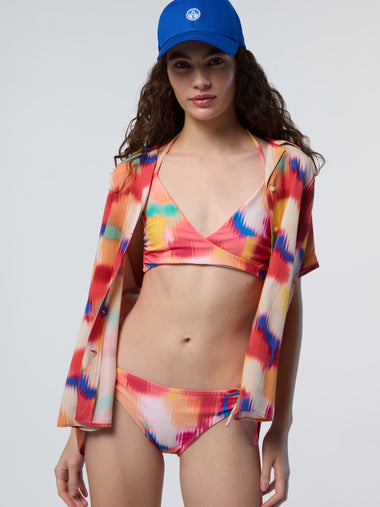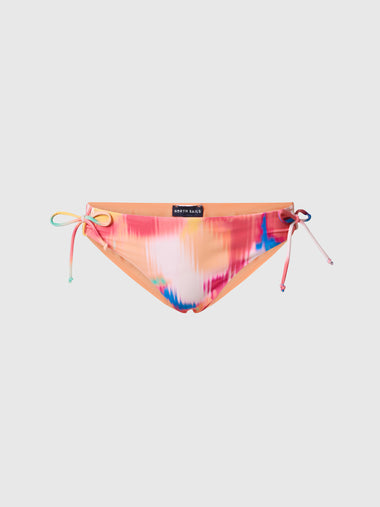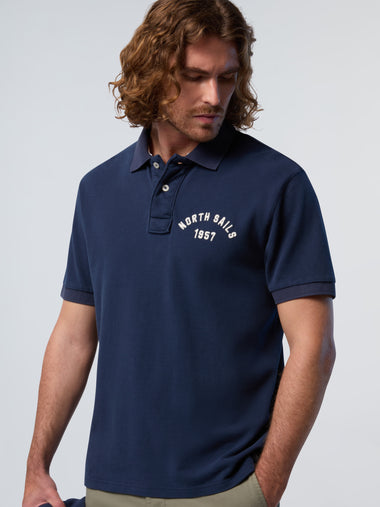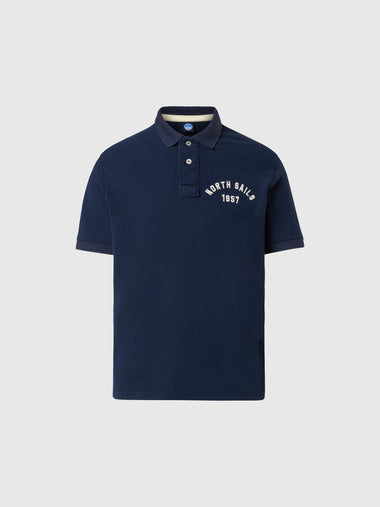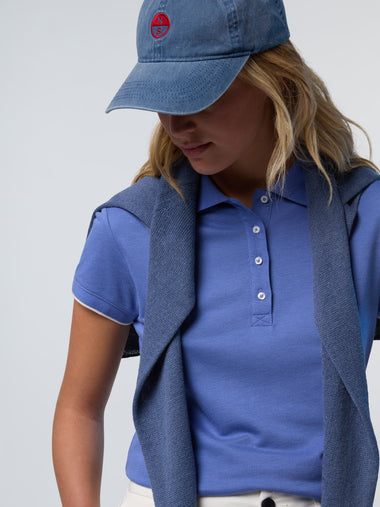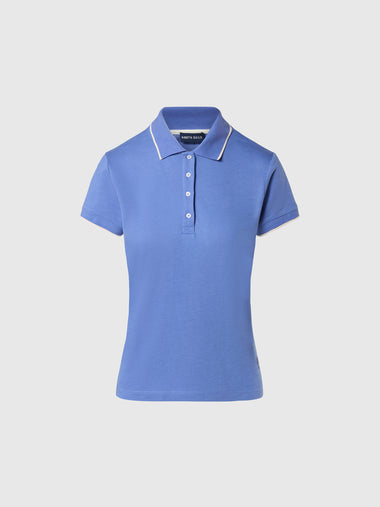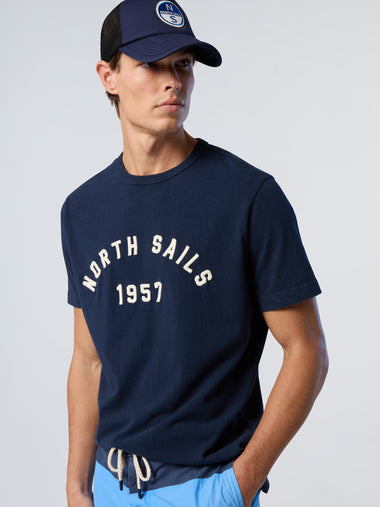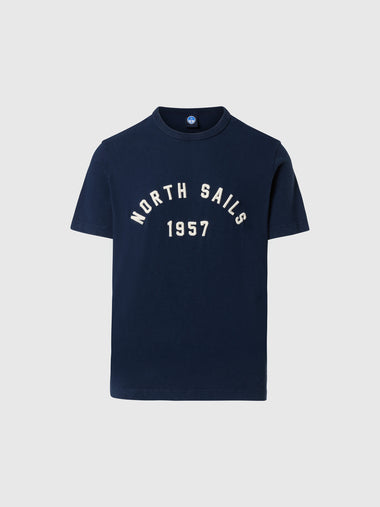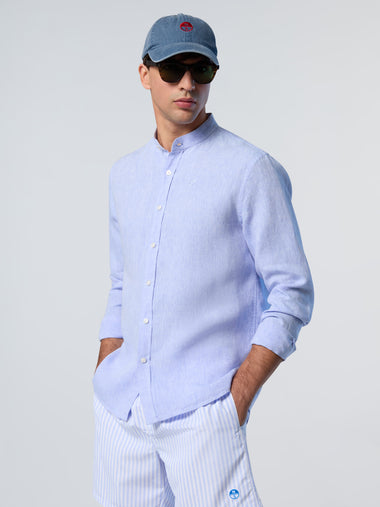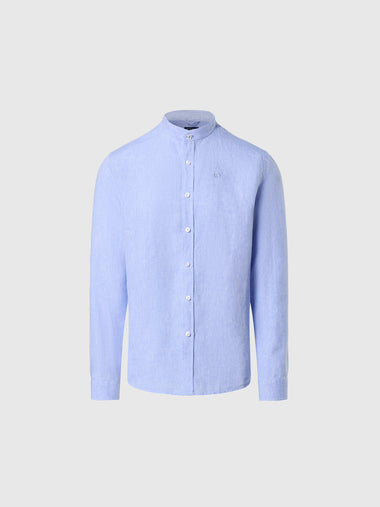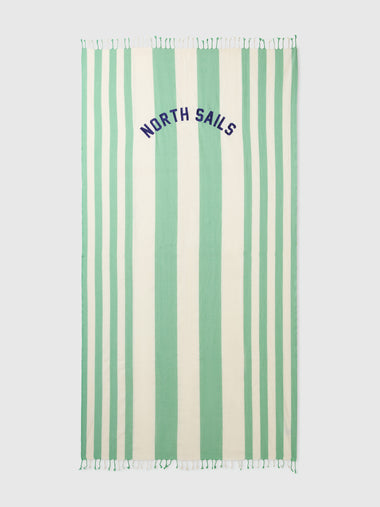NORTH SAILS BLOG
Alle
Events
Guides
News
People
Podcast
Sustainability
Tech & Innovation
Travel & Adventure
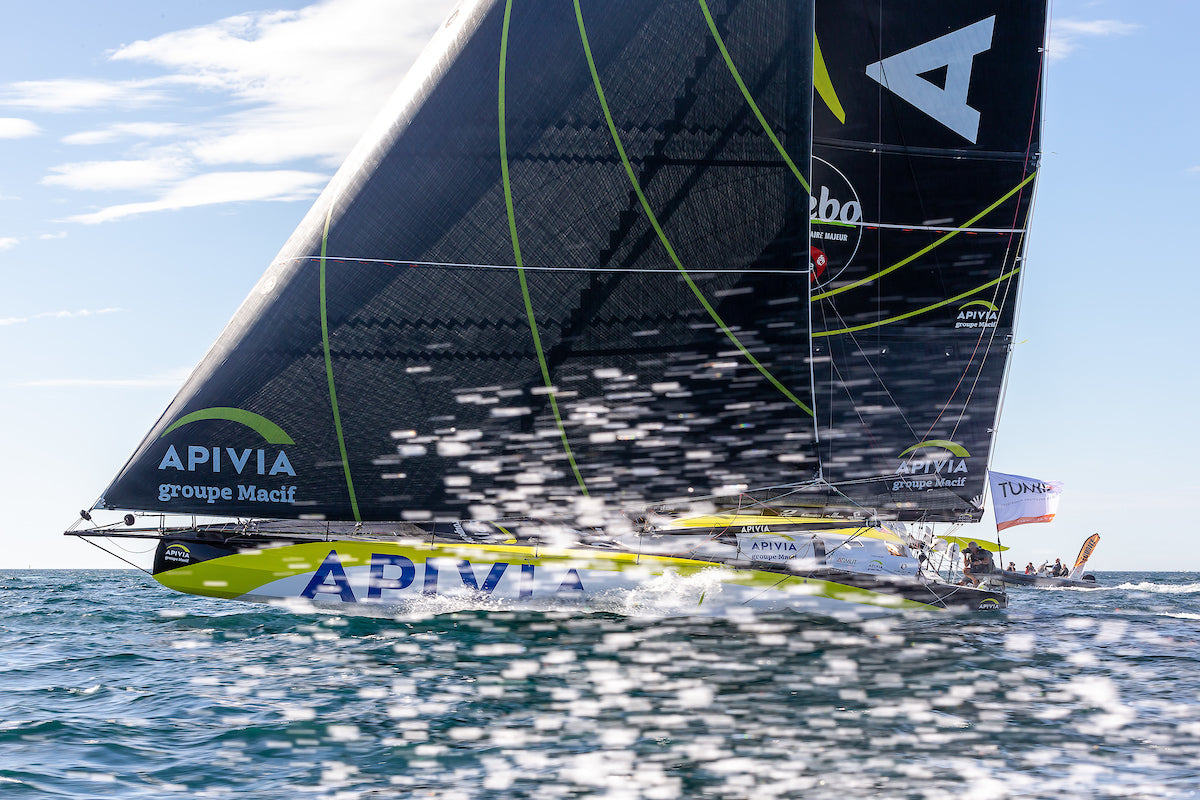
CODE SAILS DEFINED
CODE SAILS DEFINED
What Is A Code Sail?
The term ‘Code Sail’ means different things to different sailors. What started out as an innovative and straightforward concept has rapidly evolved into a whole new category of sails. While Code Sails may look and perform quite differently from one another, there is one common theme: Code Sails are fast, flat, free-flying sails, designed for close reaching angles.
To understand all the different names and versions, it may help to look back at the origin of these sails. Originally “Code Zeros” were designed to qualify as spinnakers under various rating rules that require the mid-girth to be 75% of the foot length. Volvo Ocean Racers coined the term Code Zero, which fit into the established North Sails coding convention: A1, A2, A3, etc. This design also became popular among handicap racers under Rules like IRC, ORR, and PHRF. As their effectiveness and ease of use became increasingly apparent, Code Sails expanded into cruising as well, and multihull sailors coined the term “Screechers” for their similar, specialized, high-performance reaching sails.
Code Sails add a great deal of sail area and power for close reaching angles. Boats with non-overlapping headsails see the biggest benefit from Code Sails, as they better fill the inventory gap between upwind headsails and downwind spinnakers.
REQUEST A QUOTE CONTACT YOUR LOCAL EXPERT LEARN MORE ABOUT CODE SAILS
Helix Structured Luff: Code Sails Redefined
While Code Sail is a term used by sailmakers across the board, in recent years North Sails has redefined what it means to have a North Code Sail, with the introduction of its Helix Structured Luff technology.
A design philosophy first introduced for offshore Grand Prix, the performance benefits of Helix have reverberated around the sailing world, making Helix Code Sails the go-to tool for improving aerodynamics and increasing range.
View this post on Instagram
A post shared by North Sails (@north_sails)
With their unique luff structures, Helix Code Sails give sailors another gear, increasing power potential by projecting the sail further forward and optimizing load sharing, for a positive sail shape and enhanced control. They are custom-designed – optimized to react to dynamic sailing loads, easily and efficiently handle torque for furling, and offer load-sharing characteristics suited to a much wider wind angle and wind speed range.
As of January 2022, Helix is now a feature of all North Racing Code Sails. The exact implementation of the Helix Structure varies according to the specific version of Code Sail. When purchasing a Code Sail, your boat’s performance, target wind angles and anticipated wind speeds, your onboard sail handling systems, and the sail material you have chosen are all taken into consideration. Then, the sail is designed around your specific needs.
Helix Code Sails and Mid-Girth Measurements
Note: Some rating/handicap systems strictly limit the available mid-girth specifications of rule-eligible sails, barring sails with mid-girths greater than a headsail’s 50%/less than a spinnaker’s 75% . Other rating systems heavily penalize mid-girths greater than 50%/less than 75%. And other systems attempt to generate accurate ratings with no special consideration given to mid-girths between 50 and 75. Discuss with your North Sails representative the rating system under which you will be racing to determine whether and which any rule restrictions or prohibitions apply.
Helix Code Zero Asymmetric Spinnaker – Mid Girth (SMG) >75%
For systems that disallow mid-girths between 50 and 75%, this sail remains much the same in concept as the original Code Zero. The design requirement is the flattest possible sail with a spinnaker mid-girth of 75%. The challenge of designing and building a Code Zero Asymmetric Spinnaker is meeting the 75% girth measurement while producing a sufficiently flat sail shape with no excess area”flapping” in the wind. Code Zeros carry an unsupported mid-girth sail area that is not aerodynamically efficient for light-air close reaching. Code Zeros can be made in 3Di Downwind or Code style aramid laminates.
Helix Code 50 – Mid Girth (SMG) <54%
North Sails’ newest code sail, the Code 50 is a free-flying sail for offshore racing. Ideally suited to ocean racing Grand Prix yachts such as IMOCAs and Ultime Trimarans, it uses a new 3Di Downwind (RAW) 700 material, uniquely suited to the hybrid requirements of offshore, free-flying sails – exceeding the limitations of standard 3Di Downwind 600, 700 & 800 material.
Helix Code 55 + 65 (SMG 51%-74%)
A Code 55 has a 55% SMG while a Code 65 features a 65% SMG. (SMG is the width of the sail measured at half the sail’s height, expressed as a percentage of foot length). Code Sails with mid-girth between 50% and 75% are highly efficient and versatile sails. However, as noted above, these sails are sometimes treated unfavorably (if not outright banned) by certain rating rules. Where allowed, these Code Sails provide pure reaching performance – ideal for offshore racing, multihull sailing, and performance cruising. A smaller SMG percentage implies a flatter sail for closer wind angles, while a higher SMG percentage implies a slightly fuller sail for wider wind angles. An SMG less than 51% is considered a genoa, while an SMG greater than 74% is considered a spinnaker.
REQUEST A NEW SAIL QUOTE
CONTACT YOUR LOCAL EXPERT
READ MORE
READ MORE
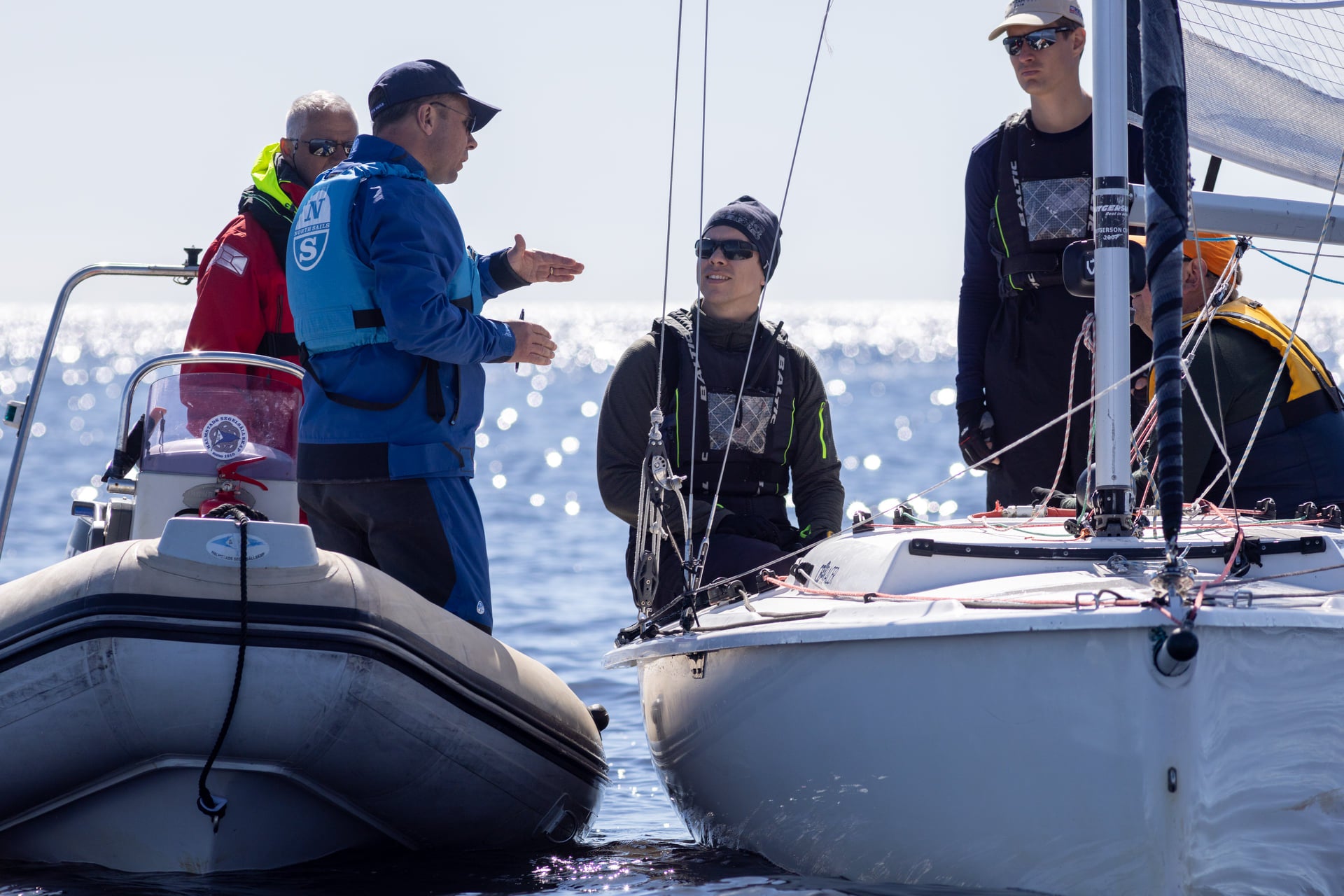
NORTH SAILS TRIM CUP 2022
NORTH SAILS TRIM CUP 2022
Ett Samarrangemang Mellan Halmstad Segelsällskap Och Oss På North Sails
📸 Daniel Stenholm
Sista helgen i april samlades ett tiotal besättningar i Halmstad för att vara med på en kombinerad tränings- och kappseglingshelg. Coacher var Henrik Ottosson och Andreas Turesson från North Sails i Göteborg.
North Sails Trim Cup är ett samarrangemang mellan Halmstad Segelsällskap och oss på North Sails. I år vände vi oss främst till CB66:or men kul nog tog även en lokal J/70-besättning tillfället i akt att haka på.
Vädret gick inte att klaga på. Det var klart och soligt under hela helgen, möjligtvis lite småkyligt ibland, med måttlig frånlandsvind under fredagen och lördagen och lite mer därtill under söndagen.
På programmet stod träning under fredag och lördag förmiddag, och kappsegling under lördag eftermiddag och söndag förmiddag. Planen var att köra ”så många seglingar vi hinner”, och det blev till slut tio genomförda race. Hur det gick är egentligen mindre viktigt. Syftet med helgen var framför allt att seglarna skulle få jobba bort ringrosten och förhoppningsvis få lite nya lärdomar och intryck som de har nytta under den kommande säsongen.
För coachningen stod Henrik Ottosson och Andreas Turesson från North Sails i Göteborg. De fokuserade särskilt på två områden: besättningens placering i båten under olika förhållanden och på olika bogar – en oerhört viktig faktor i lätta sportbåtar som CB66 och J/70 – och samspelet mellan focktrim och storsegeltrim.
📸 Daniel Stenholm
HSS har fina seglingsvatten precis utanför piren, vilket gör det möjligt att på ett effektivt sätt kombinera segling med lunch och genomgångar på land. Varje dag inleddes med dragning i klubbhuset innan båtarna skickades ut på vattnet. Henrik och Andreas åkte runt i var sin RIB-båt och kunde ge snabb feedback. De tog foton och filmer, och detta låg sedan till grund för de uppföljande genomgångarna.
Det var med andra ord ett ganska intensivt program, med två segelpass och tre genomgångar om dagen. Men det är ett trevligt upplägg som ju också ger utrymme för umgänge med seglarkompisar som man kanske inte träffat sedan förra säsongen.
Tack till Halmstad Segelsällskap för ett som vanligt fint arrangemang. Tack också till Hotell Clarion Collection Norre Park, som hade fixat bra priser på hotellrum och som ordnade en väldigt fin regattamiddag på lördagskvällen.
📸 Daniel Stenholm
READ MORE
READ MORE
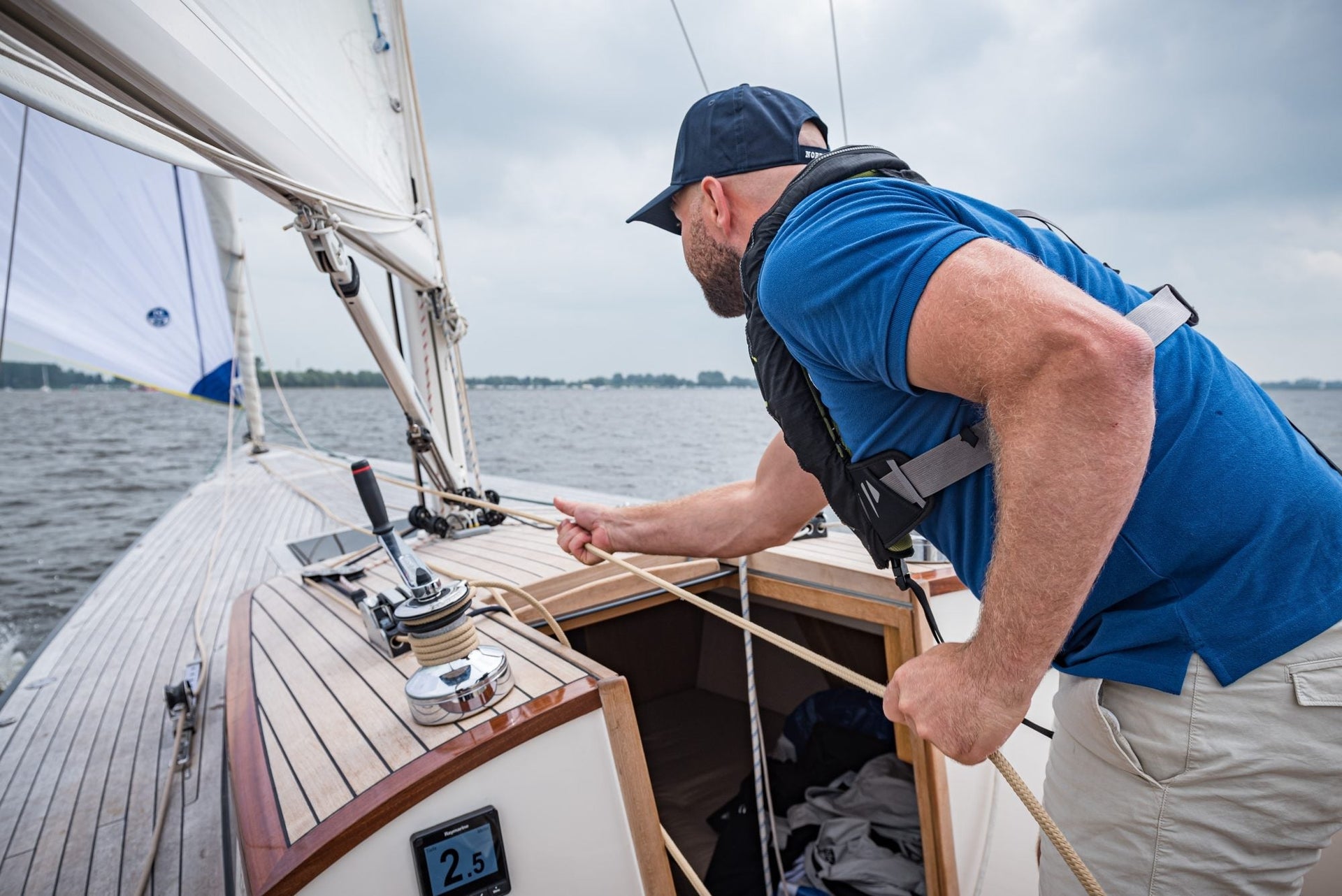
OUR FAVORITE UK CRUISING DESTINATIONS
OUR FAVORITE UK CRUISING DESTINATIONS
Sights Set for Summer Cruising
What makes for a good sailing destination? Sheltered bays, great scenery, cosy pubs, swim spots and good weather. Top it off with a North Sails loft and a chandlery in case of any breakages and you have everything you need. North Sails shares their favorite UK destinations and where you can drop your sails in to be serviced or repaired on your travels.
Wales - Pwllheli
Pwllheli, Abersoch and the Llyn Peninsula in Wales is a protected Area of Outstanding Natural Beauty. It’s said to be the best sailing venue in Wales, one of just four in the UK that are suitable for hosting International Olympic and Youth and Junior class competitions.
Filled with beautiful seaside resorts and friendly yacht clubs such as the South Caernarvonshire Yacht Club in Abersoch, paired with a lovely climate from May-September, it is easy to see why this part of coastline is a magnet for both cruising and racing.
Devon - Plymouth, Dartmouth, Salcombe
If you fancy exploring the South Coast, Devon has lots to offer. With a North Sails representative loft in Plymouth, you are never far from a quick fix or service. Plymouth Sound’s most popular summer anchorage is Cawsand Bay, although it can be a bit exposed in strong south westerly winds.
There is a quieter alternative in Barn Pool, north of the Bridge Reef. Pop ashore for a walk around the Mount Edgecumbe Country Park. Fancy spectating some high performance sailing? Head to Plymouth for Sail GP at the end of July, if you’re not taking part in Cowes Week that is!
If you have more time we also recommend popping around the corner towards Dartmouth and Salcombe. With so many secluded spots and sheltered harbors only a few hours away, you will be spoilt for choice on this dramatic coastline!
Solent - Cowes/Gosport
Home to high performance racing, the Solent is always a great place to hop from one anchorage to another, especially if you are short on time. With Cowes on the Isle of Wight as a base for amenities, yacht clubs and pubs, there are plenty of lovely spots within a few miles to explore.
Surrounded by a nature reserve is the stunning Newtown Creek. Watch out as it can get busy here on weekends, but if you manage a mid-week getaway you may be lucky enough to have it to yourself. The Beaulieu River in the New Forest is sheltered and home to the National Motor Museum if British summer time catches you out with bad weather.
Scotland
Whilst the weather may leave a lot to be desired, Scotland has some of the best cruising waters in the world. Head to the Kyles of Bute and the Isle of Arran for sheltered cruising amongst small islands. For those looking for dramatic scenery, whirlpools and whisky, the Inner Hebrides is the place for you.
If you do decide to venture up to Scotland, North Sails representative Kevin Aitken will be on hand to assist should you need it.
ALL NORTH SAILS LOCATIONS
READ MORE
READ MORE
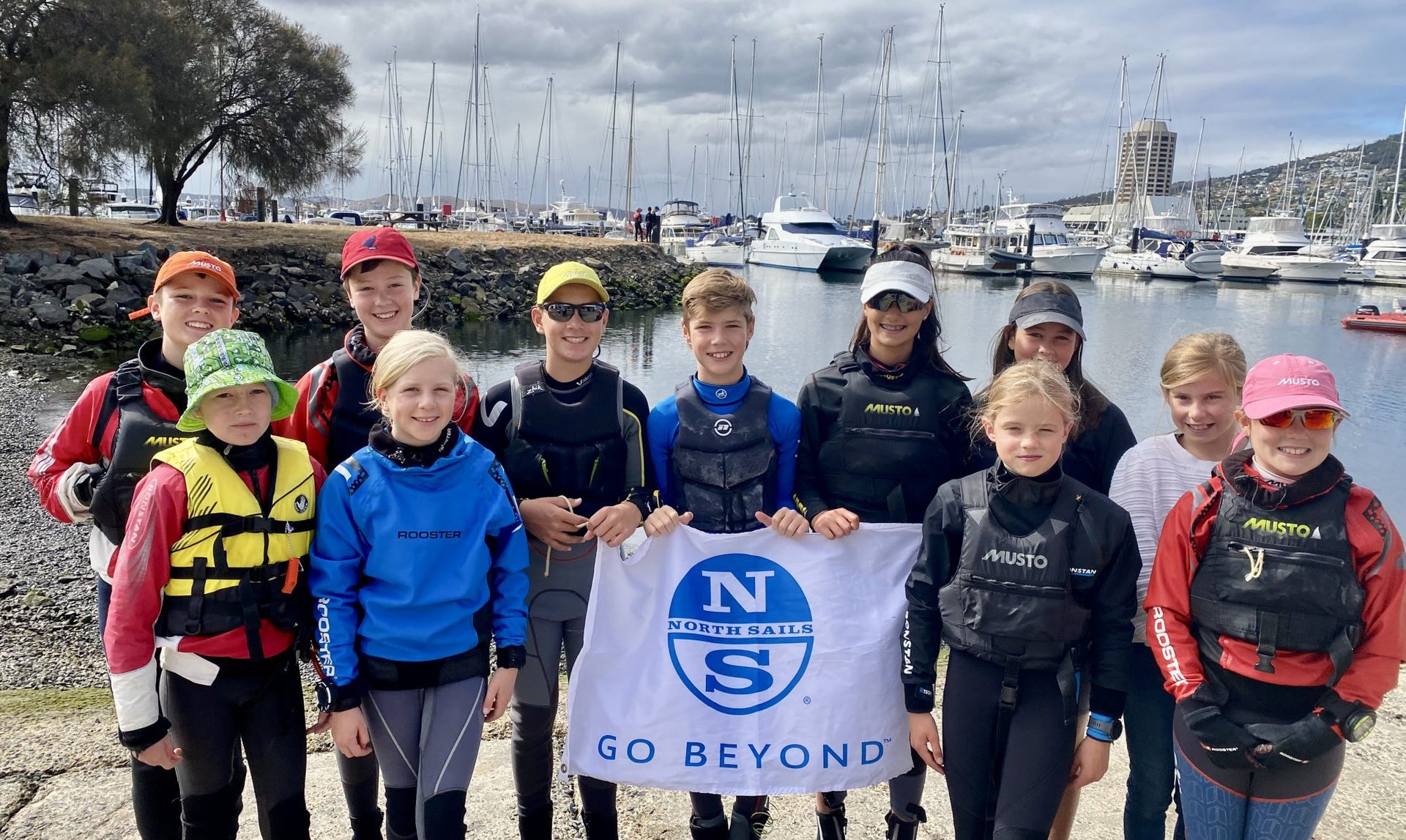
MAKING WAVES FOR THE FUTURE
MAKING WAVES FOR THE FUTURE
North Sails Australia Has Partnered With the Australian Optimist Class
North Sails are proud to support the Australian National Optimist Class, including various state championships across all fleets, with more than 120 young sailors participating in the nationals earlier this year.
“We see this as an opportunity to encourage the younger generation to get out on the water and to stay involved in sailing,” said North Sails Australia’s Sale Manager, Alby Pratt.
“Donating new sails and North Sails vouchers for the National and State Associations to give as prizes is something we were adamant on, in the hope of providing new opportunities for the sailors who may not always be at the front of the fleet.”
“We’re committed to growing junior sailing in Australia with the Optimist class, and hope we can continue that into the future.”
Australian International Optimist Dinghy Association (AIODA) President, Jeremey Atkinson, was excited to bring North Sails onboard as a partner, commenting, “Alby approached us to support the class in 2021, and of course we jumped at the opportunity.”
“It’s unlike any of our other class partnerships and supports all levels of our Optimist sailors, combining at a state and national level, which is a great initiative from North Sails.”
“The AIODA saw this partnership as an opportunity to support Australia’s younger immediate sailors coming up through the ranks.”
Jeremey highlighted that, “one of the best things we’ve benefitted from so far was the coaching day North Sails put on at the 2022 National Championships at Georges River earlier this year. North Sails Expert, Noel Drennan came down and did a class tuning session for the sailors and their parents, and the feedback we’ve received was extremely positive.”
This North Sails initiated coaching session for the Nationals fleet also showcased the newly launched V-Series ranging from the Optimist V-1, V-2 to the V-3 mainsail and the best tuning guide for each skill-level sailors.
“We’re looking forward to this highlight at the next Australian Championships at Royal Prince Alfred Yacht Club for the 2022/23 nationals in January next year” Jeremey finished.
In addition to the coaching support, the North Sails sponsorship includes a three year partnership with the Australian Optimist Class to present two new sails and two North Sails vouchers for the national titles, while one new sail and vouchers will be gifted to all state titles as well.
The North Sails team has a long tradition of promoting grassroots fleets around Australia. Our network of one design experts and dealers are available to help you get the most out of your sails so you can reach your goals anytime you’re on the water.
READ MORE
READ MORE
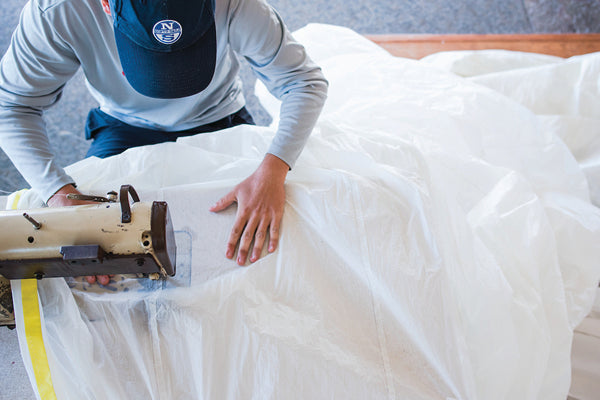
NORTH SAILS AT YOUR SERVICE
NORTH SAILS AT YOUR SERVICE
Upcoming Regatta Repair Schedule
North Sails Certified Service Experts will repair your sails overnight. Our Service van is on-site at select events, offering regatta venue pick-up and drop-off. Tears happen, but they shouldn’t leave you without a key piece of race inventory. Look our for our North Sails Certified Service Experts at the following regattas this season.
*Local service expert for these events will be Kelsey Tostenson. 510-334-0203
EXPRESS NATIONALS
May 20-22
Location: Richmond Yacht Club
ALDO ALESSIO/SWIFTSURE REGATTA
August 19-21
Location: St. Francis Yacht Club
ROLEX BIG BOAT SERIES
September 15-18
Location: St. Francis Yacht Club
J105 NORTH AMERICANS
September 29 - October 3
Location: St. Francis Yacht Club
Talk To A Service Expert
READ MORE
READ MORE
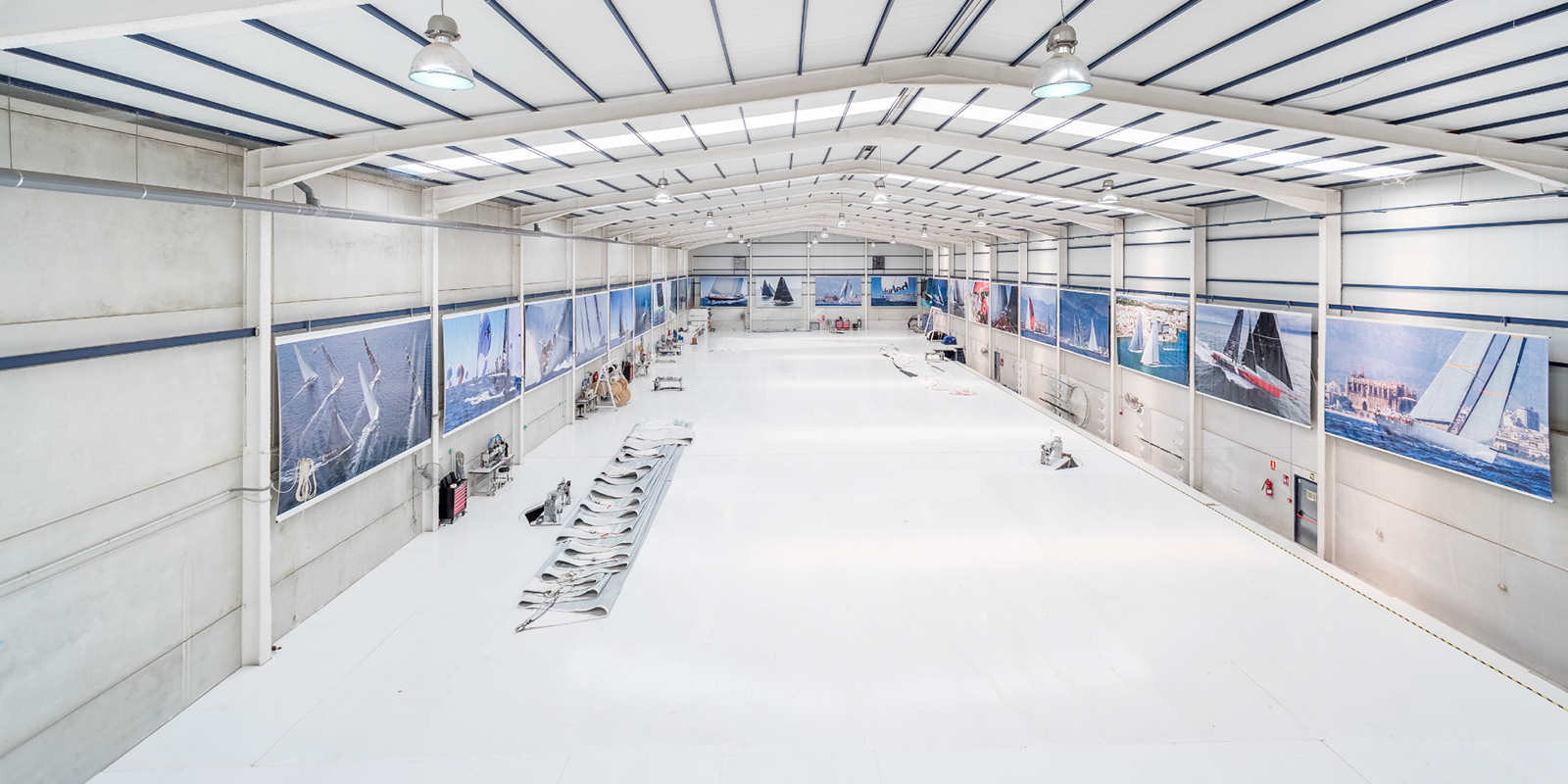
NORTH SAILS EXPANDS PALMA SALES AND SERVICE FACILITY
NORTH SAILS EXPANDS PALMA SALES AND SERVICE FACILITY
One All Purpose Site Elevates Customer Service to Unprecedented Levels
📸 Ian Roman
Palma, Mallorca Spain, April 21 2022 – North Sails has strategically relocated all their sales and service into one Palma location. Effective immediately the secondary loft space in Llucmajor is closed with all loft functions now concentrated within the Palma loft, located minutes from Palma Harbour and the closest facility to STP (Servicios Técnicos Portuarios) where North Sails also boasts a dockside office. The Palma loft has doubled in size by obtaining the space adjacent to the current structure and creating a mirror image of the existing loft space. The newly configured space is now Palma’s largest dedicated sailmaking and service facility.
According to Quinny Houry, Site Manager, “the consolidation of the two loft sites in Mallorca into one 4,720m/sq site with 700m/sq of sail storage just 10 minutes from the water has enabled us to focus on client care and raise it to a level that is unprecedented in the industry.”
North Sails Palma houses over 30 experts including sail designers, sailmakers and service professionals in a one-stop full-service centralized location. Loft services aim to provide a unique customer experience that include concierge-style sail removal and installation, sail design service, emergency repair, dedicated pick up and delivery services and year-round sail storage. With support available 365 days a year and an extremely convenient location the new loft layout raises the standard of excellence in sail care and customer service for sailors in Europe. “Expanding into the one building to combine the team’s expertise and utilize a more effective and efficient layout. The new loft set up offers unrivaled access to world-class sales and sail care professionals for superyachts and local yachtsmen alike,” says Brad Favelle, Operations Manager.
North Sails Palma
Poligono Industrial Son Morro,
Carrer Ca Na Melis, 11a,b,
07007 Palma, Balearic Islands
CONTACT NORTH SAILS PALMA
📸 Ian Roman
READ MORE
READ MORE
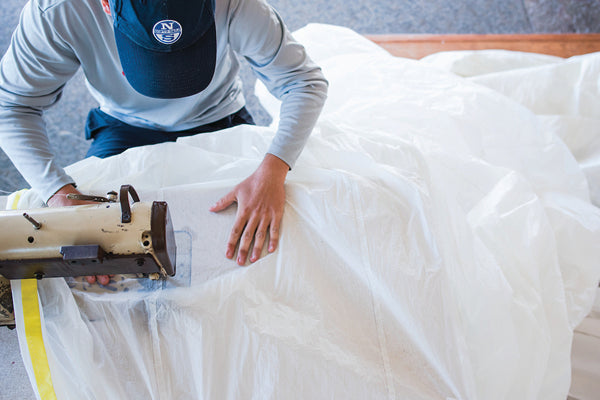
NORTH SAILS AT YOUR SERVICE
NORTH SAILS AT YOUR SERVICE
Upcoming Regatta Repair Schedule
North Sails Certified Service Experts will repair your sails overnight. Our Service van is on-site at select events, offering regatta venue pick-up and drop-off. Tears happen, but they shouldn’t leave you without a key piece of race inventory. Look our for our North Sails Certified Service Experts at the following regattas this season.
*Local service expert for these events will be James Hobson. +44 7557 941069
ROYAL SOUTHERN YACHT CLUB NORTH SAILS MAY REGATTA
May 7th & 8th
VICE ADMIRALS CUP
May 20th & 22nd
IRC NATIONAL CHAMPIONSHIP
June 10th & 12th
J CUP
June 30th - July 2nd
COWES WEEK
July 30th - August 5th
ETCHELLS WORLDS
September 18th - 24th
ROYAL SOUTHERN YACHT CLUB SEPTEMBER REGATTA
September 24th & 25th
Talk To A Service Expert
READ MORE
READ MORE
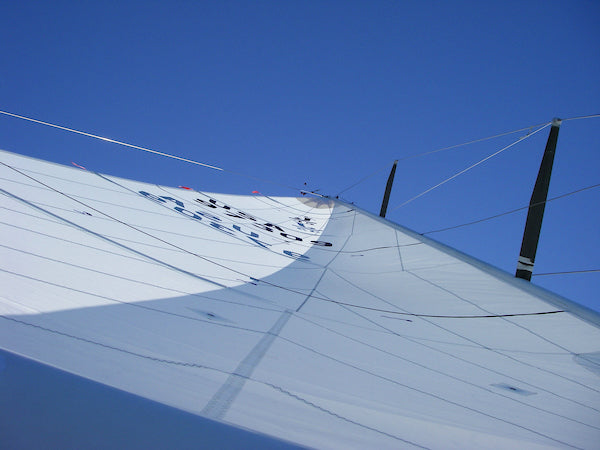
OCCASIONSLISTE
OCCASIONSLISTE
Gebrauchte- und Lagersegel von North Sails Schweiz
Hier geht es zur aktuellen Liste:
OCCASIONS SEGEL
READ MORE
READ MORE
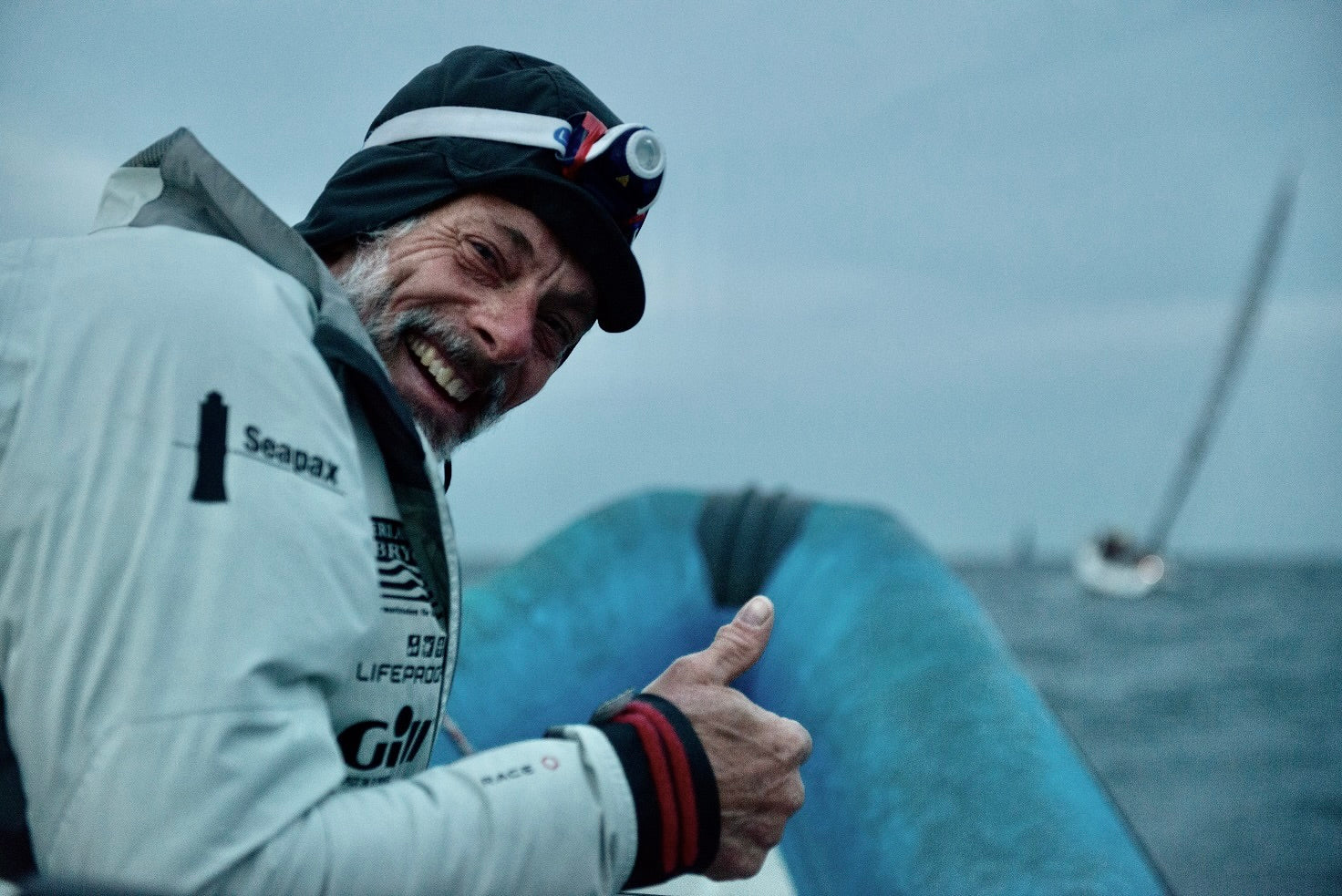
VÄLKOMMEN TILL NORTH SAILS OFFSHORE CLINIC 2022
VÄLKOMMEN TILL NORTH SAILS OFFSHORE CLINIC 2022
13-15 maj har du chansen att drillas av vår egen Anders Lewander. På schemat: Allt från fartträning till nattsegling och man-över-bord-träning
North Sails Offshore Clinic genomfördes första gången 2018 och har blivit något av en tradition för havskappseglare som vill skaka ringrosten ur kroppen och få några dagars intensiv träning innan kappseglingssäsongen drar igång på allvar. Nytt för i år är att vi vänder oss till såväl fullcrew- som shorthandedseglare.
Förra årets upplaga präglades av pandemin men i år körs evenemanget utan begränsningar, så du kan dessutom se fram emot ett trevlig socialt program med bland annat morgongympa, gemensamma måltider och bastubad.
Träningshelgen genomförs 13-15 maj utanför Sandhamn av North Sails och Svenska Havskappseglingsförbundet i samarbete med KSSS. Träningen leds, som brukligt, av Anders Lewander från North Sails Stockholm.
Clinicen vänder sig främst till ambitiösa havskappseglare och syftet är att på ett strukturerat sätt ta oss an de delar som är viktiga för att prestera på ett internationellt mästerskap.
På programmet står bland annat startträning, banracing, nattsegling och man-över-bord-träning. Dessutom fartträning på både kryss och öppna bogar med lätta skot. Det gör det till ett gyllene tillfälle att exempelvis testa stagsegel eller få ett bra underlag för att uppdatera segelvalstabellen eller polardiagrammen.
Vill du vara med?
En formell inbjudan med detaljerat program finns på Svenska Havskappseglingsförbundets hemsida. Maxantalet är satt till tjugo båtar, så vänta inte för länge med att anmäla dig.
READ MORE
READ MORE
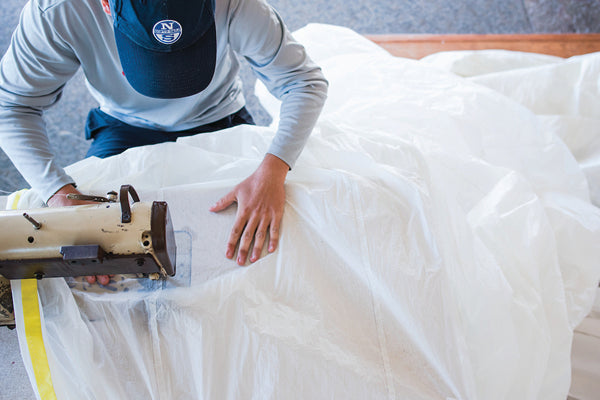
NORTH SAILS AT YOUR SERVICE
NORTH SAILS AT YOUR SERVICE
Upcoming Regatta Repair Schedule
North Sails Certified Service Experts will repair your sails overnight. Our Service van is on-site at select events, offering regatta venue pick-up and drop-off. Tears happen, but they shouldn’t leave you without a key piece of race inventory. Look our for our North Sails Certified Service Experts at the following regattas this season.
*All pickups will be 4:30-5:30pm and drop offs will be 7:30-8:00am.
NYYC ANNUAL REGATTA
June 10-11
Location: Sail Newport, The Alofsin Piers
NYYC RACE WEEK AT NEWPORT
July 13-15
Location: Sail Newport, The Alofsin Piers
SAFE HARBOR RACE WEEKEND
August 12-13
Location: Safe Harbor Newport Shipyard
12 METRE NORTH AMERICANS
September 15-17
Location: Sail Newport, The Alofsin Piers
IC37 NORTH AMERICANS
September 22-24
Location: Sail Newport, The Alofsin Piers
Talk To A Service Expert
READ MORE
READ MORE
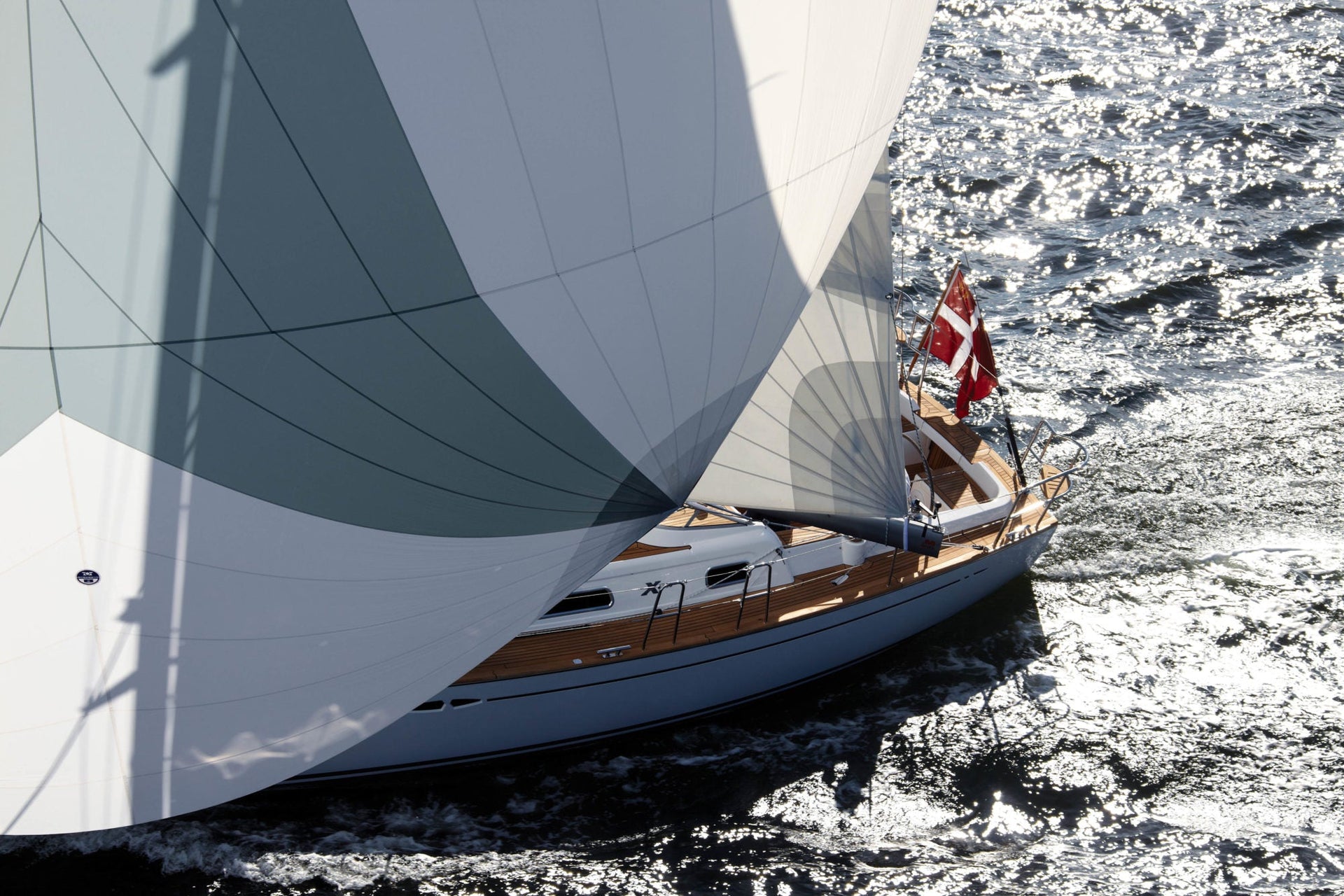
HOW TO HOIST AND DOUSE A GENNAKER OR SPINNAKER
CRUISING DOWNWIND
Feel the Power of Simplicity
Spinnakers provide an enormous performance boost in light to moderate air when sailing downwind—and well they should, considering the trouble they can cause! We’ll take a look here at how to handle and trim both cruising spinnakers—also called Gennakers, which fly without a pole—and conventional spinnakers with poles.
Setting a Gennaker
A cruising spinnaker or Gennaker is set with a tack line from the bow, a halyard, and a sheet led to the aft quarter. For shorthanded sailing, a spinnaker Snuffer is recommended. The sail is hoisted within a protective sock, and once up, the Snuffer line is pulled to retract the sock and free the sail. To prevent twisting, the tack line should be tightened prior to the hoist. Do you need a tack strap? Depending on the luff length of the Gennaker, it may also be advantageous to rig a tack strap. Rigged around the rolled jib, the tack strap prevents the tack from wandering. If your sail has a long luff and a low tack—just above the bow pulpit—then a tack strap is not required. For a sail with a short luff and a high tack, a tack strap adds control. The Gennaker sheets can be lead inside or outside the Gennaker luff. There are advantages to each set up, and both work.... you’ll have to experiment to see which works better on your boat, and the best option may vary with the wind strength.
Setting a Spinnaker
Conventional spinnakers with spinnaker poles offer more control over spinnaker trim and sail shape, which can increase performance—but it comes at the price of additional complexity. For shorthanded sailing, a Snuffer is recommended, though the setup and hoist steps are the same with or without it. First, rig the pole with a topping lift—to hold the pole up—and a foreguy—to pull the pole forward. Some skippers also rig an afterguy directly to the pole to hold the pole back. Others allow the spinnaker guy to handle this function. You can sail safely and successfully either way, though before and after the spinnaker is deployed, the pole will not move around as much if a separate afterguy is rigged. Either way, the windward spinnaker sheet—called the guy —is rigged to run through the end of the pole. Once the sail is rigged and ready, trim the guy to pull the tack of the spinnaker to the end of the pole, and then hoist. As you reach full hoist, take slack out of the sheet to prevent twists, and then raise the Snuffer. When the Snuffer tops up, tie off the Snuffer lines loosely near the mast base, and trim the spinnaker sheet.
Gennaker Takedowns
To take the sail down, turn to a very broad reach to hide the Gennaker behind the mainsail, ease the sheet until the sail carries a big curl, and pull the Snuffer down over the sail. Once the sail is snuffed, lower the halyard and stuff the sail into its bag on deck, or pass it down the forward hatch to be bagged below. Sit Down One important safety detail when shorthanded and working on the foredeck: Sit down while you pull the sail down. If you sit, you can’t fall. When gathering a sail on a rolling boat, lurching around and stepping on slippery sail cloth, it is easy to fall down—or even overboard. Feel free to take a seat!
Dousing the Spinnaker
To douse the spinnaker, reverse the hoist sequence: turn to a broad reach, ease the sheet, pull down the Snuffer, ease the guy, and lower the halyard. In stronger winds, hiding the spinnaker behind the main will make the snuffing process easier. Once again, the process starts on a broad reach. Rather than ease the sheet, though, put a loop of line around the sheet, and use this “choker” to pull the clew of the spinnaker in close behind the mast. Ease the guy to luff the spinnaker, and pull down on the Snuffer. By pulling the leech of the spinnaker in close behind the main this technique assures that the spinnaker will be blanketed behind the main. As always, sit down on deck while pulling down the Snuffer.
📸 Amory Ross
READ MORE
READ MORE
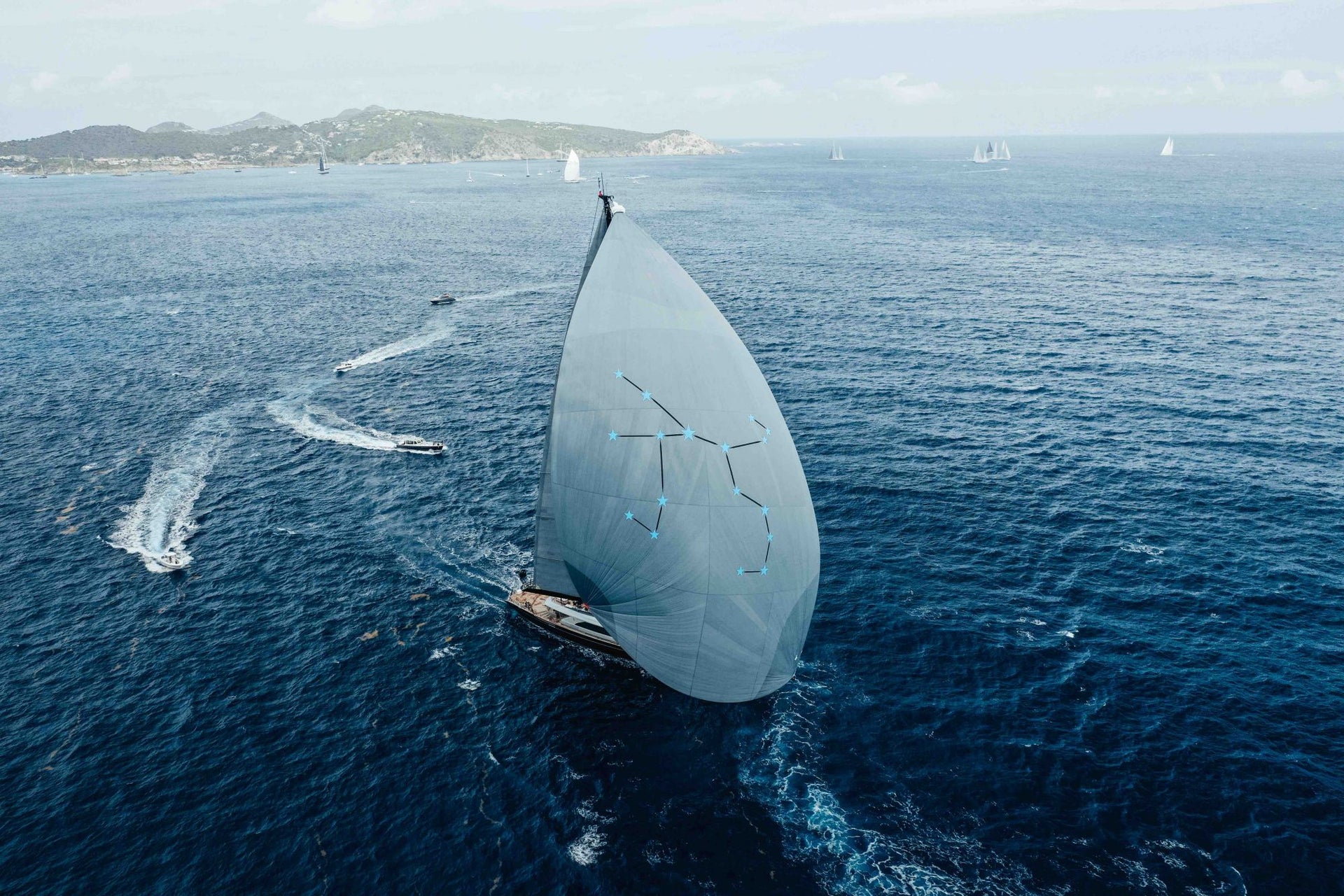
SÅ SKAPADES VÄRLDENS STÖRSTA SEGEL
SÅ SKAPADES VÄRLDENS STÖRSTA SEGEL
Få en inblick i designerns, duktillverkarens och segelmakarnas arbete med Perseus^3:s nya gennaker – som är stor som tio tennisplaner.
📸 Ryan Borne
”Det är väsentligt större än allt annat där ute”, säger Glenn Cook. Han är designer av segel till superyachts och ringer från St Barth, där han testseglar seglet för allra första gången. Det är en process som han beskriver som både ”nervpåfrestande” och ”den bästa delen av jobbet”. Att utveckla och producera detta 2604 kvadratmeter stora A2-segel har nämligen krävt en massa människors medverkan, en massa tid och en massa resurser.
Processen har krävt ett omfattande arbete av ett designteam i USA och en specialbeställd duk som det tog Contender Sailcloth åtta veckor att få fram. Och själva produktionen tog mer än 15 dagar för tio segelmakare.
”Teamet bakom båten var uttryckligen ute efter ett segel som skulle prestera väl i förhållande till mätetalet”, förklarar Cook. ”Så designen fick styras av det. Och eftersom Perseus^3 är en väldigt stor båt (hon är 58,6 meter lång), svarar hon inte så snabbt på roderrörelser. Även justeringar i trim tar sin tid. Så det vi siktade på var ett segel med en väldigt stabil flygande form. Dessutom måste seglet kunna fungera i ett brett spektrum av förhållanden. Vi har därför gjort en mer förlåtande design än vad vi brukar göra till mindre båtar.”
De hanteringsmässiga utmaningarna var också en faktor som påverkade designen; förliket är så långt att seglet kan hamna i vattnet under gipparna. ”Vi utvecklade ett system ovanför halshornet som samlar ihop underdelen av seglet och förhindrar att det går i vattnet under en gipp.”
Grundmaterialet i seglet är Contender Sailcloths Supercote 350 – den tyngsta och starkaste duk de har – i kombination med Supercote 250 i förstärkningarna, vilket sparar lite vikt.
”Båten är gigantisk och genererar exceptionellt höga krafter”, tillägger Duncan Skinner, chef för Contender Sailcloth USA. ”Vi går från en duk som väger 32 gr/kvm till något som väger 150 gr/kvm, räknat på den Supercote 350-duk som används i den här gennakern. När vikten går upp ökar även styrkan, och det är det som krävs för ett segel i den här storleken.”
”Val av fiber är det första steget – det blev en höghållfast nylon. Därefter tittar vi på konstruktionen, exempelvis hur många fibertrådar vi ska väva in i varje riktning. När så duken är vävd kommer finishen in, och det är en knepig uppgift. Du måste färga duken innan du lägger på finishen. I finishen lägger vi på en coating som stabiliserar duken och tar ner porositeten till noll. Det är en väl beprövad kemisk process som resulterar i dukar som kan hantera den typ av krafter som uppstår på dessa gigantiska båtar.”
Skinner ler. ”Den här saken är verkligen stor!”
Det går åt många rullar duk till ett sådant här segel, och jämn kvalitet i produktionen är en nyckelfaktor för att seglet ska prestera på ett bra sätt utan lokala variationer. ”I dessa stora spinnakers är duken konstruerad på ett sätt som gör att den får lite inbyggd elasticitet. På så sätt leds inte stora chocklaster vidare genom riggen och ner till själva båten – seglet absorberar en del av kraften.
Det som skapade mest huvudbry var, kanske något förvånande, seglets specialbeställda grå kulör. ”Färgningen var det som tog längst tid, eftersom det inte är möjligt att färga så mycket material på en och samma gång. Maskinerna är helt enkelt inte så stora. Så du måste vara väldigt uppmärksam på blandningen av färgen och hur länge den får dränka in… men när du tittar på det färdiga seglet så ser du att vi har kommit väldigt nära! Och det underlättade väsentligt för Manuel när han skulle sätta samman själva seglet.
Manuel Lastra och North-loftet i Cuntis i norra Spanien var sista delen i detta stora pussel. ”Det tog ungefär åtta veckor innan vi fick allt material”, säger Lastra över telefon, och berättar att de beställde 400 löpmeter extra duk, detta för att vara säkra på att kunna göra en bra färgmatchning i seglet.
Totalt fick han och hans team 3323 löpmeter nylonduk, fördelat på 48 rullar, skickat till sig, plus ytterligare 500 löpmeter av den tunnare Supercote 250-duken. Med 3500 kvadratmeter duk fördelat på tre stora golvytor kunde Lastras team steg för sten montera ihop de olika sektionerna. För att få plats på skärbordet gjordes seglets undre del av fyra sektioner, istället för som brukligt två. ”Det tog fem dagar för två personer att skära ut våderna”, säger Lastra. När det var färdigt sorterades de 850 våderna i olika grupper och monterades ihop i sektioner. Därefter gick de genom symaskinerna.”
De olika sektionerna syddes ihop separat. Sedan monterades de ihop och hornförstärkningarna sattes på plats. ”Det tog tio dagar för tio personer. Parallellt jobbade två personer med det grafiska mönstret.”
”När seglet var färdigt fick det torka i fyra dagar innan det veks ihop och skickades till Antigua.”
Och det var på den närliggande karibiska ön St Barth som vi fick tag på designern Cook just som han höll på med sina segeltester.
”Jag är här nere den här veckan och seglar St Barths Bucket Regatta med dem. Det krävdes 16 personer för att packa upp seglet och montera det i spinnakerstrumpan.”
Seglet väger in på 550 kilo. Försökte han lyfta det?
”Det kan vi inte!” skrattar han. ”Vi använder vinscharna ombord. Vi kan släpa det, men det krävs tio till femton personer för att rubba det.
”Det är stort.”
READ MORE
READ MORE
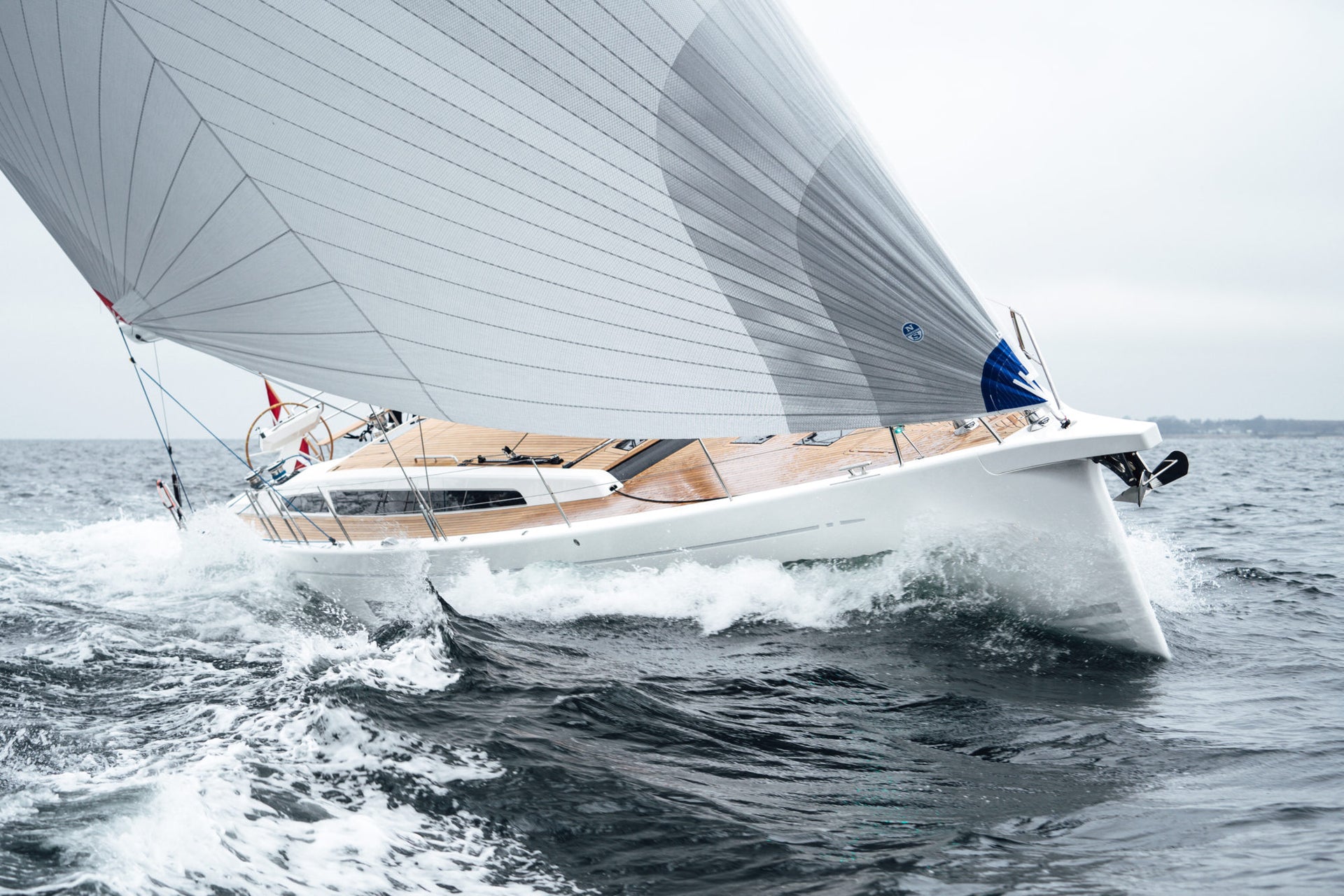
HOW TO' VIDEO SERIE MED BOUWE BEKKING
'HOW TO' MED BOUWE BEKKING
En video-serie i 7 dele til cruisere
Vi har slået os sammen med vores venner hos X-Yachts og er stolte over at kunne præsentere en helt ny 'How To' video-serie tilegnet alle slags cruisere. Alle syv videoer er live og kan ses på North Sails YouTube kanal.
Den professionelle hollandske sejler og 8 gange Volvo Ocean Race veteran, Bouwe Bekking, deler ud af sin viden og erfaring ombord på en X-Yacht i selskab med North Sails Ekspert Jesper Feldt. Bekking taler os igennem de vigtigste aspekter af tursejlads, fra bådmanøvre til trimning af alle sejl i sejlgarderoben.
Videoerne er filmet på Øresund henover sommeren og indeholder tips og tricks til håndtering af en cruising båd fuldt udstyret med North 3Di ENDURANCE.
READ MORE
READ MORE
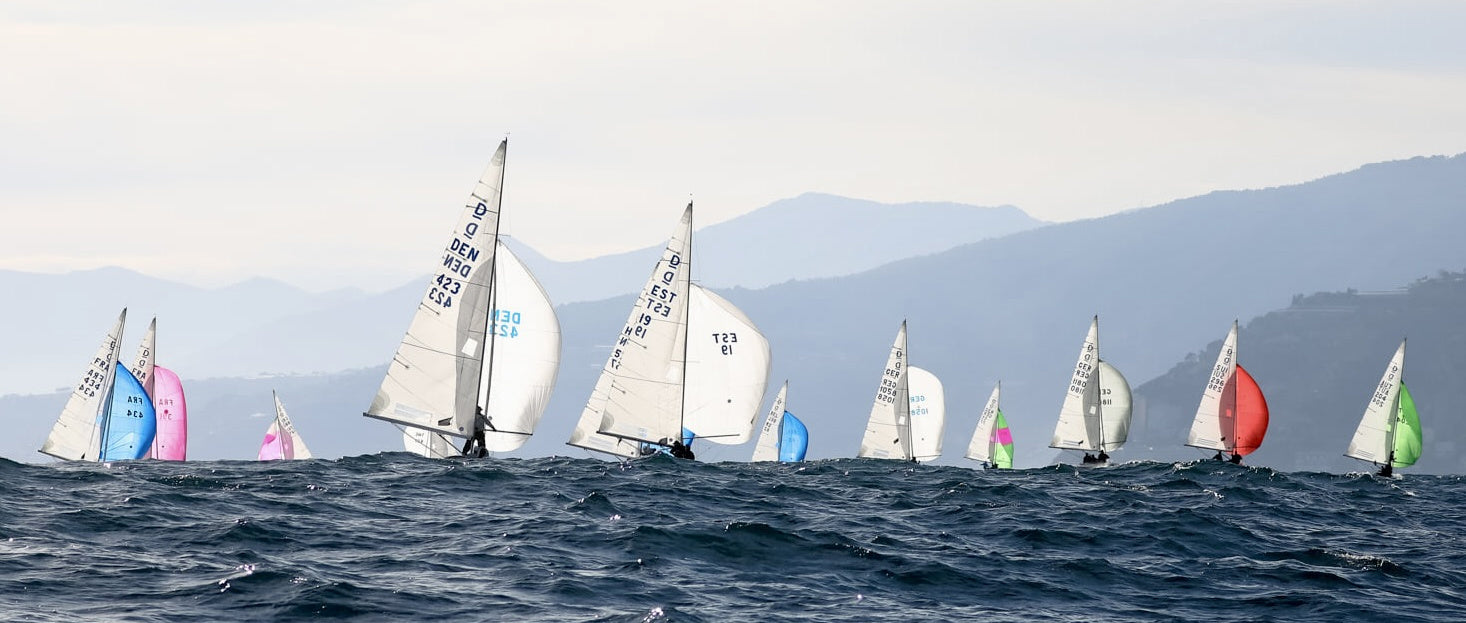
NORTH SAILS CLIENTS DOMINATE DRAGON EUROPEAN CHAMPIONSHIP
NORTH SAILS CLIENTS DOMINATE DRAGON EUROPEAN CHAMPIONSHIP
5- 30 Knots of Breeze - Competitors Faced it all in Sanremo
📸 Sanremo Yacht Club / Elena Razina
A fleet of 63 Dragons from 18 countries raced in Sanremo, Italy, to determine the 2022 European Champions. Crowned after five races are Wolf Waschkuhn and his team Charles Nankin and North Sails expert Ruairidh Scott (SUI 318).
With Wolf at the helm and Charles trimming the genoa and spinnaker following their regatta win, we caught up with Ruairidh, mainsail trimmer, and tactician onboard to hear how they did it.
Joining the team for the ‘Paul and Shark Trophy’ just three weeks before filling in for Joao Vidina, Ruairidh, Wolf, and Charles raced the Italian Championships (also held in Sanremo) in very windy conditions before going on to race for the European title in the more traditional lighter winds of Sanremo. “Our speed was excellent in the varied conditions we had all week. We raced with the A-14 Mainsail on a standard petticrow mast alongside the V-6L, V-6M and V-6H Genoas. However, we mainly used the V-6M as we were never sure if conditions would change during the race.’’
📸 Sanremo Yacht Club / Elena Razina
“We sailed with lots of twist as the conditions were quite choppy all week. Careful adjustment of the runner and mainsheet ensured we were fast as the wind fluctuated. A key ingredient to our speed throughout the week was the work rate from our headsail trimmer Charles Nankin. He stayed active on the headsail sheet in light, choppy and shifty conditions. When a gust hit, we responded quickly by easing the genoa sheet and trimming back in as the boat pointed higher. The sheet ease allows the boat to accelerate and naturally turn up to point higher, so the result was sailing higher and faster than before. In these conditions, little mainsheet adjustment was required until we were sailing at the new angle, which allowed me to get my head up and look around more often. Charles and Wolf did this very well all week, and the constant communication between them meant we were quick all the time.’’
Between the two regattas, Wolf’s team showed excellent speed in 5 - 30 knots. “Thanks to the nice, big crossovers with the North sail designs," Ruairidh explains, “we were fast even if we were not on the perfect sail for the conditions all the time.’’
Congratulations to all North clients who raced at the Europeans and Wolf, Charles, and Ruairidh for fighting through the pack to finish with the title.
Shop the North Sails winning Dragon sail designs today.
RESULTS
📸 Sanremo Yacht Club / Elena Razina
READ MORE
READ MORE
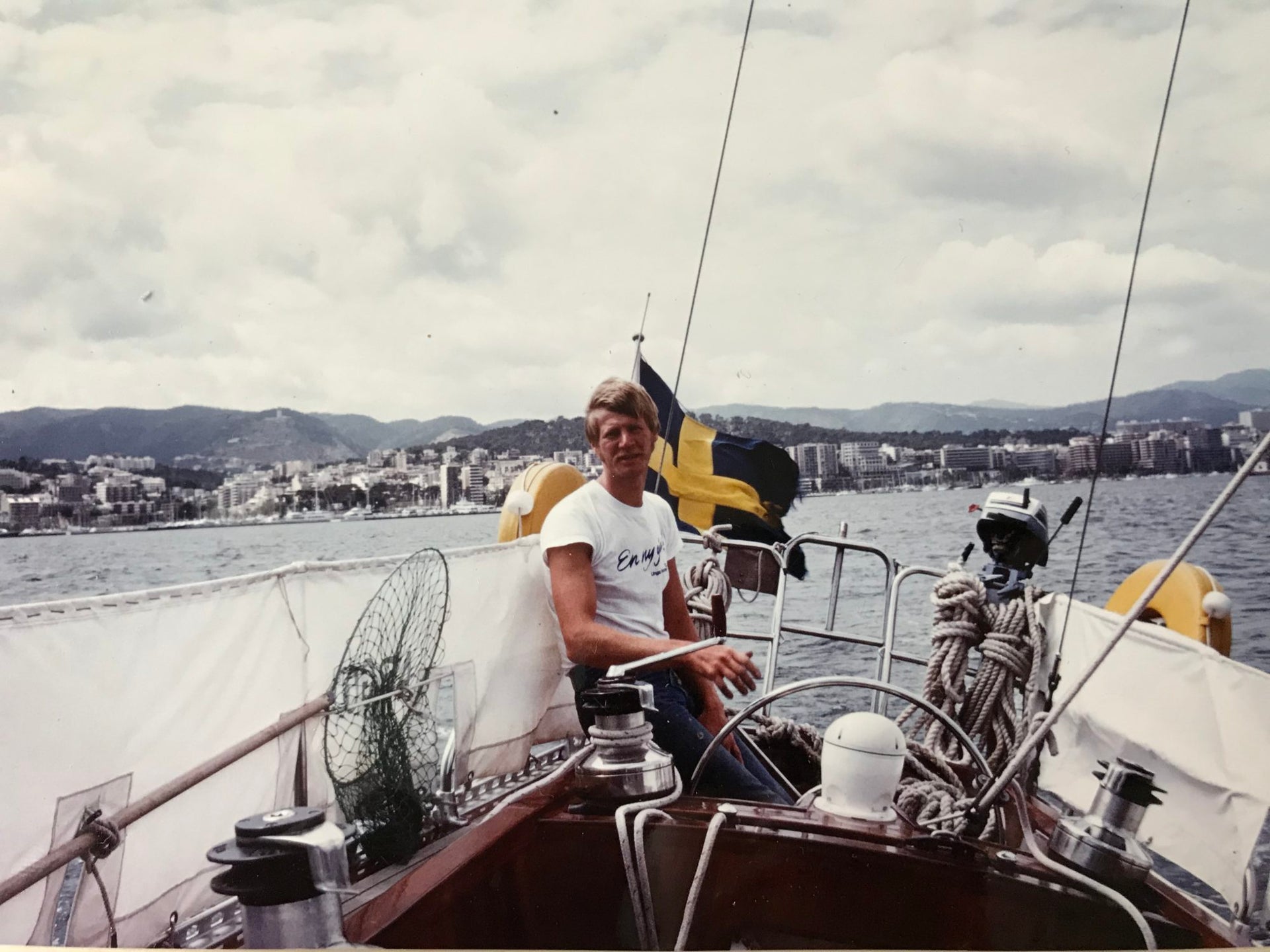
LÄS BERÄTTELSEN OM ARGO: DEL 2 HÄR.
Läs Berättelsen om Argo: Del 2 här
Berättelsen om OPAL 46: AN Argo, och de traditioner som omger henne, fortsätter
Efter många års segling med sin pappa på den älskade skonaren Argo har John Ingvar Ravelius blivit delägare i båten och äger den nu tillsammans med sin bror och sin pappa. Han har uppdaterat och utrustat henne med drömmen om att skapa nya minnen med sin unga dotter och föra familjetraditionen vidare. Här delar Ravelius med sig av andra delen av berättelsen om hur en segelbåt, och det arbete som följer med den, kan knyta samman tre generationer. Läs Berättelsen om Argo: Del 1 här.
Förberedelserna inför den långa seglingen
Efter att ha kappseglat med Argo under två säsonger i Stockholms skärgård, kände sig Ingvar allt mer hemtam ombord. Drömmen om en jorden runt-segling var på att uppfyllas. Men först behövde båten förberedas för den långa resan.
Ingvar hade planerat att segla iväg med en god vän. Någon uttalad destination fanns inte, de skulle bara segla iväg och se vart vindarna förde dem. 1983, innan Ingvar gav sig iväg, träffade han min mamma Leena. Hon var 25 år gammal och hade ingen erfarenhet av segling. Hon hade aldrig ens varit ombord på en segelbåt.
Invar ändrade sina planer och bad min mamma att segla med honom på resan. Hon sa ja, och Ingvar tog nu språnget han väntat så länge på och sålde allting som inte behövdes ombord på Argo, inklusive huset i Sollentuna på vars tomt han hade byggt båten. En eftermiddag lämnade de hamnen i Stockholm med drömmar om varmare breddgrader och utan planer på att återvända.
Deras resa började, och de gick genom Kielkanalen och ut på Engelska kanalen. Min mamma förde dagbok.
21 augusti 1984 – Biscayabukten
I sin dagbok skrev mamma: ”Vinden ökade mer och mer och regnet kändes som vassa nålar i våra ansikten. Vi hade revat seglen och hade en fart på sex knop. Jag kunde höra vinden som ett vrål. Natten var så mörk, och jag kunde inte se en enda stjärna.”
Några dagar senare: ”Loggen visade sex knop när vi seglade fram över havet. Det var ungefär sex sjömil till kusten när loggen helt plötsligt visade noll. Vi undrade om den var trasig. Det kändes fortfarande som sex knop och vi hade vind i seglen. Det visade sig att Argo hade fastnat i ett fiskenät. Vi funderade på vad vi skulle göra. Ingen av oss hade lust att hoppa ner i vattnet och skära loss nätet som fastnat runt båten, så Ingvar och jag väntade och visste inte vad vi skulle göra. Så såg vi en fiskebåt passera oss på ungefär 500 meters avstånd på väg mot hamnen. Vi vinkade åt dem och de såg oss och vände kurs mot oss. Lyckligtvis var de villiga att hjälpa oss, och de skickade över en lång käpp med en kniv fastsatt i ena ändan. Ingvar började skära i nylonnätet men hade ingen större framgång. Till slut klättrade en av fiskarna ombord på Argo. Han vässade kniven och skar loss oss!”
Motorn startade men de hade ingen styrförmåga, de insåg att nätet hade skadat Argos roder. Efter att ha vridit rodret fram och tillbaka lossade till slut delar av nätet från rodret, och de kunde fortsätta sin färd.
När de började färden igen hörde de ett konstigt dunkande ljud och blev rädda att propellern hade lossnat. Senare insåg de att fiskenätet höll sig flytande med hjälp av fotbollar i plast, och att ljudet de hörde uppstod när bollarna slog mot skrovet på ömse sidor av rodret.
Senare på kvällen kom de fram till La Coruna Yacht Club, och besättningen på en fransk båt skrek och vinkade att något hade fastnat på Argo.
Leena och Ingvar skrek tillbaka: ”Ja, vi vet!”, log och vinkade tillbaka, lätt skamsna för det som hade inträffat. De sparade fotbollarna under många år som ett minne. Flera år senare skulle en av dessa röda bollar bli den allra första fotboll som jag sparkade på.
Efter att ha tillbringat en tid i Biscayabukten bestämde de sig för att segla in i Medelhavet, och en vän till familjen bjöd in paret till det hotell som denne ägde på Ibiza. När de passerade Gibraltar och styrde in i Medelhavet visste de inte att Argo skulle bli kvar där de närmaste fem åren eller att Ingvars och Leenas två barn skulle födas där.
Utdrag från min mammas dagbok
Den 5 oktober 1984 skrev Leena: ”Solen lyste på den mäktiga Gibraltarklippan när vi passerade den röda och vita fyren vid Europa Point och satte kurs mot Puerto Banùs. Vi seglade in i Jose Banús Marina med sex knops fart i plattvatten med vinden från sidan och det kändes som att vi flög fram över vattnet.”
Håll utkik efter del 3 och läs om hur mina föräldrar tog hand om ett nyfött barn samtidigt som de seglade omkring i Medelhavet.
READ MORE
READ MORE
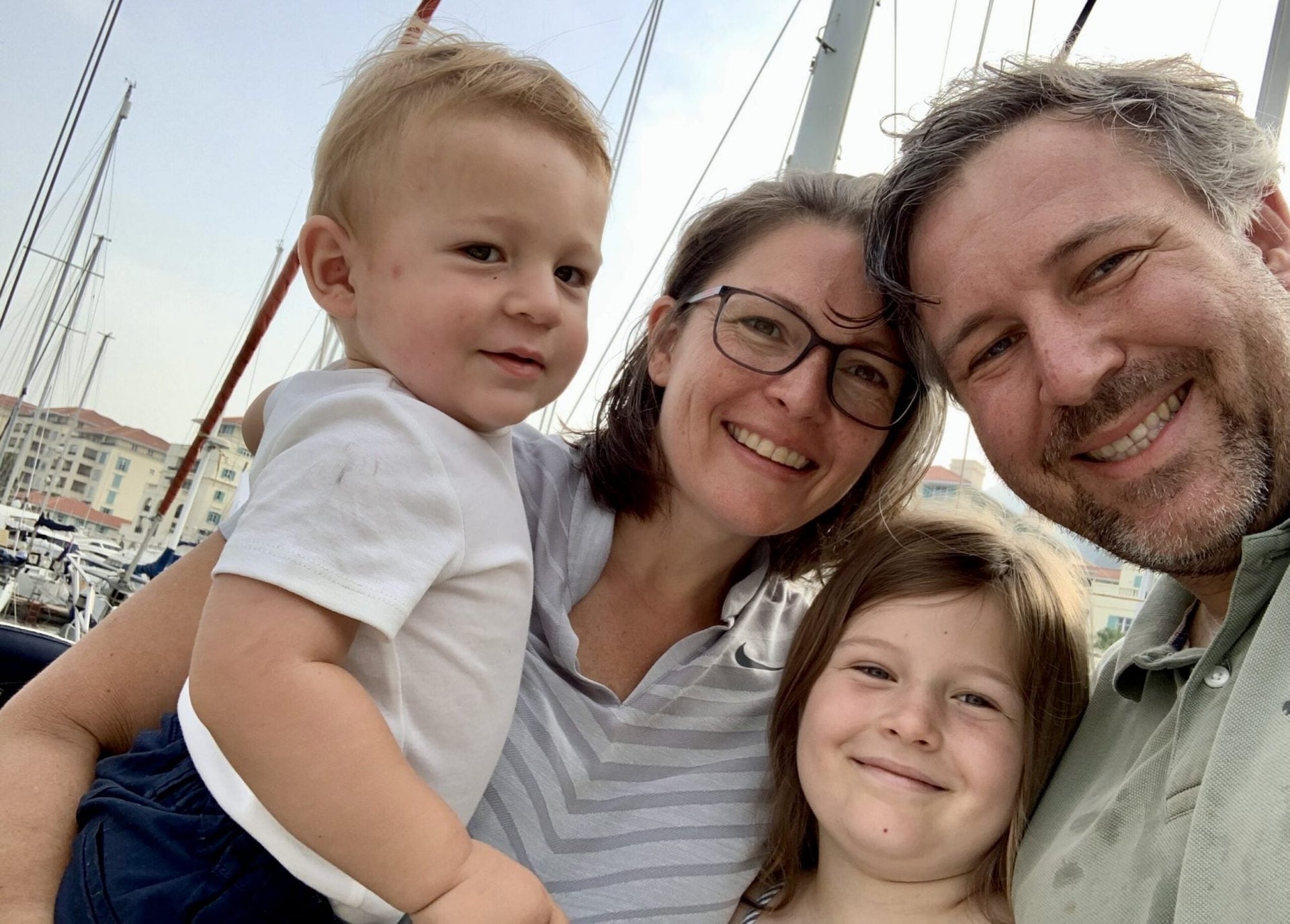
ULTIMATE FAMILY CRUISING ONBOARD OYSTER BELLE
ULTIMATE FAMILY CRUISING ONBOARD OYSTER BELLE
Around-the-World Adventures with Stefan and Emily Hunger
With tales of adventure, fickle winds, good food and wonderful wildlife, we spoke to Stefan Hunger, North Sails client and owner of Oyster 435 Oyster Belle. He talks about his recent ocean crossing and his family's biggest adventure yet.
Stefan Hunger has always had a passion for the water. Stefan grew up dinghy sailing in Austria, venturing further afield to the UK and Mediterranean after meeting his wife Emily. This is where the young couple decided to give ocean sailing a go. Following the discovery of ocean sailing, they soon began the search for the perfect yacht to sail around the world with their young children.
International salesman Stefan, and geologist Emily, spent a long time looking for the boat that fit their dreams and once Oyster Belle was found, they set out on a mission to get her ready for their adventure. A few years were spent getting to know Oyster Belle; living on board, cruising in the mediterranean with some longer passages to introduce their young children to the ocean.
Oyster Belle underwent a full refit before they ventured further afield - a fresh deck was installed, the engine had a full revamp and the couple also purchased a new sail inventory. Their first experience with North Sails was shortly after they bought Oyster Belle and discovered that they urgently needed a new Genoa. “The fit of our North Sails Genoa is exactly what we are looking for. The cut and shape is perfect for our boat.”
A year later, the couple decided to replace their mainsail, opting for an NPC Radian Mainsail with three reefing points to ensure that they were ready for anything that the Atlantic Crossing may throw at them. Speaking positively about their experience with the team of experts at North Sails UK, Stefan commented: “We had fantastic service, our mainsail was very bespoke. The shape, the way the sail behaves is beautiful - so good that we have since ordered a storm jib/staysail and an asymmetric spinnaker.” When Stefan decided to enter the Atlantic Rally for Cruisers (ARC) he worked with Jeremy Smart to replace his old symmetric spinnaker with a furling asymmetric. They installed a small bowsprit per Jeremy’s recommendation. “It works beautifully, it drives the boat forward much better, it’s easy to handle, and we can use it at many different angles. It’s a joy to sail with.”
In January 2022, it was time for Stefan to pursue a lifelong goal to cross the Atlantic Ocean and the family decided to join the Atlantic Rally for Cruisers trip from Gran Canaria to St Lucia. Oyster Belle set sail on the ARC, heading for the Caribbean with a crew of two Austrians and two British sailors, one of whom was the person who introduced Stefan and his wife to ocean sailing who is now a good family friend. Stefan and Emily would have loved to take their kids on the journey, but with the older of the two in school the timing didn’t work out.
Oyster Belle dealt with the crossing perfectly. The crew reflected on the trip on their daily blog which mentioned weather extremes of gale force winds to no wind, torrential rain and tropical sunshine, stunning moon rises, spectacular sunsets, and a clear view of the Milky Way with an array of shooting stars on many occasions. And as if all that wasn’t enough excitement for one trip, the crew had a near collision with a whale and their onboard ‘masterchef’ treated them to deliciously prepared fresh Mahi Mahi.
The weather they encountered during the crossing wasn’t exactly what they were expecting, Stefan recalled. “Something is changing in the global systems, they used to say to go south until the butter melts and then you turn right. That didn’t happen for us. The trade winds didn’t really set in.” Stefan explained that they had to go a long way south in search of some solid breeze. As a result, the crew on Oyster Belle didn't have the usual expected downwind weather conditions which meant that their North G1 Furling Gennaker with Spinex system was a ‘godsend.’ The sail came into its own during the crossing, helping the crew a lot against the other boats that didn't have asymmetric sails.
Looking forward to future adventures, Stefan is working on a twin head sail solution with Jeremy and North Sails. The goal of this is to make crew work easier when it’s just Stefan and his family on board.
Oyster Belle is now tucked up in Grenada awaiting the family’s arrival, where they plan to take advantage of the school holidays to cruise around the Caribbean. Longer term, the plan is to go further afield, potentially towards the Pacific. They hope to use their kids' school holidays to hop around the world under sail.
North Sails is inspired by Stefan and Emily’s family cruising adventures and we wish them fair winds on their travels. To speak with Sail and Cruising Expert Jeremy Smart about your sail inventory, get in touch today.
READ MORE
READ MORE
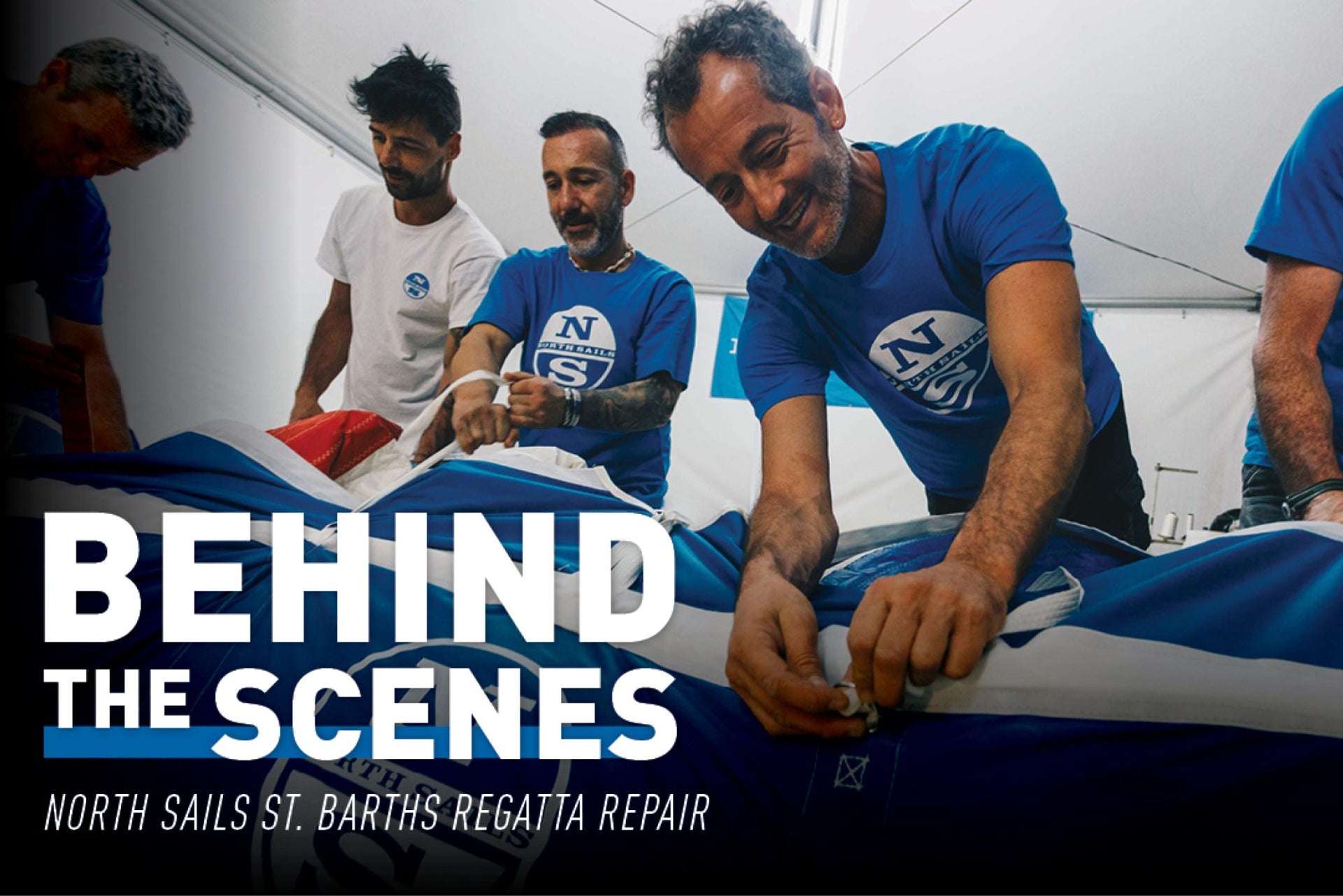
BEHIND THE SCENES: NORTH SAILS AT THE ST BARTHS BUCKET SUPERYACHT REGATTA
BEHIND THE SCENES: NORTH SAILS AT THE ST BARTHS BUCKET SUPERYACHT REGATTA
Watch as Our Experts Work Around the Clock to Keep the Boats Racing
The North Sails commitment to our sport and the art of sail repair knows no bounds, evidenced as a team from North Sails Palma takes their show on the road to ensure clients are race-ready at the St Barths Bucket Regatta. The portable onsite North Sails loft is a testament to the lengths North will go to offer an easy and accessible solution for all boats competing. It may be a bit of an understatement to call the loft in St Barths “portable” as the service team from Palma brings everything they need, literally from floor to ceiling, to create an environment uniquely suited to handle the logistical needs of superyacht sail repair.
Tune in for a behind-the-scenes look at how service expert Brad Favelle and his team work around the clock, repairing any rips, tears, or fails throughout the regatta; a service offered to all participating yachts. It’s hard work with long crazy hours, but if you stop to ask any of the guys where they would rather be, the answer is unanimously “nowhere.”
📸 Atila Madrona
READ MORE
READ MORE
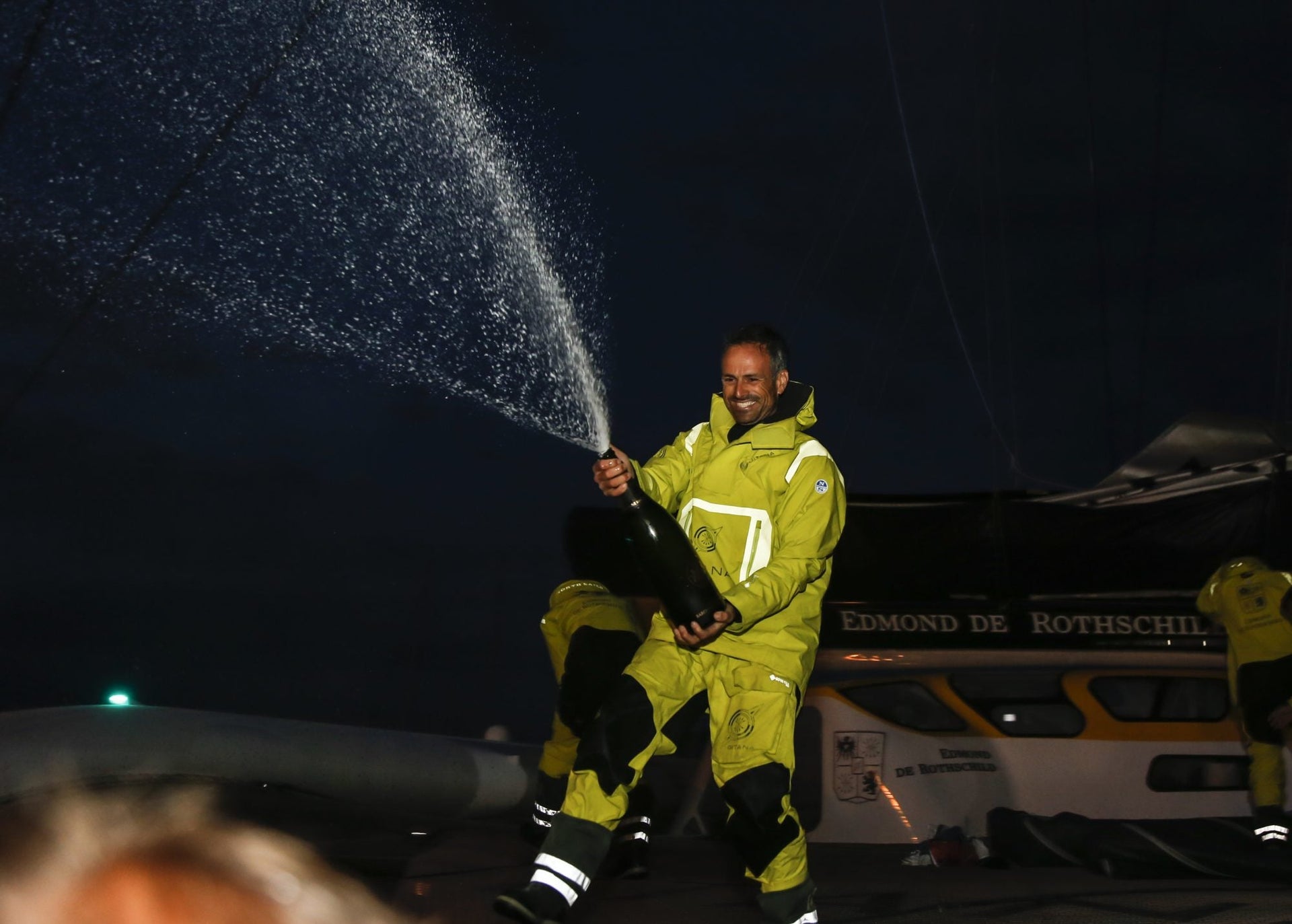
SEAHORSE TECH BRIEF: NORTH SAILS PERFORMANCE COLLECTION
SEAHORSE TECH BRIEF: NORTH SAILS PERFORMANCE COLLECTION
The Fastest Sailors in the World Are Outfitted With the Most Advanced Gear in the Market
📸 Yann Riou
Seahorse Magazine has given us special permission to republish the Tech Brief featuring the North Sails Performance Gear. Performance Director Nigel Musto teamed up with Matt Sheahan to talk about how North Performance is innovating foul weather gear and making history by looking ahead.
North President Ken Read and Director of Design and Engineering JB Braun, teamed up to provide their insight and explanation on what’s hype, what’s fact, and why we feel the North Sails approach with Helix sails is a massive step forward for customers.
‘Our first year has been an outstanding one for us at North Sails Performance,’ says North Sails performance director, Nigel Musto. ‘We’ve been delighted that several of the world’s top sailors, onboard some of the most exciting boats – like the Gitana Team – have chosen to wear our kit. In particular the performance of 4DL, our “4-layer durable laminate” reinforcement, was way beyond even our expectations and the feedback has been superb.’ Bold talk from the man who heads the North Sails Performance team.
In the competitive world of offshore clothing it would be easy to dismiss such enthusiasm as being the talk of the trade. But Nigel Musto’s hands-on approach and considerable racing and clothing experience is well-known in the racing world and means that along with his famously ebullient nature, when he talks of a breakthrough it’s worth taking note. But to understand why the new approach is so effective it’s important to understand a few background matters.
‘When we started the North Sails Performance project in 2018 we set out to solve several issues that the marine clothing industry has never been able to resolve. One was the problem of leaking knees and seats. Historically, when it comes it creating a robust garment that’s resistant to being torn or damaged by the anti-slip treatment on decks, and other snagging points around the boat, it’s been commonplace to put a Cordura patch over the top of the Gore-Tex fabric and then sew that patch into the side seams, but there are several problems with that.’
‘The Cordura patch is heavy and it holds a lot of water when it’s wet, which makes it even heavier. It also creates a pocket between the patch and the Gore-Tex fabric and when that pocket fills with water it never dries out. Then, when you warm the water in that pocket you get reverse breathability which is why your knees and seat always feel damp.’
‘Another problem is that when you sew the Cordura into the side seams you create a very thick seam. The result is that when you waterproof tape this seam there’s a significant risk of failure because you’re asking a lot of the pressure rollers on the PTFE tape machine when they are a forced to go over this very thick seam. If the membrane in the tape cracks, you’ll have a leakage.’
‘With all this in mind we believed that the only sensible solution was to use a completely non-absorbent fabric as the patch and, to apply it in a way that eliminates the pocket and the thick side seams.
‘The logical route was to try and laminate something to the outside because with a laminated patch, you don’t need to go to the side seams. A laminated patch also means that there are no pockets and using a material that is totally non-absorbent means there is no weight gain when the garment gets wet. With all this in mind we went on the search for the ideal fabric and a solution as to how to laminate it to the outside.’
Nigel is tight lipped about the material itself, but when it came to the lamination, the expertise is close to home and not available to the opposition. ‘As many will appreciate from the North Technologies Group’s pioneering work with 3DL and laminated sails, we have a considerable number of experts in this field which was very useful in both finding the right material and then having the knowledge to create the perfect laminate.’
Two years of rigorous testing then followed resulting in some impressive feedback including a serious thumbs up from Imoca 60 sailor Kévin Escoffier.
‘I tested the same North Sails smock and trousers over 40,000 miles of hard sailing including the Transat Jacques Vabre, Le Defi Azimut, Vendee Atlantique – and the kit is absolutely reliable,’ he says. ‘What is just amazing about the North Sails Performance kit is how light it stays even in very wet conditions. The 4DL patches just don’t take in any, any water at all – it’s great and so comfortable.’
And Escoffier is not alone in singing the praises of the new kit.
Being lightweight yet extremely robust, 4DL is proving to be popular with offshore sailors and by the end of the 2021 Transat Jacques Vabre in which teams went from cold, dark and wet to the heat of the Tropics in one race, Maxi Edmund de Rothschild’s (Gitana 17) skipper Charles Caudrelier didn’t hold back in his praise.
‘For the Transat Jacques Vabre whenever we did manoeuvres the North Sails gear is just magic,’ he said shortly after taking the Ultime class win in the race. The North Sails Performance Team is understandably delighted.
‘It’s clear that whether they’re racing or training, extreme offshore teams like Escoffier aboard his Imoca or the Gitana Team spend their life on the edge in some pretty serious conditions yet in the last 12 months there were no reported issues, not a single one.’
It’s hardly surprising therefore that North Sails Performance are so bullish and confident about their new product. 4DL has proved already to be robust, effective and by the accounts of those who have been riding the weather rail for hours on end, dry.
‘The funny thing is that because the sport has never had this type of product we’ve ended up accepting what has become the norm. The fact is that people don’t really appreciate what dry is until they’ve experienced being properly dry – they’re so used to being damp that dry is a bit of a new feeling. And this is what we’re bringing to the party. You really won’t get a damp backside,’ Nigel explains.
As the testing went on there were other advantages that started to appear. ‘While we hadn’t set out with an intent to make a garment that was significantly lighter than anything else on the market, that’s what we ended up with. This lamination fabric is so much lighter than Cordura we’ve saved 30 per cent in weight on dry trousers when compared with our opposition’s equivalent. And that’s when they’re dry. Because everyone else uses Cordura patches, which hold a lot of water, my guess is that we’ll be at least 50 per cent lighter in very wet conditions.’
Tapping into the French offshore scene proved to be invaluable for the North Sails Performance team. While many of the world’s major events were postponed or cancelled, parts of the shorthanded offshore scene were able to continue, most notably the Imoca 60 scene and the Vendée Globe.
‘There are very few sailors that have clocked up the kind of miles that the French sailors have over the last two years and that’s been great because one of the main things we need in testing is hours on the water because that’s usually what causes failures,’ Nigel Musto says.
In some ways the Performance team wasn’t surprised. Secret testing in Australia during training for the 2019 Sydney Hobart Race as well as in the race itself had suggested that 4DL was already delivering more than they had expected. The following year had seen many offshore miles completed in the Imoca scene, culminating in the Vendée Globe.
Once their secret was out of the bag, teams took 4DL into the 2021 season and delivered North Sails Performance with plenty of validations and feedback as the wide range of conditions provided the perfect environment to put theory into practice once again. From the punchy, wild upwind start of the 2021 Rolex Fastnet Race, to the intensity of the Copa del Rey and Les Voiles de St Tropez it was difficult to imagine a wider range of conditions.
North Sails president Ken Read is in no doubt as to just how big a step the new clothing represents and doesn’t hold back.
‘Whenever North Sails sets out to build something, it’s a given that we plan on it being best in show. And the North Sails gear that Nigel Musto and his team have designed and built, for all marine applications, is quite simply better,’ he says. ‘He utilized a number of us who have a bit of time on the water to present what we thought were important features. Combine all of that with the new 4DL technology and voilà… the best foul weather gear, made of the best fabric, that the world has ever seen.’
But while the 4DL project gets a big tick, the North Sails Performance team is working on another area that has been neglected and overlooked for many years, women’s offshore kit. Which takes us full circle because, if you think this is marketing speak, when Nigel explains what the North Sails team has been working on you start to wonder why it is only now that solutions are appearing and those answers are on their way. In the meantime, he remains in no doubt about the significance of the move to 4DL reinforcement.
‘When breathable foul weather gear came onto the scene, many people thought that it was a luxury item, great if you could bear the additional cost. Within a few years, no one was considering anything else. We believe 4DL has the potential to do the same.’
SHOP PERFORMANCE
READ MORE
READ MORE
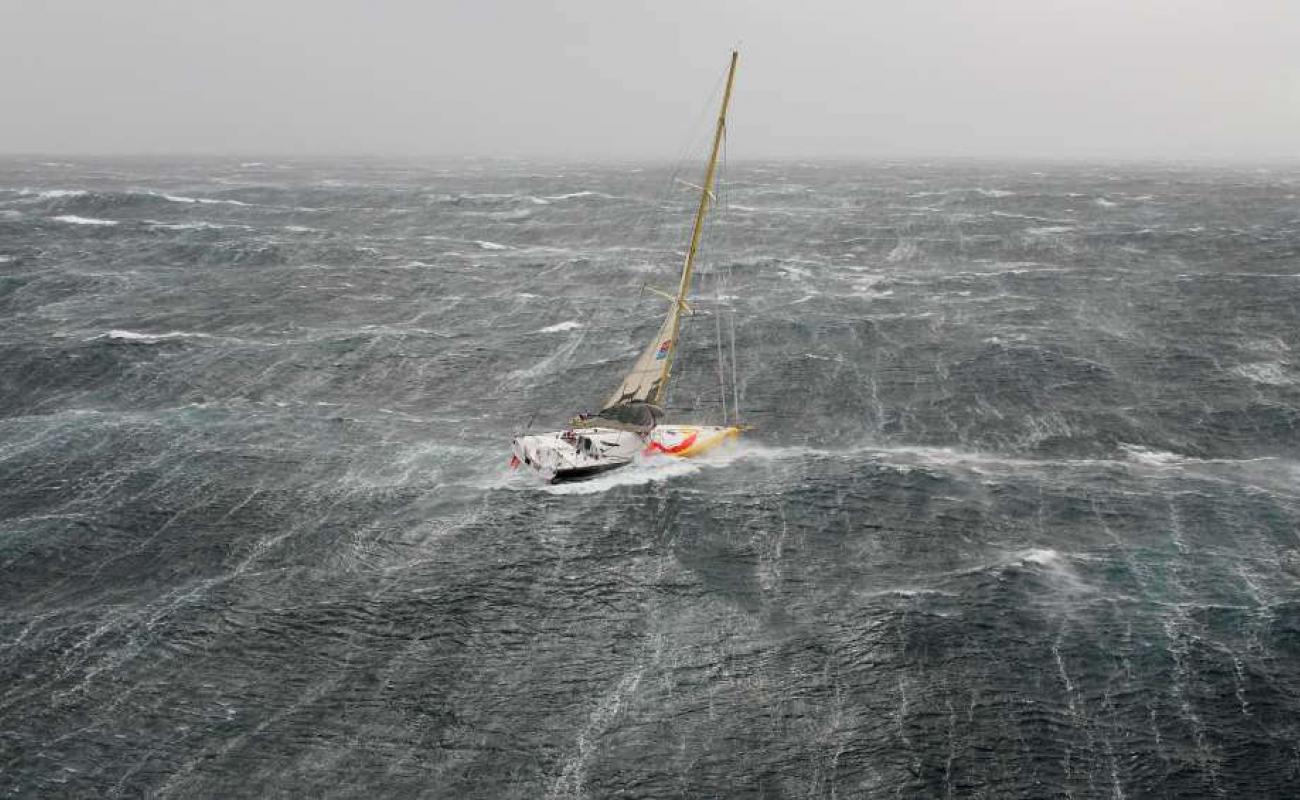
HOW TO SAIL SAFELY THROUGH A STORM
HOW TO SAIL SAFELY THROUGH A STORM
Tips And Tricks To Help You Get Home Safe
📸 Kurt Arrigo/ ROLEX
Compared to the quick response and sudden nature of a squall, sailing through a storm in open water is an endurance contest. In addition to big wind, you’ll have to deal with big waves and crew fatigue.
Sailing in Waves
Sailing in big waves is a test of seamanship and steering, which is why you should put your best driver on the helm. Experienced dinghy sailors often are very good at heavy air steering, because they see “survival” weather more often than most cruisers.
Avoid sailing on a reach across tall breaking waves; they can roll a boat over. When sailing close-hauled in waves, aim toward flat spots while keeping speed up so you can steer. To reduce the chance of a wave washing across the deck, tack in relatively smooth water. A cubic foot of water weighs 64 pounds, so a wave can bring many hundreds of pounds of water across the deck.
Sailing on a run or broad reach in big waves is exhilarating, but be careful not to broach and bring the boat beam-to a breaker. Rig a preventer to hold the boom out.
📸 Carlo Borlenghi / ROLEX
Storm Sails
If reefing isn’t enough to reduce power, it’s time to dig out your storm sails — the storm trysail and storm jib. They may seem tiny, but since wind force rises exponentially, they’re the right size for a really big blow. Storm trysails are usually trimmed to the rail, but some modern ones are set on the boom. The storm jib should be set just forward of the mast to keep the sail plan’s center of effort near the boat’s center of lateral resistance. This helps keep the boat in balance.
Storm Strategy
The first decision before an approaching storm is the toughest: Run for cover, or head out to open water for sea room? With modern forecasting, a true storm will rarely arrive unannounced, but as you venture further offshore the chances of being caught out increase. While running for cover would seem the preferred choice, the danger lies in being caught in the storm, close to shore, with no room to maneuver or run off.
Two classic storm strategies are to try to keep away from land so you’re not blown up on shore, and to sail away from the storm’s path — especially its “dangerous semicircle,” which is its right side as it advances.
Storm Tactics
Storm tactics help you handle a storm once you’re in it. There are several proven choices, all of which aim to reduce the strain and motion by pointing one of the boat’s ends (either bow or stern) toward the waves. No one tactic will work best for all boats in all conditions.
Sail under storm jib and deeply reefed mainsail or storm trysail. This approach provides the most control. Sails give you the power to steer and control your boat in the waves.
Run before the storm with the stern toward the waves, perhaps towing a drogue to slow the boat. This tactic requires a lot of sea room, and the boat must be steered actively. Another concern is that you will remain in front of an approaching storm, rather than sailing out of its path.
Heave-to on a close reach with the jib trimmed to windward. Heaving-to can be an excellent heavy weather tactic, though some boats fare better than others.
Deploy a sea anchor while hove-to or under bare poles. A sea anchor is a small parachute set at the end of a line off the bow. A sea anchor helps keep the bow up into the waves so the boat won’t end up beam to the seas. One concern is the load on the rudder as waves push the boat aft.
Another alternative is lying ahull, simply sitting with sails down. This passive alternative is less reliable than the other tactics, as you lose the ability to control your angle to the waves and may end up beam to the seas. Furthermore, the motion of the boat rolling in the waves without the benefit of sails can be debilitating.
Want to order a storm trysail or storm jib for your boat? Contact a North Sails Expert here.
How to Heave-To
Wouldn’t it be great if, during a heavy air sail, you could just take a break, and relax for a bit? Imagine a short respite from the relentless pitching and pounding: a chance to rest, take a meal, or check over the boat in relative tranquility. Well, you can. The lost art of heaving-to allows you to “park” in open water.
To heave-to, trim the jib aback (i.e., to the wrong side), trim the main in hard, and lash the helm so the boat will head up once it gains steerageway. As the jib tries to push the bow down, the bow turns off the wind and the main fills, moving the boat forward. Once the boat begins to make headway, the lashed helm turns the boat toward the wind again. As the main goes soft the jib once again takes over, pushing the bow down. The main refills, and the rudder pushes the bow into the wind again.
The boat won’t actually stop. It will lie about 60 degrees off the wind, sailing at 1 or 2 knots, and making significant leeway (sliding to leeward). The motion will be much less than under sail, and dramatically more stable and pleasant than dropping all sails and lying ahull. You will also be using up less sea room than if you run before the storm at great speed.
Achieving this balance will require some fine tuning, depending on the wind strength, your boat design, and the sails you are flying. Also, fin-keeled boats do not heave to as well as more traditional designs.
In storm seas, some boats will require a sea anchor off the bow to help hold the boat up into the waves while hove-to.
📸 ROLEX
Alternate Storm Strategy: Don’t Go
If conditions are wrong, or are forecast to worsen, don’t go. If you can avoid the storm, then do so.
If you’re at home, stay there. If you’re mid-cruise, button up the boat, make sure your anchor or mooring or dock lines are secure, and then read a book or play cards. Relax. Enjoy the time with your shipmates. Study the pile of Owners’ Manuals you’ve accumulated with each piece of new gear. Tinker with boat projects.
Put some soup on the stove, and check on deck every so often to make sure the boat is secure. Shake your head as you return below, and remark, “My oh my, is it nasty out there.”
If your boat is threatened by a tropical storm or hurricane, strip all excess gear from the deck, double up all docking or mooring lines, protect those lines from chafe, and get off. Don’t risk your life to save your boat.
Misery and Danger
Although everyone will remember it differently years later, a long, wet, cold sail through a storm can be miserable. As the skipper, you need to make the best of it: watch over your crew, offer relief or help to those who need it, and speak a few words of encouragement to all. “This is miserable, but it will end.”
Take the time to marvel at the forces of nature, and at your ability to carry on in the midst of the storm. Few people get to experience the full fury of a storm. It may not be pleasant, but it is memorable.
While misery and discomfort can eventually lead to fatigue, diminished performance, and even danger, do not mistake one for the other. Distinguish in your own mind the difference between misery and danger. Don’t attempt a dangerous harbor entrance to escape misery; that would compromise the safety of the boat and crew, just to avoid a little discomfort.
Interested in a new sail quote or have questions about your sails? Fill out our Request a Quote form below and you will receive a reply from a North sail expert in your area.
REQUEST A QUOTE
READ MORE
READ MORE
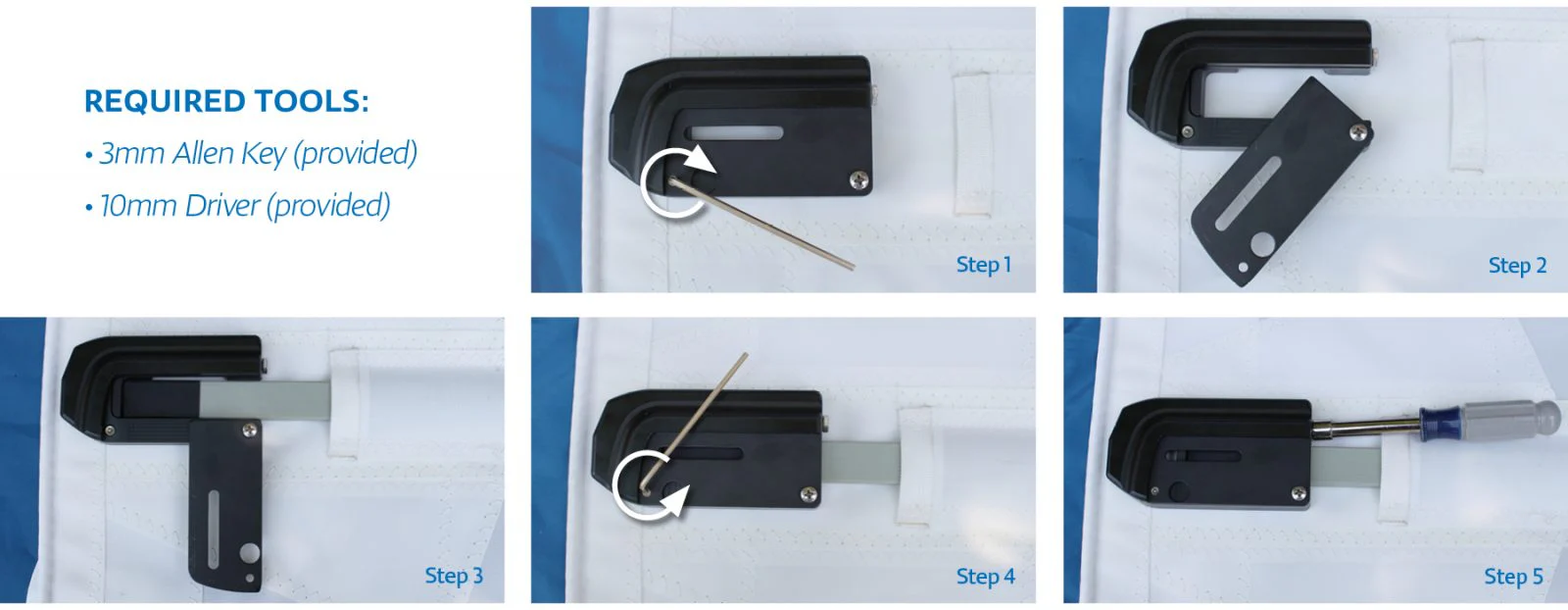
19MM & 25MM BATTEN BOX INSTALLATION GUIDE
19mm & 25mm BATTEN BOX
Installation Guide
North Sails full-batten mainsails come with North Sails adjustable batten boxes installed on the luff end of the pockets. Our batten boxes eliminate batten loss through “shake out,” allow easy compression adjustments, and create a closed, low-profile leech end. They are easy to use and require just five simple steps to install.
Step 1:
Using the supplied 3mm Allen Key, remove the retaining screw in the luff end of the batten box door by turning it CLOCKWISE.
Step 2:
Rotate the batten door down to get it out of the way.
Step 3:
Insert the batten into the pocket, making sure the batten is oriented correctly.
Step 4:
Close the batten door and tighten the retaining screw by turning it COUNTER CLOCKWISE.
Step 5:
Apply the desired amount of batten compression using the supplied 10mm driver to adjust the screw on the aft end of the batten box.
Note: After sailing, the battens need may need additional compressing. If there are vertical creases along the batten pocket, increase batten compression until the wrinkles disappear.
READ MORE
READ MORE
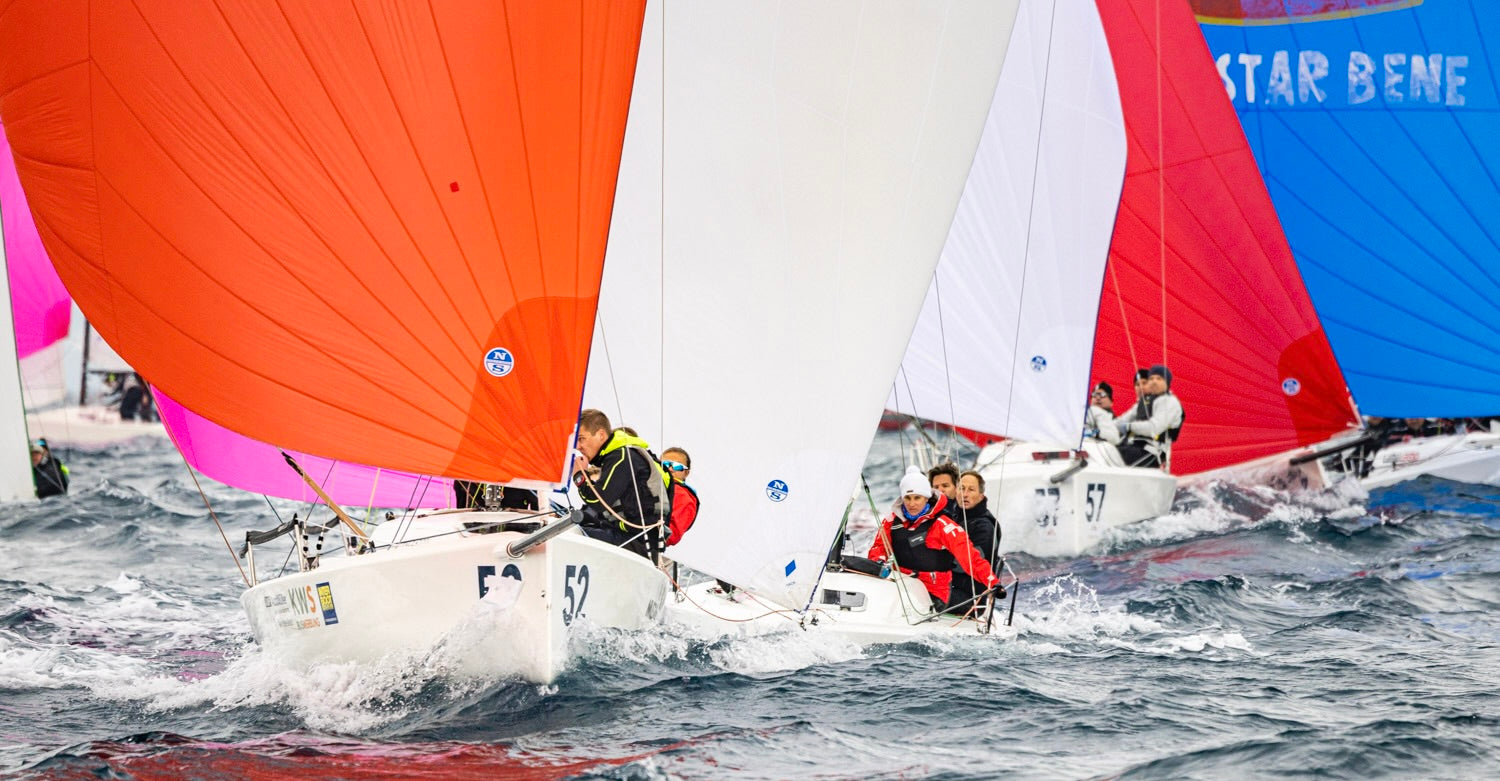
A WORLD CHAMPIONSHIP CAMPAIGN
A WORLD CHAMPIONSHIP CAMPAIGN
The Road to Monaco with North Sails Experts Giulio Desiderato & Alex Curtiss
📸 Studio Borlenghi
Who’s going to win the J/70 Worlds in October? We can’t yet make a prediction, but we do know that the winning team is already well into their preparations—and most likely, they’ve already hired a coach. So we thought it would be helpful to ask two North Sails J/70 experts why they think this adds so much value—even for a regatta when coaches can’t talk to sailors on the water.
North Sails expert Giulio Desiderato is a European champion in the J/70, but for the first part of the 2022 season he has stepped away from the mainsail trimmer/ tactician role to coach Elvis—and says he’s learned a surprising amount. “Off the boat, I can see the fleet from outside and also see the dynamics of the team. And every time, I find something that I want to try when I jump back on board. That’s not only interesting, it’s a great way to improve.”
Of course no coach can help sailors unless they really want to learn, he points out. “The Elvis guys are a Corinthian team, and they are really motivated to improve and become better overall sailors. As a coach, that definitely makes life easier when you can work with a team with this attitude, I’m sure that they will be on the top soon.”
📸 Studio Borlenghi
Data Overload?
When he first started working with Elvis, Giulio was concerned about overwhelming them with too much information. “What I tried to do is divide it up into different areas: the start, boat handling, boat speed, tactics, and communication. Then we tried to improve a little in each area every day. It’s been interesting, because compared to a professional team, they were very open to new ideas. We had to decide together: What’s the routine each day? What is the best approach to the starting line? How do we accelerate?”
Daily Routine
Giulio says he keeps the mornings and evenings pretty much the same for both training and racing. “We have a short morning briefing, which includes a video that is similar to the day’s conditions. I have quite a lot of J/70 material in my database, so I can show a particular maneuver or technique based on the forecast. It’s always helpful to show a video, because it helps the team to visualize what they have to do on the water.”
On training days, Giulio helps the team prioritize what to work on, striving for a mix of both boat speed lineups and practice races. He follows the teams closely, taking video and photos that will help him communicate what he sees to the team.
On race days, Giulio can’t speak to his team once they leave the dock nor can he get too close during racing. “You cannot go in the middle of the fleet, so you have to find the right moment and the right angle to take a picture. It’s easier to take video at the start or at mark roundings, and then maybe downwind you can follow from the side and do some videos to understand if the technique is good or not. I think a good coach should also take video and pictures of the top boats, in order to copy them. You have to be curious, and think all the time as a sailor. I feel strongly about the regatta and it feels like I’m sailing with my guys too.”
After sailing, they sit down for a debrief right away, “to speak immediately about what was most important and show video. Afterward I work on the photos, which help me explain in more detail about the tuning and the trimming. Usually the next morning I send the best pictures to the team, and we might discuss them at the morning meeting, especially if the conditions will be similar.”
📸 Studio Borlenghi
From the Sailor’s Perspective
Though his team on Good to Go used to send their coach home once racing started, North Sails expert Alex Curtiss says they have already locked in Mark Ivey for the entire Worlds—and for all of their lead up regattas. That’s because they’ve set the Monaco event as a top priority. “Doug Rastello, the owner, really likes it there,” Alex says, adding that they raced there three times over the winter. “It’s a really dynamic place to sail, because it’s a microclimate between the mountains and the Med. And the chop is really big; the whole city is concrete, and there’s a long seawall. The waves come in and hit it, and then you get these crazy reverbs; sometimes you’ll be sailing upwind with five foot waves coming from astern! We’ve had to learn to set the boat up differently on each tack.”
Biggest Advantage?
Asked to choose the biggest single value of coaching, Alex says it would be optimizing sail shape. “That’s a big thing, especially in a place like Monaco. Just having that outside eye on guys that are faster than us; Mark will say, ‘Okay, they’re slightly flatter than you’ or ‘these guys are slightly fuller.’ And a lot of times when we get off the water, he’s thinking about something he saw that was not even on our radar. I definitely think that if you’re a Corinthian team, and you’re looking to crack into that next group or get in the front of the pack, having a coach for a whole event is wildly helpful.”
Be Adaptable
When we spoke, Giulio wasn’t yet certain whether he’d be in the RIB or onboard a J/70 for the Worlds. He also says that it will be a “really difficult championship” to forecast. “The only thing that we are sure about is that it will be wavy,” he says. “And for that reason, whether I’m a coach or a sailor, it will be very important to be really adaptable with the sail configuration. At the last Primo Cup regatta, which we consider as a world championship test event, there were 17 North Sails boats in the top 20. Our F1 mainsail and J2+ jib also won the Bacardi Invitational Regatta in much different conditions. That’s for sure a combination that will give a lot of chances to perform.”
Interested in buying a new set of sails for the summer, or for the World Championship?
Contact a North Sails J/70 Class Expert or order directly from the button below.
J/70 CLASS PAGE
Alex Curtiss onboard Good To Go | Monaco Act IV 2022
READ MORE
READ MORE
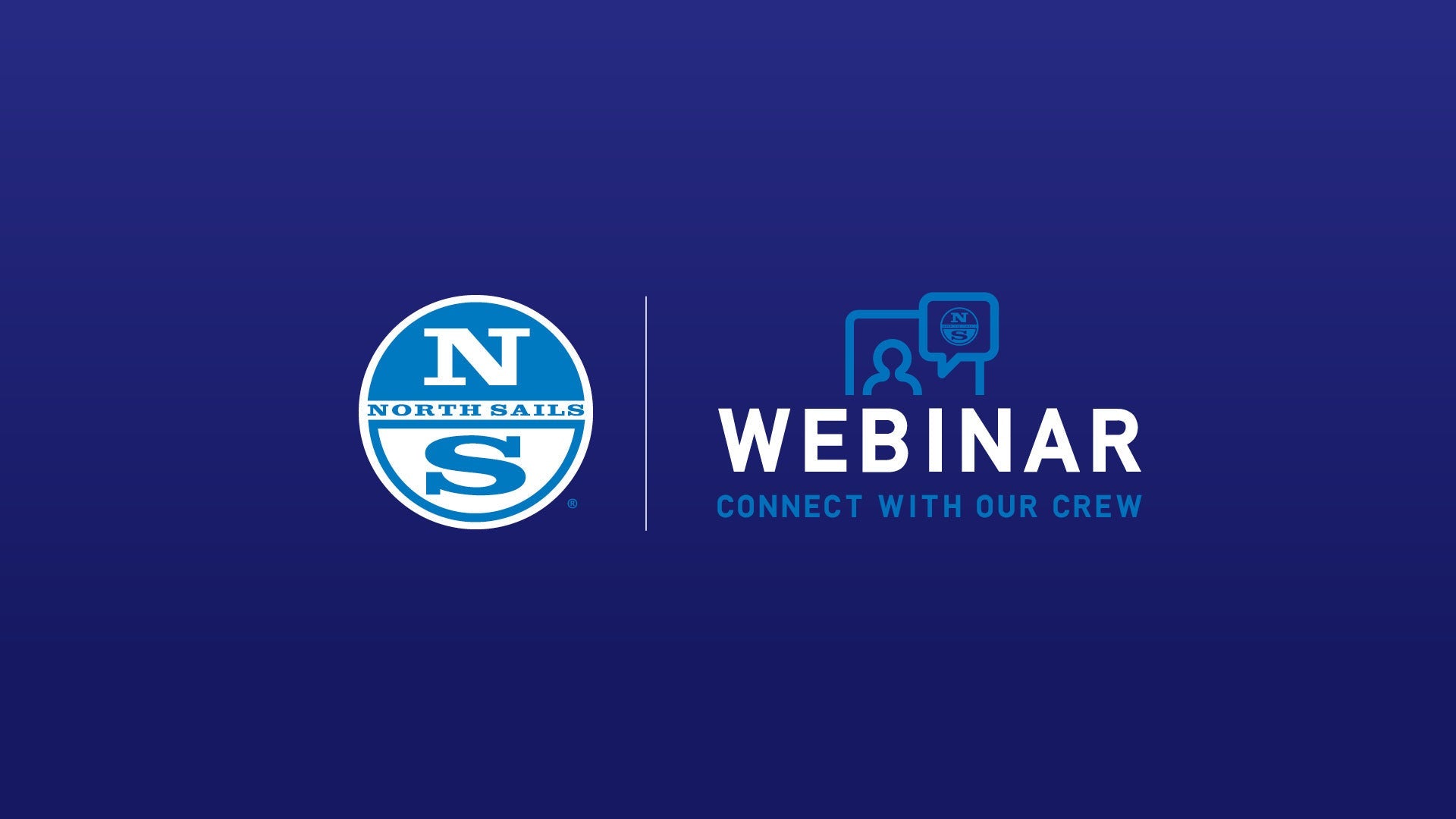
SYDNEY TO HOBART YACHT RACE NAVIGATION DEBRIEF
SYDNEY TO HOBART YACHT RACE NAVIGATION DEBRIEF
Watch the Live Webinar with North Sails expert Mark Bradford + Black Jack's Navigators
Rewatch this live webinar with North Sails expert Mark Bradford debriefing the 2021 Sydney to Hobart Race with Black Jack navigators Alex Nolan and Kevin Costin.
More on the 76th Edition of the Sydney Hobart Race Line Honors Winner Black Jack -
When Black Jack’s mast fell over the side during a record-setting run last April, the team quickly decided to turn their devastating loss into a performance upgrade. That decision paid off when Peter Harburg’s team claimed line honors in the 76th edition of the Rolex Sydney Hobart Yacht Race.
The RP100 had always struggled upwind against Christin Beck’s wider LawConnect, a Juan-K design. So we wanted to understand how an experienced team of sailors and North Sails design engineers overcame this boat’s known weak point. The answer? A new aero package that took advantage of Helix’s load-sharing technology.
Story continued below...
BLACK JACK'S WINNING COMBINATION
READ MORE
READ MORE
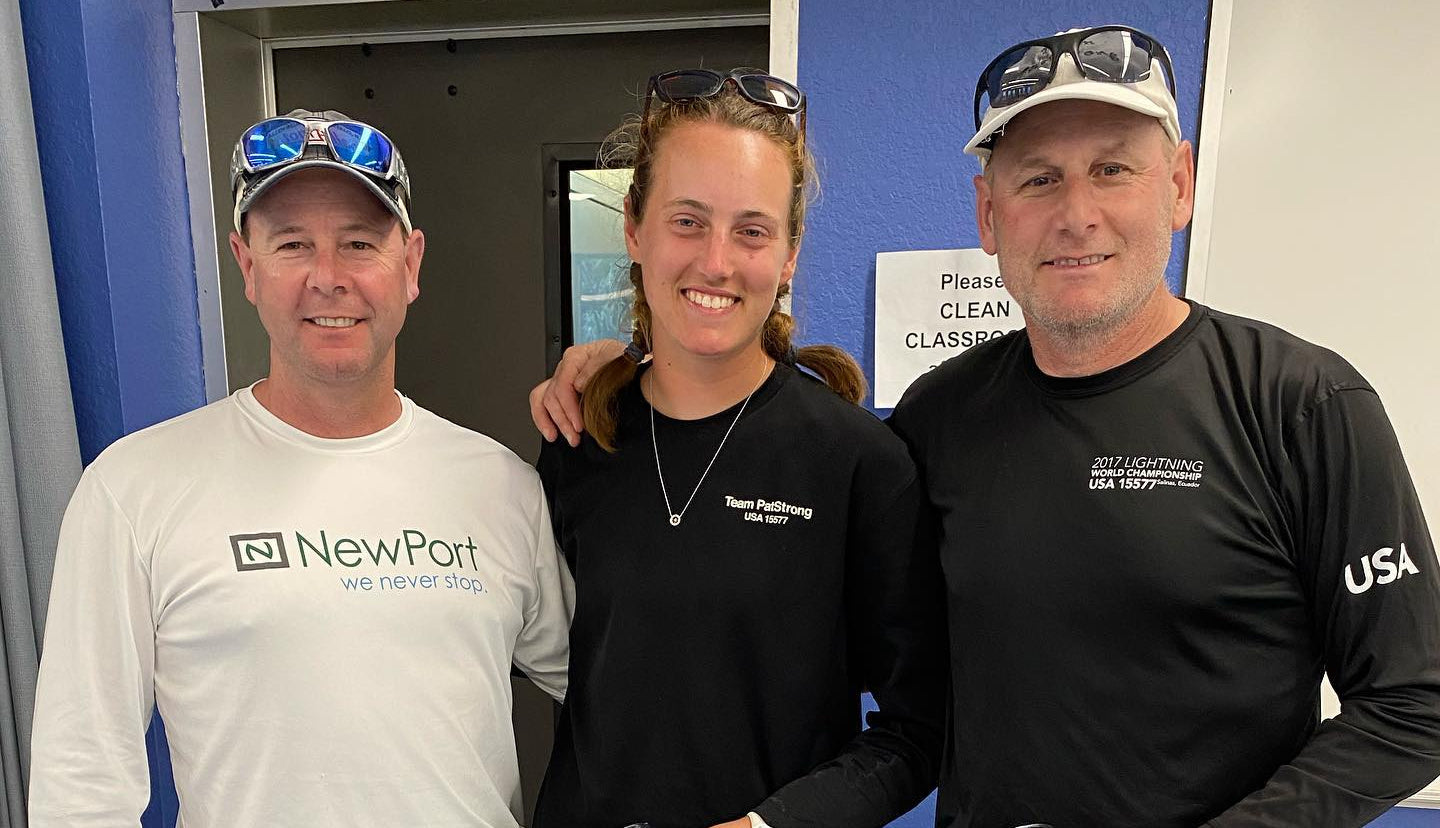
2022 LIGHTNING SOUTHERN CIRCUIT RECAP
2022 LIGHTNING SOUTHERN CIRCUIT
Team Patstrong Takes Midwinters Title, Solidifies Their Southern Circuit Win
Tom Starck, Jenna Probst and David Starck – Team Patstrong | 2022 Southern Circuit Champions
The final leg of the 2022 Lightning Class Southern Circuit wrapped up March 25th with the Lightning Midwinters being held in Miami Florida. 25 teams sailed on beautiful Biscayne Bay with the racing and regatta events being hosted by the Coconut Grove Sailing Club. Conditions were challenging over the 2 day event with big chop and wind speeds of 12-22 knots. This combination created ample opportunity for crews and boats to be thoroughly tested leading to a few breakdowns and capsizes. However, by the end of each day, all the boats were fixed and crews (while perhaps sore and tired) were smiling and excited to have been able to be back racing in Miami.
The Midwinters began with 3 races being held in Thursday’s big breeze and waves with 1/3 of the fleet suffering some sort of mishap that caused them to miss at least one race. Friday’s forecast looked only marginally better, but as the day wore on the breeze moderated dramatically giving many of the tired crews a small break with more manageable 12-15 mph shifty breeze, allowing the race committee to complete 3 more races to give the teams a drop race.
Getting the drop race was critical for regatta and circuit champions David Starck, Tom Starck and Jenna Probst as they were one of the teams that suffered a breakdown on Day 1 and carried a DNC into Friday’s racing but with a final scoreline of 4,1,(DNC),2,1,2, “Team Patstrong” asserted their dominance on the circuit and bested the Chilean team of past World Champion Tito Gonzalez, with his son and daughter Alberto and Trinidad by 5 points to win the 2002 Midwinter Championship. Rounding out the top 3 was our own Ched Proctor with Madeline Gill and Jeff Eiber only 5 points behind team Gonzalez.
Last but not least, Sabrina Starck, David and Jody’s daughter (and long time Lightning sailor) won the Youth Award at the 2022 Winter Championships. “It is a super one-design class for youth sailors who want to experience a high level of competition, international venues, and a family atmosphere,” mentioned dad and Southern Circuit winner, David Starck.
The Midwinters wrapped up the 2 regatta Southern Circuit for the class and it was exciting to see the successes our clients had using North Sails, with every race on the circuit won by a North Sails team. We are proud that so many Lightning sailors trust North Sails to help them succeed on the race course with 9 of the top 10 teams, and 20 out of the top 23 teams racing with North inventories. Our team is looking forward to a great 2022 season and the World Championships May 2022.
Reach out to any of our North Sails Lightning team and see how we can help make you and your team championship winning fast!
CONTACT AN EXPERT
“Top Newcomer” to the Lightning Class – Augie Diaz
View Full Results Here –
Winter Championship
Midwinter Championship
Lightning Southern Circuit Overall
1. Team David Starck, Tom Starck and Jenna Probst
2. Team Augie Diaz, Jackie Morrison, Kim Couranz and Christine Maloney
3. Team Tito Gonzalez, Trinidad Gonzalez and Alberto Gonzalez Jr.
4. Team Jody Starck, Bill Faude, Ian Jones and Tim Crann
5. Team Ched Proctor, Jeff Eiber, Madeline Gill, Ethan Bixby and Meredith Killion
Top Newcomer- Augie Diaz
Interested in joining the class, or getting to know more about the Lightning? Check out the Class Website here.
READ MORE
READ MORE
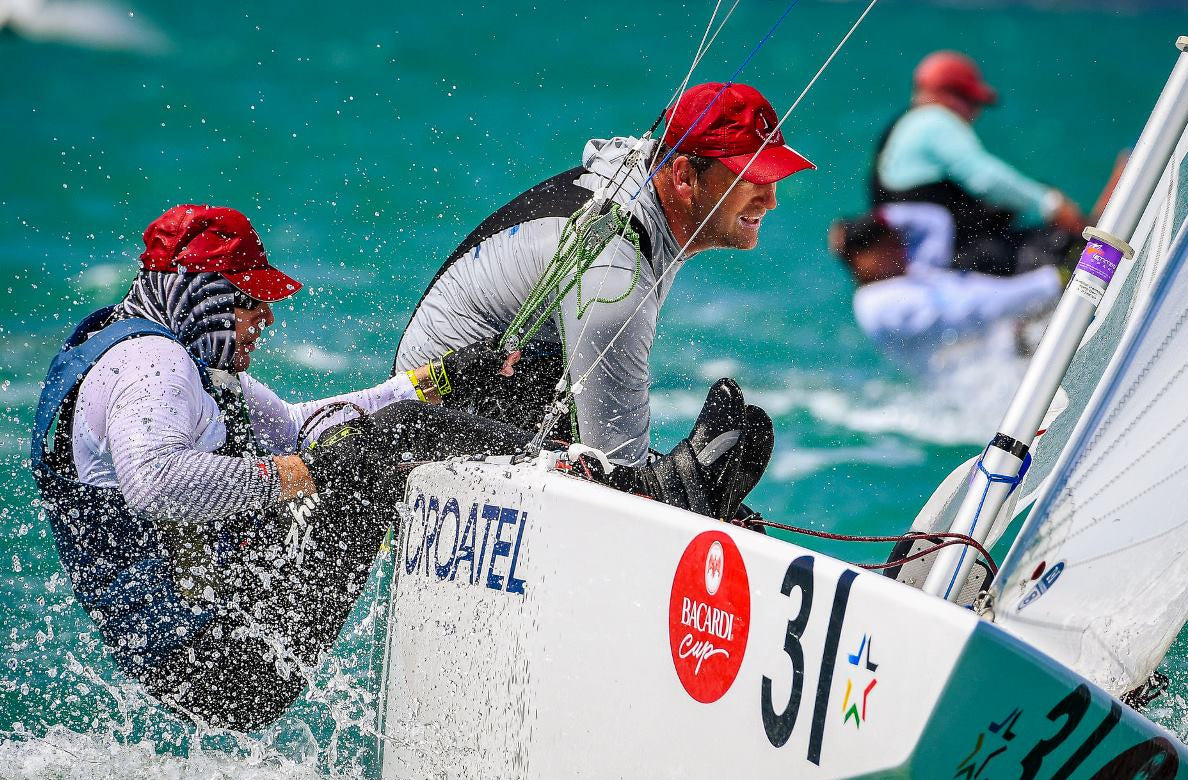
NOVA GENERACIJA NORTH SAILS FLOKOVA ZA KLASU ZVIJEZDA RADI IZVRSNO!
Nova Generacija North Sails Flokova za Klasu Zvijezda Radi Izvrsno!
📸 Martina Orsini
Pozivna regata kojoj je glavni sponzor tvrtka Bacardi, a koja se jedri u Miamiju, okupila je neke od najboljih svjetskih jedriličara u klasama Zvijezda, Melges 24, J70, Viper 640, 69F i VX One. Među njima našle su se i dvije hrvatske posade u klasi Zvijezda, a riječ je o Marinu Mišuri i Tonku Baraču, odnosno Tonču Stipanoviću i Tudoru Biliću.
Dvojcu Mišura - Barač ovo je bio već šesti nastup na ovoj regati, dok su Stipanović i Tudor imali premijeru. Ukupno je sudjelovalo preko 160 posada, a ovisno o formatu natjecanja nisu svi krenuli s regatom u isto vrijeme.
Posade u klasi Zvijezda krenule su prve jer je njihov program jedrenja predviđao samo po jedan plov u danu, dok je za jedrenje bilo predviđeno šest dana.
Ostale klase imale su nešto kraće boravke u Miamiju, ali zajedničko im je svima bilo to da su kraj jedrenja svi imali istog dana.
Što se tiče logističkog dijela regate, domaćinstvo je podijeljeno između više klubova, jer smještaj tolikog broja jedrilica traži dosta prostora, što na kopnu, što u moru. Da je u pitanju ozbiljan organizacijski zahvat mogli su se uvjeriti i svi koji su prošlog ljeta bili u Splitu za vrijeme Europskog prvenstva klase Zvijezda, odnosno svi koji prate događanja oko regata klase Melges 24.
Vremenski uvjeti su po riječima naših jedriličara bili zahtjevni, jer je puhao južni vjetar od prosječnih petnaestak čvorova s oscilacijama od 3 - 4 čvora. U klasi Zvijezda to zahtjeva dosta truda, jer je ovaj vjetar bio u kombinaciji s kratkim i oštrim valovima koji su i inače uobičajeni u Miamiju, a ako posada nije dobro pripremljena za takve uvjete može imati ozbiljne probleme s jedrenjem u orcu jer ako se ne jedri koncentrirano jedrilica značajno uspori. S obzirom na njenu popriličnu masu ponovno ubrzavanje zahtijeva dodatno vrijeme i malo po malo se gube dragocjene sekunde i prejedreni metri.
Unatoč predviđenih šest dana za jedrenje jedrilo ih se pet. Razlog je što je posljednjeg dana regate Obalna straža zabranila isplovljavanje zbog prejakog vjetra koji je ostao kao posljedica noćne nevere. Zato su se rezultati računali na osnovu najbolja četiri rezultata s obzirom da je bilo moguće jedno odbacivanje. Naše dvije posade na kraju su završile na 10. i 14. mjestu s tim da je ovogodišnji ulazak u top ten posade Mišura - Barač njihov najbolji rezultat do sad ostvaren u Miamiju.
Jedrili smo dobro s obzirom da praktički nismo trenirali. Jedini trening pred regatu bio je nastup na Kairos Kupu u Trogiru. Ali kad se pogledaju rezultati mislim da ne možemo biti nezadovoljni. Istina, u Miami smo stigli tri dana prije početka regate, ali dva dana je bio previše jak vjetar pa nismo htjeli ići u rizik oštećivanja opreme s obzirom da smo morali uzeti charter brod.
Najlošiji rezultat nam je 33. mjesto iz drugog plova. Tada nam je najveći problem bilo to što smo na bovu od orce stigli na lijevim uzdama i nismo se uspjeli ubaciti, a kad se to desi onda nema se što nego propustiti flotu. Kasnije smo nadoknađivali izgubljeno, ali bolje od ove pozicije nije moglo.
Najbolji rezultat bilo nam je 3. mjesto četvrtog dana regate. Taj plov smo dobro jedrili od starta pa do cilja. Dobro smo odradili krmu, ali orca nam je ove godine stvarno bila najbolja do sada.
Promijenili smo model floka i to nam se u orcu pokazalo kao izvrstan potez. Mislim da mogu reći da so čak i bili malo komodni po pitanju brzine u orcu.
Riječ je također o North Sails floku, jer inače jedrimo samo s Northom, i to o najnovijem modelu kojeg su izbacili na tržište. Mislim da je od rujna prošle godine i još uvijek ga se dosta ljudi boji staviti. Mi smo ga naručili i nismo puno razmišljali već smo ga tamo odmah podigli i već prvi dan vidjelo se da je to bio dobar izbor, pa nismo dalje ništa mijenjali.
Što se nas kao posade tiče mislim da je jako dobro to što smo iz regate u regatu tehnički bili sve bolji. S obzirom da ne treniramo to nam je izrazito drago... jer nismo stagnirali već smo radili progres.
Marin Mišura, CRO 8531 - kormilar
Regata u Miamiju bila je samo prva stavka u popisu regata posade Mišura - Barač, a iduća je Prvenstvo istočne hemisfere koje će se jedriti u Napulju od 27. travnja. Potom slijedi Europsko prvenstvo u srpnju u Danskoj, pa povratak na sjevernoamerički kontinent na Svjetsko prvenstvo u rujnu u Bostonu.
Druga Hrvatska posada, Stipanović - Bilić, također je jedrila s charter jedrilicom, ali od proizvođača s kojim surađuju posljednjih godinu - dvije. Međutim, ipak postoje razlike jer jedrilica na kojoj jedre u Europi napravljena je baš po njihovim karakteristikama i potrebama.
📸 Martina Orsini
Bodovna razlika između naše dvije posade, nakon odbacivanja, bila je deset bodova. Mišura i Barač imali su u konačnici 41 bod dobiven zbrojem 11., 14., 13. i izvrsnog 3. mjesta, dok su Stipanović i Tudor uknjižili 51 bod dobiven od 9., 17. 13. i 12. mjesta.
Ovo nam je bio prvi Bacardi Cup, a konkurencija je bila izvrsna. Bilo je sigurno 10-15 najboljih svjetskih posada.
Mi smo jedrili u posuđenom brodu, kao i svi što iz Europe koji dođu u Ameriku, pa smo iskoristili priliku za testiranje neke druge opreme poput mekšeg jarbola, drugog floka itd.
Tako dok se nismo utrimali nismo bili baš zadovoljni brzinom kakvu smo inače imali, pa se nismo nešto pokazali na početku regate.
Imali smo i par dobrih i par loših starteva, tako da je rezultat stvaran preslik našeg jedrenja... nije ni dobro ni loše...
Jedrili smo po jedan plov dnevno, a regate su trajale oko sat i 50. Puhalo je između 12 i 20 čvorova, a mi s našim oscilacijama nismo bili u vrhu kao što smo jedrili na prošlom svjetskom.
Razlog za to je jednim dijelom bio manjak treninga, ali i to testiranje opreme. Mislim, Zvijezda nije samo ono sjedneš u brod i voziš. Osnovni problem bilo je to što smo stavili taj novi jarbol, a to napraviti pred regatu nije baš dobra stvar. S novim jarbolom mijenjaju se sve mjere, ali sve u svemu bilo je OK.
S druge strane Marin i Tonko jedrili su malo bolje od nas, jednom ušli i kao treći i ostvarili svoj najbolji rezultat na ovoj regati. A sama regata kao regata je stvarno veliki event koji zajedno organizira nekoliko klubova.
Tudor Bilić, CRO 8540 - flokist
Stipanović i Bilić preskočit će Prvenstvo istočne hemisfere zbog Stipanovićevih obaveza u njegovoj matičnoj klasi ILCA i Bilićevih poslovnih obaveza, ali zato planiraju nastupiti na EP u Kopenhagenu i to s novim brodom koji im stiže u travnju. Također planiraju nastup i u Bostonu gdje će braniti srebro osvojeno u Kielu, a posebnu draž jedrenju u Massachusetts dat će obilježavanje stote godišnjice od kad su se počela jedriti svjetska prvenstva klase Zvijezda.
Zanimljiv detalj vezan uz regatu klase Zvijezda na Bacardi Cupu je što tu ne vrijedi ograničenje u masi koje se inače primjenjuje po pravilima klase na svim ostalim regatama i iznosi 200kg.
Po pitanju klase Zvijezda u Hrvatskoj, mora se reći da je ponovno ušla u fazu stagniranja, jer na spomenutom Kairos kupu, koji je izvorno regata klasa Optimist i ILCA, jedrilo je samo pet posada iako je to bila prva regata klase nakon EP u Splitu. Trenutno je u Hrvatskoj između 10 i 15 ovih jedrilica, a s povratkom u kokpit koketira i naš olimpijac iz Londona Marin Lovrović mlađi. Pitanje je kako ih motivirati i privući na regate, ali to je sad neka druga tema s kojom se susreću i u drugim klasama.
READ MORE
READ MORE
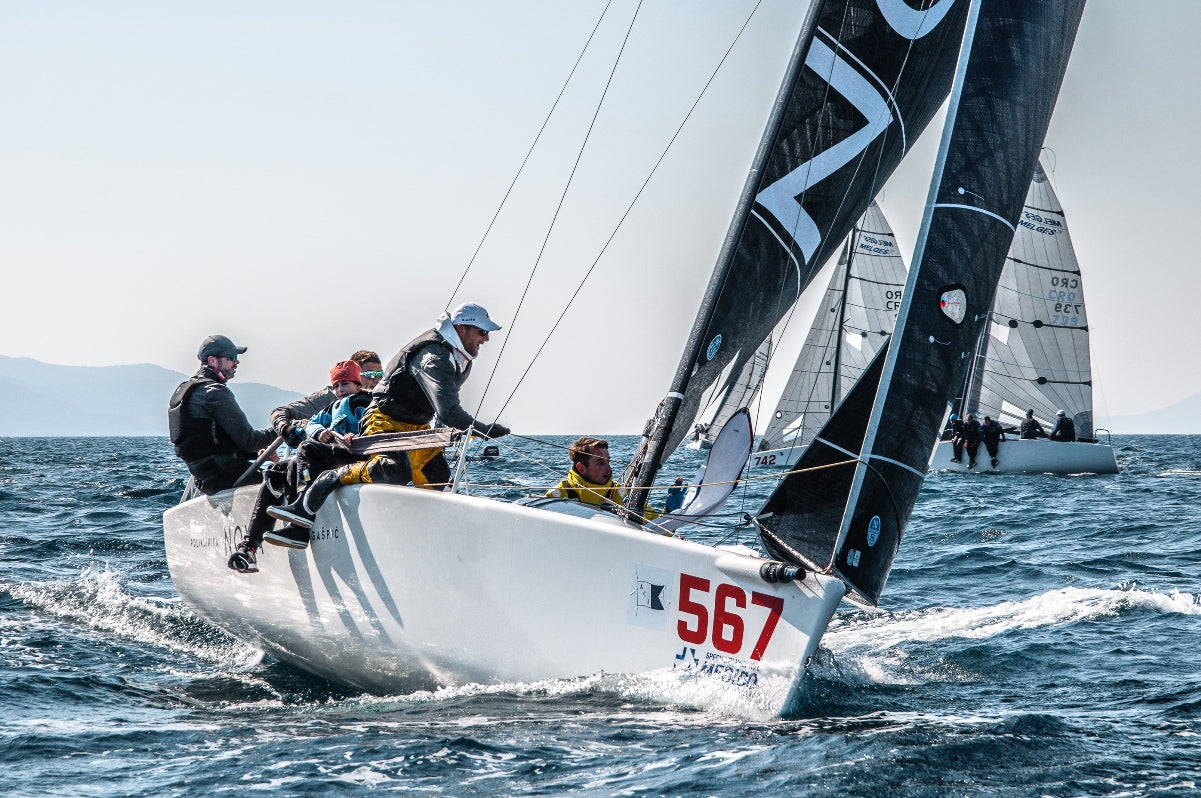
UNIVERSITAS NOVA SAVRŠENIM SKOROM PRVOG DANA DO UKUPNE POBJEDE U OPATIJI
Universitas Nova savršenim skorom prvog dana do ukupne pobjede u Opatiji
📸 regate.com.hr
Treća regata CRO Melges 24 Cupa za 2022 odjedrena je u aranžmanu YC Croatia, a na njoj je sudjelovalo 15 posada među kojima su po prvi put zajedrile Fjonda, She i Razjaren, a i jedna slovenska posada došla je u ispitivanje konkurencije pred nastup na prvoj regati iz ciklusa Europskog kupa koja će se između 1. i 3. travnja jedriti u Rovinju.
Marčanska bura puhala je i 19. i 20. ožujka, oba dana regate, te stvarala poprilične probleme kako Regatnom odboru tako i natjecateljima. Ali s druge strane dozvolila je svima da se naspavaju, pogotovo u odnosu na prethodnu godinu kad su se jedriličari u ACI marini Ičići okupljali već od 5 sati ujutro da bi stigli jedriti na Vološčanskoj tramontani.
U subotu najviše problema imali su suci na brodu RO-a, jer su imali problema sa sidrenjem s obzirom da je puhala vrlo jaka bura, a sidrenje velikog Firsta 45 se moralo obaviti na dubini većoj od 60 metara. Kad su se potopili svi lanci i produljili sidreni konopi moglo se krenuti s jedrenjem.
Bura je i dalje puhala, ali problem jedriličarima više su predstavljali prateći valovi. To su redom kasnije priznali svi sudionici, jer na svim dosadašnjim regatama nikad nije bilo ovako jakog vjetra, kao ni oštrog vala od bure.
Subotnji program odrađen je do kraja. Odjedrila su se sva tri predviđena jedrenja.
Međutim, kako je dan odmicao vjetar je pomalo slabio i u jednom trenutku otišao je u drugu krajnost u odnosu na jutro. Da se nastavilo s tendencijom slabljenja realna je bila mogućnost prekida jedrenja zbog nedovoljnog vjetra. Da jedriličarima bude još teže pobrinula se mareta koja je i dalje bila značajna i u takvim uvjetima još neugodnija.
Treći plov ipak je odjedren po malo boljim uvjetima jer je vjetar ponovno malo pojačao, ali bilo je to daleko od jutarnjih petnaestak čvorova.
U sva tri jedrenja apsolutni primat imao je Universitas Nova, jedrilica za čijim kormilom je Ivan Kljaković Gašpić, a u čijoj posadi jedre i dva člana AJK Universitas Marin Golem i Filip Miroić i Ivanova kćer Mia, te Šime Markić. Jedini koji su im se uspjeli bar donekle približiti bili su momci s Panjića Luke Šangulina. Oni su u prvom i trećem jedrenju zauzeli drugo mjesto, dok je u drugom plovu to pošlo za rukom slovenskoj posadi na Ariji s Peterom Podunavcem za kormilom. Inače, oni stariji će se sjetiti, Peter je osvojio broncu na Europskom prvenstvu klase Optimist 1988. godine.
Dosta dobro ponovno su jedrili i momci s Matarana, te ekipa s PointOne, dok je možda neke iznenadila ekipa Fjonde koji su kiksali samo u drugom plovu kad su završili 10. dok su u prvom i trećem jedrenju u cilj ušli kao 4. i 3. Inače, to je posada iz susjedne Opatije i riječ je o vro iskusnim jedriličarima s Goranom Ivankovićem za kormilom.
Nedjelja se još u prognozama najavljivala kao mnogo teži dan od subote, a to se i potvrdilo prilikom dolaska u marinu Ičići. Stalno je puhalo preko 15 čvorova, a s početkom regate i bura je počela jačati. Takvi uvjeti stvarali su dodatni pritisak na natjecatelje za hvatanje što bolje pozicije na startnoj liniji, pa su se na ovom startu dogodila čak tri prijevremena prelaska startne linije. Tada su po 16 nepotrebnih bodova dobili PointOne, Aria i Obi Wan.
Zanimljivo je da je oba dana izniman pritisak bio na lijevoj strani startne linije, što je u subotu rezultiralo i s naslanjanjima na pin brod. Naravno, nije to bilo bez razloga, pogotovo što je to bio i izbor, odnosno preporuka poznavatelja lokalnih vremenskih prilika. Definitivno je lijeva strana bila opravdano poželjan izbor.
Po ovim, značajno težim, uvjetima Universitas Nova nije uspio dominirati kao dan ranije. U prvom plovu malo brži od ovog Melgesa bio je Mataran 24, dok je u drugom plovu da, koji je inače bio i skraćen, pobjedu odnio Panjić.
Taj drugi plov startao je po više od 20 čvorova vjetra, a u trenucima obilaska privjetrinskih oznaka puhalo je i preko 25. Posljedica svježih refula bilo je skoro pa istovremeno izvrtanje na bok nekolicine jedrilica!
Nakon prolaska kroz gate slijedio je povratak u vjetar i sigurno je bila riječ o najnapornijem jedrenju u Melgesima do sada za većinu sudionika. Regatni odbor je bio više nego svjestan situacije i kako je donesena odluka da se regata pusti dalje, da bi se bar malo olakšalo svim natjecateljima, odlučeno je da se postavi pomoćni cilj na idućoj oznaci.
Osim Panjića, ovaj plov, vrlo dobro je odjedrio i PointOne. Ovako su se bar malo "iskupili" za kiks s prethodnog starta, dok je Mataran ovog puta ušao kao treći. Pobjeda iz prethodnog plova i ovo treće mjesto osiguralo je posadi Matarana titulu najuspješnije posade dana.
Vjetrovita nedjelja sigurno će u lijepom sjećanju ostati i posadi Melgesa - Razjaren. Kao što je već spomenuto ovo je njima bio premijerni nastup, a kako im je za kormilom Ante Ćesić i očekivanja su im bila velika. U subotu su još hvatali ritam broda, dok su u nedjelju osvojili 3. i 4. mjesto. Inače, za neupućene, Ante Ćesić je u kombinaciji s Antom Kujundžićem 2004. godine osvojio titulu svjetskih prvaka u klasi 470, dok su godinu ranije bili srebreni iza Šime Fantele i Igora Marenića.
Na kraju, kad se obavi finalni izračun, subota je Universitas Novi osigurala uvjerljivu pobjedu, dok su se srebrom i broncom okitili Panjić i Mataran 24 koji je imao jednak broj bodova kao PointOne.
Ukupne rezultate regate možete pronaći na ovom linku, a idući event klase Melges 24 u Hrvatskoj bit će velika međunarodna regata u Rovinju koja će se jedriti od 1. do 3. travnja.
📸 regate.com.hr
READ MORE
READ MORE
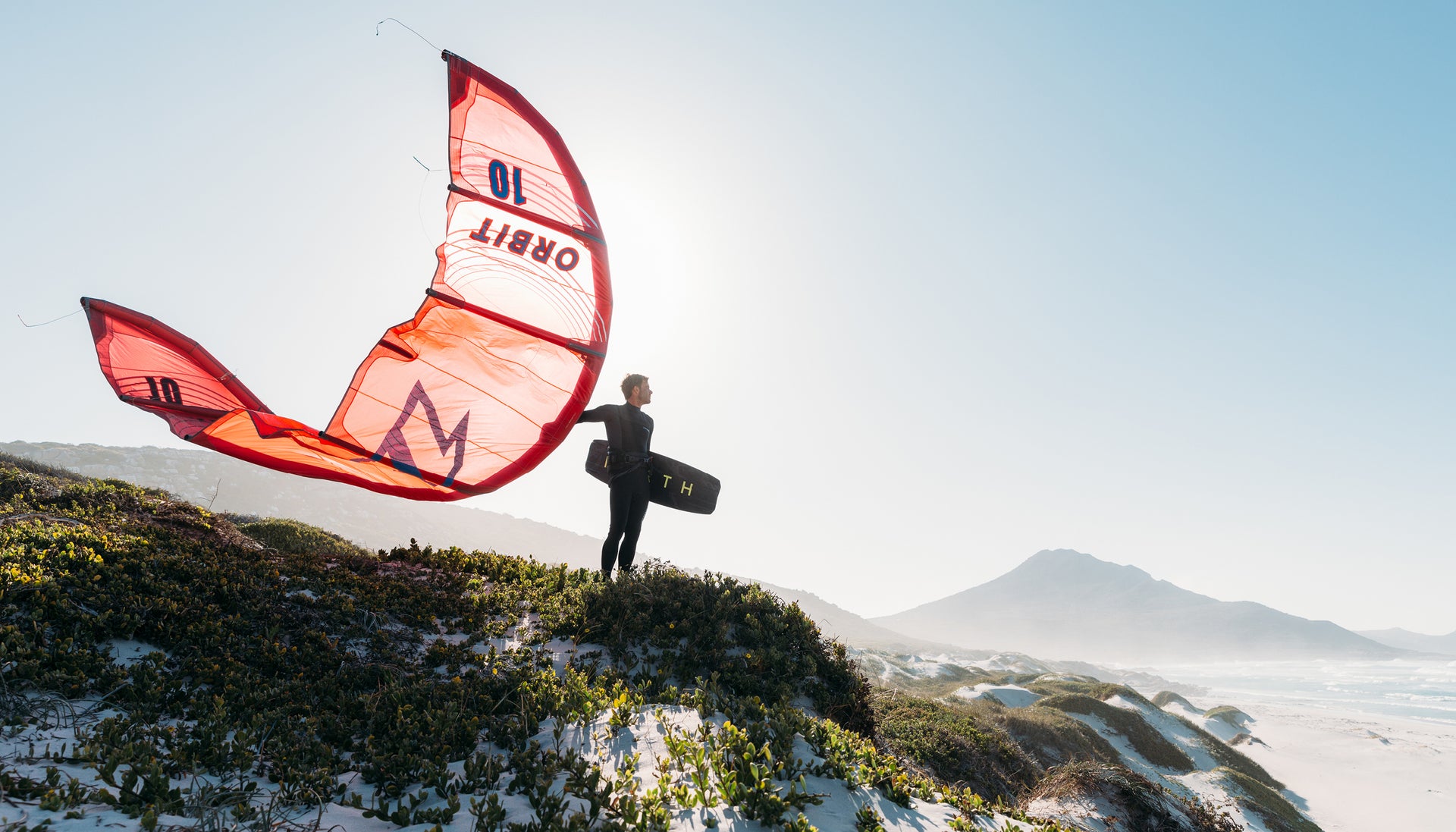
LOFT 57 PODCAST: CHANGING TACKS
In Episode 2, the North Sails podcast is joined by our friends from North Actionsports, the brand behind North Kiteboarding and North Windsurfing.
READ MORE
READ MORE
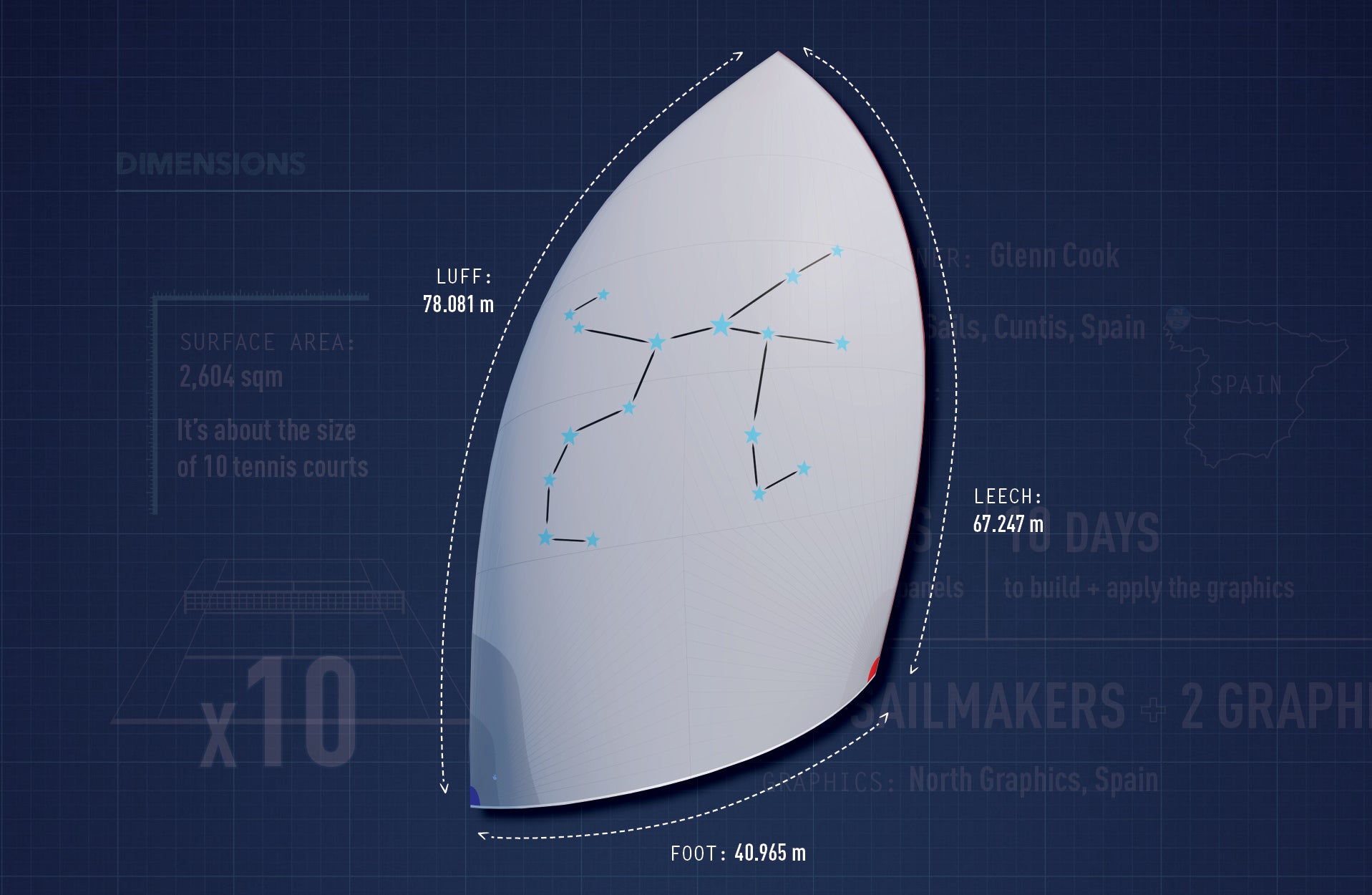
LARGEST SAIL EVER BUILT, PERSEUS^3 A2
MAKING THE WORLD’S LARGEST SAIL
Meet the Designer, Builder, and Cloth Supplier of the Superyacht Perseus^3’s New Spinnaker, a Sail the Size of 10 Tennis Courts
📸 Ryan Borne
“It’s substantially bigger than anything else out there,” says Glenn Cook in a typically measured fashion. The North Sails superyacht sail designer is calling from St Barth, where he’s testing the sail out for the first time, a process he says is both “nerve-racking” and “the best part of the job.”
Because to bring this 2,604 sqm A2 sail to life, it’s taken a lot of people, time, and resources.
In fact, it’s taken a design team in the US, an eight-week custom order from Contender Sailcloth and a team of 10 sailmakers and 2 graphic installers working over 15 days to build this sail.
“The boat was specifically looking for a target area from a rating perspective,” explains Cook. “So the design was driven by that. And because Perseus^3 is a huge boat (her length overall is 58.60m), you can’t turn very quickly and trimming adjustments are also slow, so we looked to make a sail that had a very stable flying shape. Plus the sail has to work across a variety of conditions. The design is more forgiving than you would do on a smaller sail.”
Handling issues drove the design, too: the luff is so long that it can drop into the water when gybing. “We developed a system above the tack to collect the sail and keep it clear of the water during a gybe.”
With no other sail of that size or real benchmark, the chosen base material is a Contender Sailcloth Superkote 350 – the top of their offering – and the ply patching a Superkote 250 to keep some weight off.
“These boats are huge, the loads that are involved are pretty exceptional,” adds cloth supplier Duncan Skinner, President of Contender Sailcloth USA. “We go from a fabric that weighs 32 grams per square meter up to something that weighs 150 grams for the Superkote 350 in this kite. As the weight goes up, the strength goes up and that’s what you need in a sail this size.
“The fiber selection comes first – it’s high-tenacity Nylon. Second, constructions, ie. how many yarns we weave in each direction. Once the fabric is woven, the finishing comes in – that’s the real trick. You have to dye the product first, then finish it. We finish it with a coating process that gives stability and zero porosity to the fabric. A well-proven chemical process that makes fabrics that withstand the kind of loads you see on these giant boats.”
Skinner smiles. “This thing is so big!”
Producing a consistent finish throughout is key to ensure the sail’s uniform performance. “On these big kites, the fabric is specifically engineered so that there is a little bit of elasticity built into it. That way, big shock loads don’t run back through the rigging and the boat itself – the kite absorbs a little bit of it.”
Surprisingly though, it’s the sail’s custom grey color that caused the most headache. “The coloring took us the longest because you can’t take that amount of material and dye it all at the same time. The machines just aren’t that big. You have to pay a lot of attention to the dye formulation and to the timing… and when you look at the kite, it’s pretty damn close! That was also very good on Manolo’s part when assembling the sail.”
Manolo Lastra’s loft in Northern Spain was the last part of this gigantic puzzle.
“It took about eight weeks to receive the material,” says Lastra on the phone, explaining how they ordered around 400 linear meters extra to get the panel color right.
In total, his team received 3,323 linear meters of material divided into 48 rolls, used 3100, plus another 500 meters of the Superkote 250. With 3,500 sqm over three floors, Lastra’s team assembled the different sections step by step. And to fit the cutting tables, the sail has four sections across its foot, where most sails have two.
“Two people were cutting for five days,” says Lastra. “Once cut, the 850 panels were sorted by groups and sent to production to be assembled by sections. Then they went through the sewing machines.”
The parts were sewn separately before being put together. “That’s when we started adding the plies in the corners,” he adds. “That took 10 people and 10 days. Two more people were working on the graphics in parallel.
“Once the sail and graphics were done, it dried for four days, got folded, and shipped to Antigua.”
And it’s on the neighboring Caribbean Island of St Barth that we find Cook testing it out.
“I’m down here sailing with them for the St Barths Bucket this week. It took probably 16 people two hours to unfold the sail and put it into the spinnaker sock.”
At 550 kilos, did he try lifting it?
“We can’t!” he laughs. “We use winches on the boat. We can drag it, but that still takes 10, 15 people to move it.
“It’s big.”
READ MORE
READ MORE
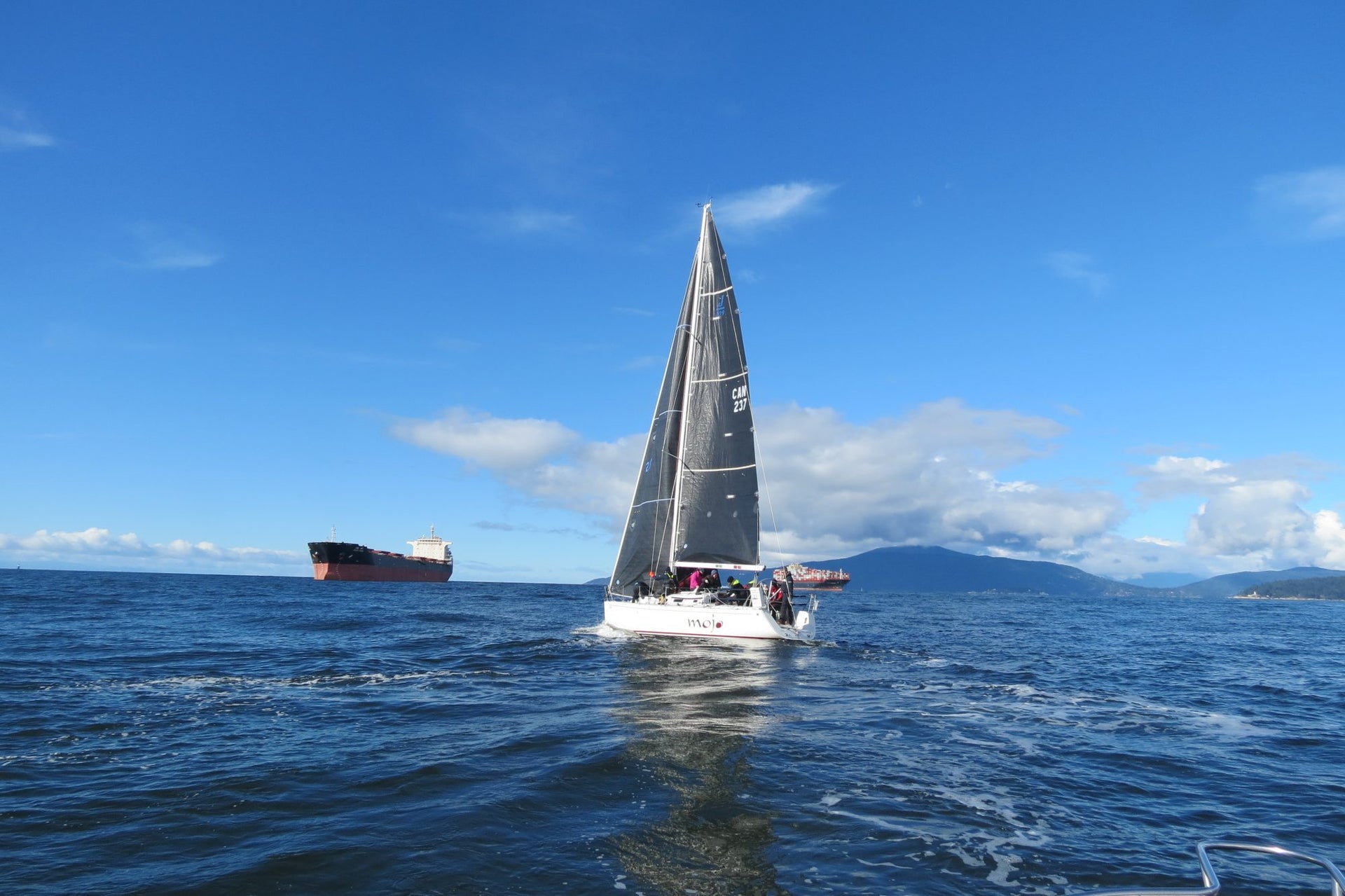
NORTH SAILS DOMINATES 2022 POLAR BEAR WINTER SERIES
NORTH SAILS DOMINATES 2022 POLAR BEAR WINTER SERIES
Exciting Racing For Vancouver Rowing Club
North Sails sponsored the 2022 Polar Bear series run by the Vancouver Rowing Club and it wrapped up this weekend with two final races. 43 boats were registered and raced over 4 Sunday's between February and March. Results were very tight which made for very exciting racing, some of the division winners were decided on the last leg on the final Sunday. Congratulations to North Sails customers who finished with podium spots.
Full Results here. Drew Mitchell from North Sails Vancouver was on the water taking video and pictures for the 2nd race of the series. He ran a webinar debrief and it can be viewed here.
PRO of the event Jennifer Ross shared, "We had 19 race committee volunteers join us on 4 different VRC member volunteered committee vessels. We had three different race officers run race days this year, including Kathy Parslow and Mike Hughes from WVYC. We had 45 boats register from 6 clubs. (Including 20 boats with a PHRF rating under 100, necessitating a split up into a new Div 0 this year).
North Sails Vancouver loft returned as the Polar Bear Series sponsor, continuing to provide support to the event and racers on and off the water. An assortment of North Sails swag from bags and belts to books was appreciated by door prize winners this year, won via ticket raffle during the reading of the day's results back at the club after racing."
READ MORE
READ MORE
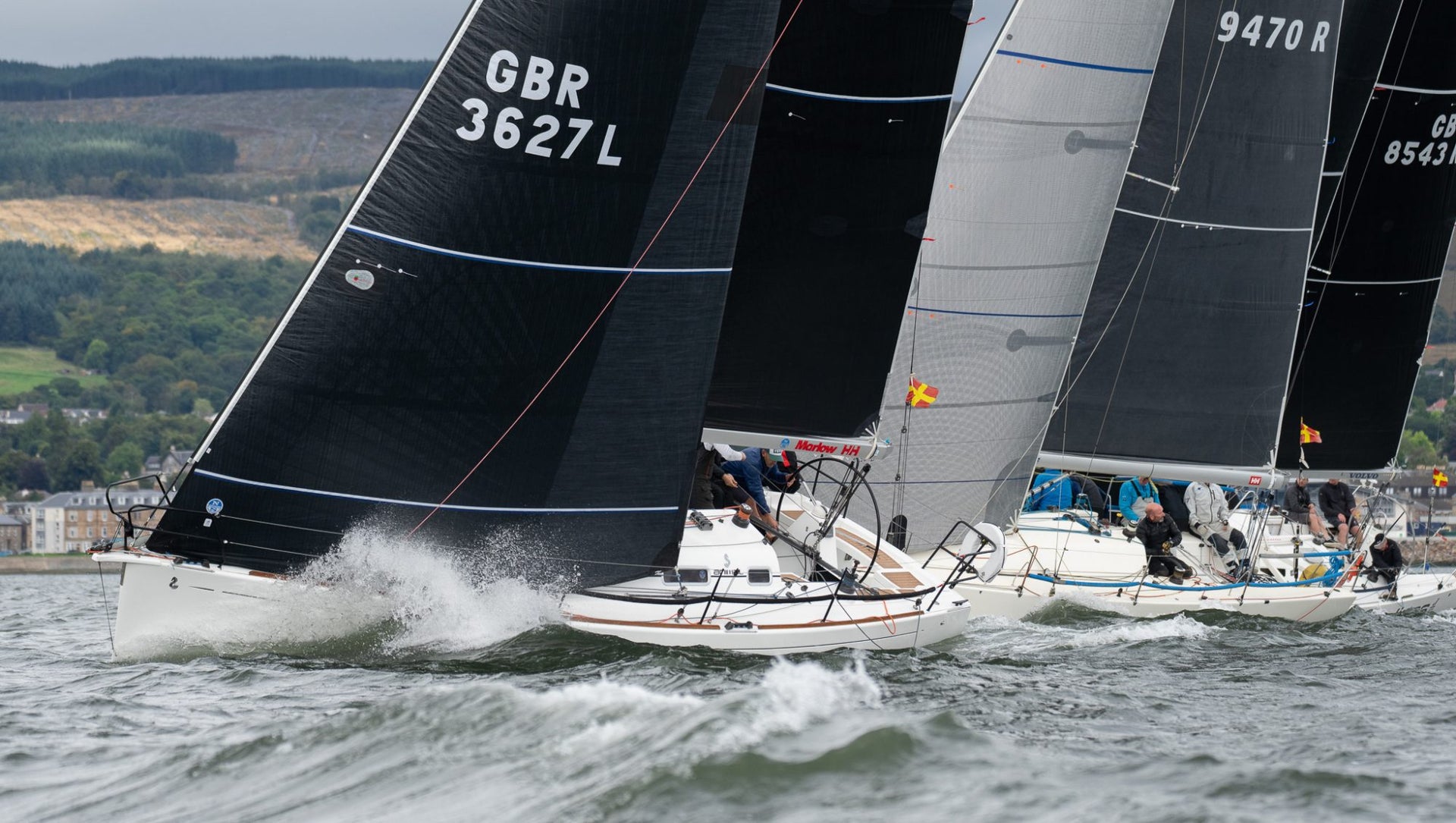
NORTH SAILS PROUD SUPPORTERS OF THE RC35 CLASS IN SCOTLAND
NORTH SAILS PROUD SUPPORTERS OF THE RC35 CLASS IN SCOTLAND
A Busy Season Awaits…
North Sails are proud to support the RC35 Class again for the 2022 season.
The RC35 encompasses Racer-Cruiser yachts in Scotland with an IRC Banding of 1.010 to 1.040. They also attract teams over from Ireland thanks to the Irish events on the circuit. The class is looking forward to a full season on the water, especially after a difficult two years due to the pandemic.
The Scottish IRC Championships at Scottish Series is at the beginning of June, so the class will be blowing away the cobwebs at their first event of the year in May – Kip Regatta. We spoke with Robin Young, Class Chairman and owner of J/109 Jings:
“The RC35 class are looking forward to getting back to Tarbert after two years away. With at least two new boats? to the class, everybody is chomping at the bit to battle it out on the spectacular waters of Loch Fyne. Of course, we are also looking forward to catching up with old friends in the local hostelries.
Jings – 📸 Neill Ross
Animal – 📸 Neill Ross
Reigning Scottish Series Overall Champion and three time RC35 Class Champion Animal will undoubtedly be the favourite. However, their rivals won’t make it easy for them as it looks to be another competitive and close series. With the fleet comprising of four J/109s, the ever popular class could present a new winner this season.
“The biggest improvement I see with 3Di is durability. On the 36.7 we have overlapping Genoas and with 3Di we are seeing double the life compared to string sails. With North we are fast and they last.” says Kevin Aitken of First 36.7, Animal (RC35 Overall Champions for the last 3 years powered by a full suite of North Sails 3Di RAW).
“It’s great for the RC35 Class to be associated with a sailmaker with such an impressive reputation worldwide. Also as a client with a full set of North Sails, I can vouch for the product quality and performance.” Robin continued.
With 80% of the fleet using North Sails, we are delighted to continue supporting the RC35 Class in Scotland. Tight competition and a vast array of racing venues means we cannot wait to see what the busy season ahead brings. Who will be crowned RC35 Overall Champion and who will pick up RC35 Celtic Cup?
2022 RC35 Events
RC35 Championship 2022, 6 events with 1 discard
14th-15th May – Kip Regatta
3rd-6th June – Scottish Series
23rd-26th June – Bangor Town Regatta
23rd-24th July – RC35 Championship Weekend
27th-28th Aug – Largs Regatta
10th-11th Sept – GSS/CCC North Clyde Regatta
RC35 Celtic Cup 2022, 4 events with 1 discard
14th-15th May – Kip Regatta
3rd-6th June – Scottish Series
23rd-26th June – Bangor Town Regatta
11th-15th July – Volvo Cork Week
READ MORE
READ MORE
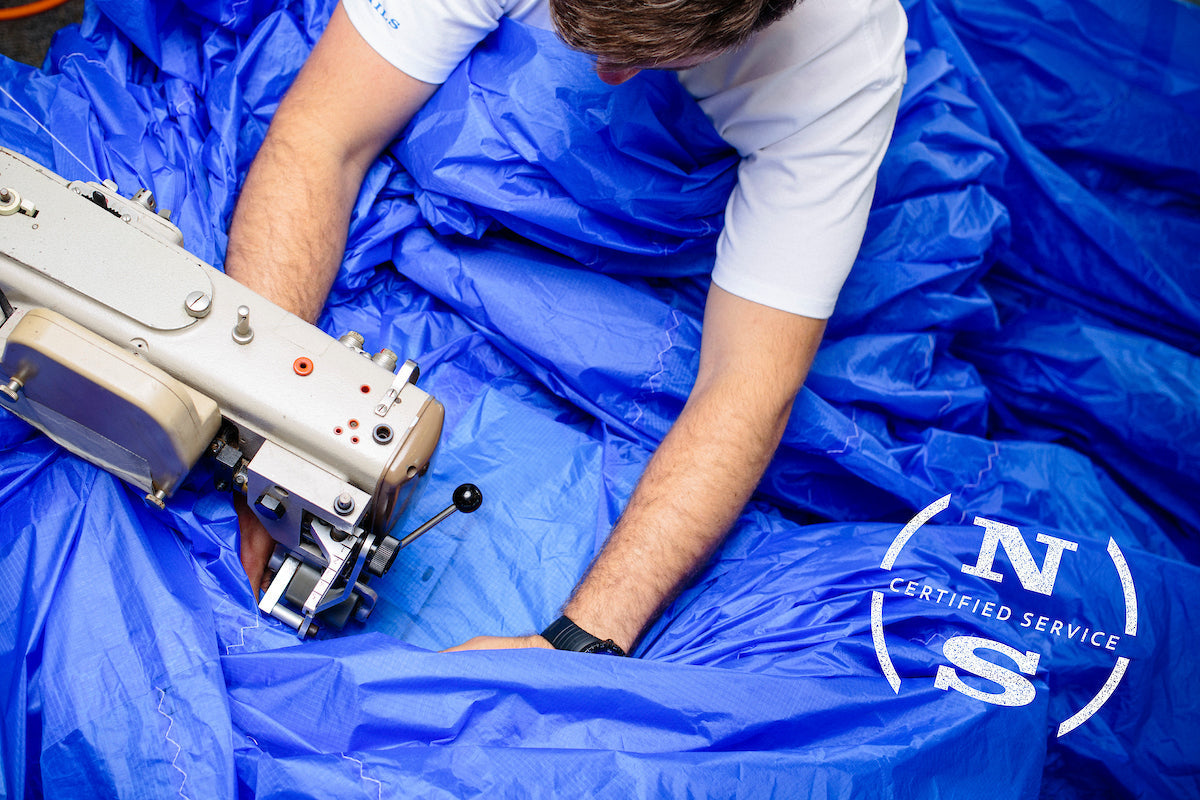
NORTH SAILS CERTIFIED SERVICE HAS YOU COVERED
NORTH SAILS CERTIFIED SERVICE HAS YOU COVERED
Summer Sail Service on the South Coast
This summer on the south coast of England, North Sails Certified Service will be available from our lofts in Gosport, Plymouth and Cowes. Our service loft in heart of Cowes Yacht Haven is now open every Monday and Thursday from 09:00 - 17:00. The loft has you covered for regatta support at the main events running out of Cowes throughout the season, kicking off with the RORC Easter Challenge on the 15th - 17th April. With our onsite team of experienced sailmakers, we aim to provide the best local service for you. With the summer season just round the corner and some teams taking advantage of the nicer spring weather, now is a great time to make sure your sails have been serviced. Having your sails inspected at least once a season can prevent small problems from becoming big ones. Whilst this may serve as a reminder to get your sails serviced by the professionals, here are some tips for you to make sure you and your crew are looking after and getting the most out of your sails.
📸 Tim Wright
SAIL CARE & MAINTENANCE TIPS
Use your sails in their designed wind ranges. If you don’t know the recommended wind ranges for your sails, contact your North sailmaker. When leaving the boat, ease the jib halyard, main halyard, and outhaul to prevent permanent luff and foot stretching. Releasing batten tension also reduces distortion at the batten ends. Limit exposure to the sun for extended periods of time. UV rays are one of your sail’s worst enemies. Roller furling genoas should have UV-resistant material covering the leech and foot. If you store your mainsail on the boom, make sure it is always covered when not in use. Rinse your sails with fresh water and dry thoroughly before storing, to prevent mildew and colour bleeding in spinnakers. Rinse fittings in fresh water to help prevent corrosion. Store dry sails in a well-ventilated location. And remember, making sure they are dry is as important as the initial rinse. Wet sails create mould issues. Avoid folding sails on the same fold lines so that small creases don’t become permanent. Regularly rinse sail bag zippers or lubricate with silicone spray. Patch minor tears as soon as possible with a pressure sensitive adhesive (PSA). Avoid using duct tape! Check nylon/polyester downwind sails a few times each season for small tears. Catching small holes early can reduce the chance of them becoming bigger tears. Spray luff tapes on both genoas and mainsails as they slide up the track, using a Mclube-style lubricant. This will help clean the tracks and make hoisting and dropping easier. Have your North Sail Certified Service expert inspect your sails at least once a season. Regular inspection will prevent small problems from becoming big ones. Ask your local loft to create an onboard sail repair kit for your specific sails.
Opening Times
Gosport- Monday-Friday | 0900-1700
Cowes Yacht Haven- Monday and Thursday | 0900-1700 + key regatta weekends
Plymouth- Monday – Friday | 0900-1730
READ MORE
READ MORE
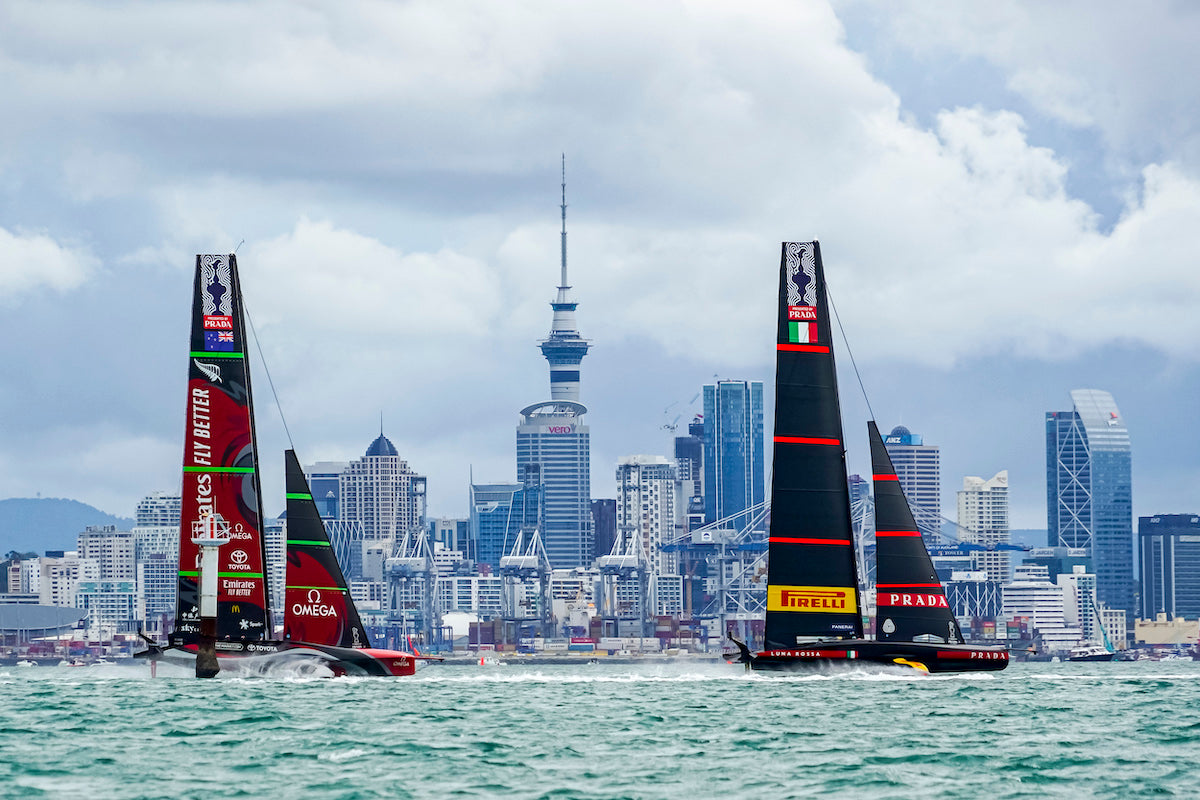
HUR MYCKET STRYK TÅL EGENTLIGEN ETT RACINGSEGEL?
Hur mycket stryk tål egentligen ett racingsegel?
En titt på utvecklingen i några av världens tuffaste kappseglingar
📸 Studio Borlenghi
Kappsegling på högsta internationella nivå har utvecklats enormt mycket på senare år. Båtarna är snabbare än någonsin och bjuder på spektakulära scener som kan få adrenalinet att rusa även hos den som bara följer seglingarna från TV-soffan.
I senaste America’s Cup fick vi exempelvis se de 23 meter långa och 6,5 ton tunga båtarna bokstavligt talat flyga fram i farter på upp mot 50 knop. Liknande scener utspelades ungefär samtidigt under Vendée Globe, där de 18 meter långa IMOCA-båtarna dundrade fram över världshaven i farter som ibland närmade sig 40 knop.
Båda båttyperna är extrema kolfiberbyggen utrustade med foils som lyfter skrovet ur vattnet och möjliggör de höga farterna. Men i övrigt är de varandras motpoler: Om America’s Cup är motsvarigheten till Formel 1-seriens sprintrace så kan Vendée Globe liknas vid att köra Paris-Dakar utan ett enda pitstop.
En America’s Cup båt har en besättning på elva personer, ett race tar sällan mer än en halvtimma, banan ligger på skyddat vatten och man seglar inte i över 21 knops vind (knappt 11 m/s).
Vendée Globe är en solokappsegling nonstop runt jorden. Det 24000 sjömil långa racet tar ungefär tre månader att segla och under resans gång passeras några av världens mest stormdrabbade farvatten.
Bara att ta sig i mål är en bedrift. Av de totalt 165 seglare som deltagit sedan starten 1989 har bara 88 lyckats fullfölja. Övriga har tvingats uppsöka nödhamn eller räddats under dramatiska former från sjunkande eller kappsejsade båtar.
Att Vendée Globe utsätter seglarna och all utrustning för oerhörda påfrestningar är närmast ett understatement. Det gäller inte minst seglen. De måste tåla stormarna i ”The Roaring Forties” och vid Kap Horn. De måste tåla hettan vid ekvatorn och kylan utanför Antarktis. Och de måste tåla det fladder och den omilda behandling som är ofrånkomligt när en ensam, ständigt trött person måste sköta allting ombord.
📸 Pierre Bouras
3Di – en unik segelteknologi
North Sails har sedan länge en dominerande ställning i egentligen all kappsegling på internationell toppnivå. Det är bara att titta på resultatlistorna. I senaste America’s Cup var det bara en båt som inte hade North-segel, och det var den som först eliminerades från tävlingen. Och i Vendée Globe var 75 procent av de 33 startande båtarna – inklusive de åtta första i resultatlistan – utrustade med North-segel.
En anledning till populariteten hos världens kappseglare är det som North Sails kallar 3Di. Det är en unik segelteknologi som bygger på helt andra principer än de konventionella, filmbaserade segel som resten av branschen förlitar sig på. Den största skillnaden är just att ett 3Di-segel inte innehåller någon mylarfilm. Det är istället en kompositkonstruktion och seglet byggs på samma sätt som ett båtskrov eller en kolfibermast: Riktad fiber, tunn som ett hårstrå, mättas med ett tvåkomponents resin och läggs upp i otaliga lager på en tredimensionell gjutform. Värme sätter igång härdningen och när det har härdat färdigt har de två materialen omvandlats till ett enda homogent material. Konstruktionen är extremt stabil, seglet kan inte delaminera och fiberhalten är nästan dubbelt så hög jämfört med ett konventionellt membransegel.
Resultatet är marknadens lättaste och stummaste segel. Men den kanske viktigaste skillnaden är att de även har en slitstyrka och en livslängd som andra prestandasegel inte kommer i närheten av.
📸 Jean Marie Liot Alea
Det finns ett 3Di-segel för alla typer av seglare
3Di-teknologin lanserades 2010 och var från början inriktad mot kappsegling. Men idag har vi tre olika typer av 3Di-segel som tillsammans täcker in i stort sett alla typer av båtar. 3Di OCEAN är utvecklat för cruising men levererar prestanda i nivå med konventionella, mylarbaserade racingsegel. 3Di ENDURANCE innebär ytterligare ett kliv uppåt på prestandastegen och har använts i allt från Gotland Runt till Volvo Ocean Race.
Och så har vi 3Di RAW. Modellen är utvecklad enbart för maximal prestanda och är strippad på allt som inte ökar farten. Här saknas bland annat de två yttre skyddande lager som finns på de andra 3Di-modellerna. Det gör 3Di RAW till världens mest potenta racingsegel alla kategorier, men det är inte lika robust och hållbart som de andra 3Di-modellerna.
Det kan man förstås stå ut med i America’s Cup, där 3Di RAW är det självklara valet. Intressant nog har seglarna i Vendée Globe nu kommit till samma slutsats. I senaste upplagan var det några som valde 3Di ENDURANCE, kanske för att verkligen vara på den säkra sidan, men de flesta förlitade sig faktiskt på 3Di RAW.
3Di RAW må vara det minst hållbara av våra 3Di-segel. Men jämfört med konventionella, mylarbaserade segel får det ändå betraktas som skottsäkert.
READ MORE
READ MORE
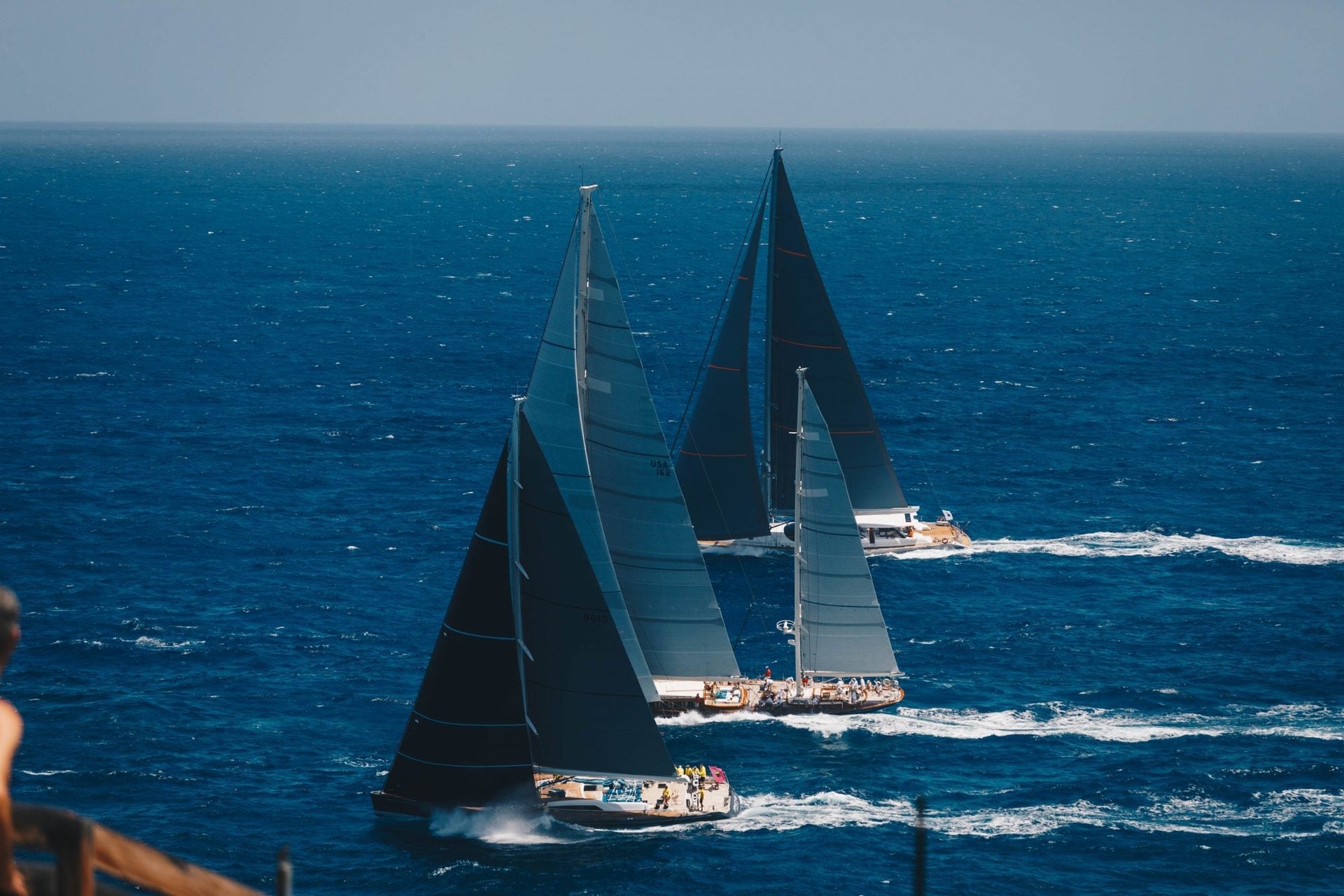
#NSVICTORYLIST: 2022 ST. BARTHS BUCKET REGATTA
#NSVICTORYLIST: 2022 ST. BARTHS BUCKET REGATTA
The Must Do Superyacht Regatta of the Winter is Back
The 35th edition of the St. Barths Bucket Regatta drew 30 magnificent boats to the starting line, 27 superyachts and 3 J Class boats graced the waters of the white-sand Caribbean island. 2022 celebrates the return of racing after a two-year hiatus due to Covid restrictions. In the end, North-powered teams piled onto the podium and claimed 60% of the total podium positions, including overall winner Hetairos.
The Bucket also marked the debut of Perseus^3’s new North Sails 2,604 square meter A2. This spinnaker is the largest sail ever built with sail area equivalent to approximately 10 tennis courts!
📸 Ryan Borne
Getting back to Bucket racing was a welcome treat for everyone participating: owners, crews, North Sails, and sailing fans worldwide. The St. Barths Bucket Regatta is an all-hands effort for North Sails whose event support was evident both on and off the water. There were close to 20 North experts sailing as crew, and our Palma-based superyacht service team ran an on-island pop-up loft to ensure all participating yachts were race-ready throughout the four-day regatta.
📸 Atila Madrona / Corinna Halloran
Noteworthy Regatta Shoutouts:
Herairos won both her class, and the Hermès Bucket Trophy for her overall regatta win. This is the second consecutive victory for the 59.9 meter Dykstra ketch, who took possession of a new North sail inventory just weeks ago.
North CFO Andrew Schneider and Superyacht Expert Mike Toppa were on board for Rosehearty’s Class D first-place victory. Schneider has raced with and managed the yacht’s sail program for the last six events, resulting in four class wins.
North Technology Group Chairman Tom Whidden called tactics on Class C winner Kawil. Though high winds blew out the final day of racing, Whidden was happy with the team’s result. “It’s not the ending we wanted, but it’s the results we wanted, so how are you going to do better than that?”
📸 Atila Madrona
The J Class got the most sailing in, with four races completed. 2022 was the first time the boats have participated in official class racing since 2019. North Technology Group President Ken Read was the skipper on Hanuman with a crew comprised of many familiar faces from his Volvo Ocean Race veteran teammates.
Sail Designer Glenn Cook and longtime program contributor Peter Grimm joined as race crew on board Perseus^3. We’re guessing both North experts held their breath for a few minutes as they hoisted the new A2.
Helix Downwind and Helix Upwind sails were prominently on display throughout the fleet, further proof that Helix Structured Luff technology has infiltrated superyacht sailing. While other sailmakers also promote structure luff sails, the revolutionary Helix design philosophy uniquely reaps the benefits of 3Di and is available exclusively from North Sails.
📸 Atila Madrona
Read more about the four-day event on the St. Barths Bucket Regatta website.
READ MORE
READ MORE
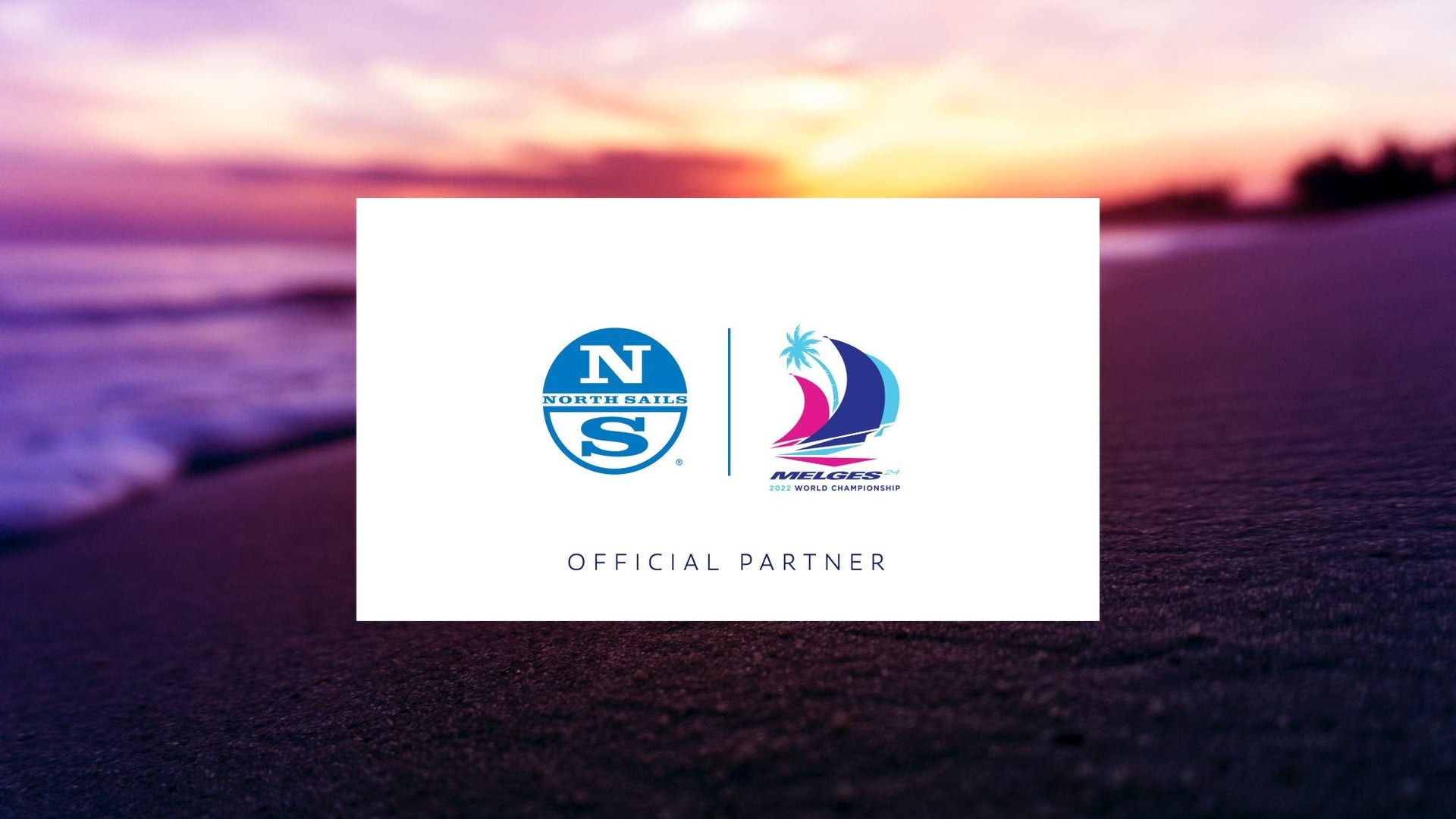
NORTH SAILS SIGNS ON AS OFFICIAL PARTNER TO THE MELGES 24 WORLDS
NORTH SAILS SIGNS ON AS OFFICIAL PARTNER TO THE MELGES 24 WORLDS
A Robust Support Program Planned for the Class Championship on May 7-15 at Lauderdale Yacht Club
The world’s leading one design sailmaker is proud to announce their participation as official sailmaker to the 2022 Melges 24 Worlds.
Matching the best products with the best support, North Sails will offer multifaceted educational support starting with a regatta prep webinar in advance of the event and hosting clinics on and off the water during the 2022 Melges 24 World Championship. Our expertise and experience in the Melges 24 class ensures racers will have in-depth, cutting edge knowledge at their disposal to improve their overall performance.
“We want to support those teams that can benefit from good coaching, but might not have the budget for it,” said John Bowden, a North Sails Melges 24 class expert. Constantly looking to push the envelope, both performance and design wise, John is the go to person for teams looking to leave it all out on the water. “I am the go-between for the sailors and our production and design team. It gives me a chance to work on a product and see how it helps our teams.” Bowden is looking forward to sharing his fleet specific tips with competitors leading up to racing in a pre-event webinar.
Bowden, alongside Taylor Canfield and Mike Buckley have an unparalleled depth of class experience. Together these three will be at the sailors’ disposal during the webinar in April, and Bowden will be onsite for the event with on-water and post-race support. Racers can assess their daily performance while gaining insight and tuning tips from Bowden during shoreside debriefs. These contributions are sure to raise the level of competition.
North Sails Support Schedule:
Tuesday April 5: Pre-Event Webinar - John Bowden, Taylor Canfield and Mike Buckley will cover regatta prep, long and short term preparation for the Worlds.
Tuesday May 10: Practice Day 1 - On-water coaching followed by shoreside debrief featuring photo & video analysis
Wednesday May 11: Practice Day 2 - On-water coaching followed by shoreside debrief featuring photo & video analysis
Thursday May 12: Race Day 1 - Shoreside debrief featuring photo & video analysis
Recently North Sails Melges 24 teams have been topping the leaderboards in events like the Bacardi Series, North Americans, and Charleston Race Week. The 2022 Worlds allows North Sails experts to engage with sailors looking to get more out of their race days. Lauderdale Yacht Club Regatta Chairman Tom Lihan praised the partnership, “North Sails is helping level the playing field for more sailors, and we look forward to the competition.”
2022 Melges 24 World Championship Racing begins May 11 in Fort Lauderdale, with pro-teams and amateurs, taking to the water seeking victory. North Sails invites racers to get prepared for the race and sign up for the upcoming webinar today.
READ MORE
READ MORE
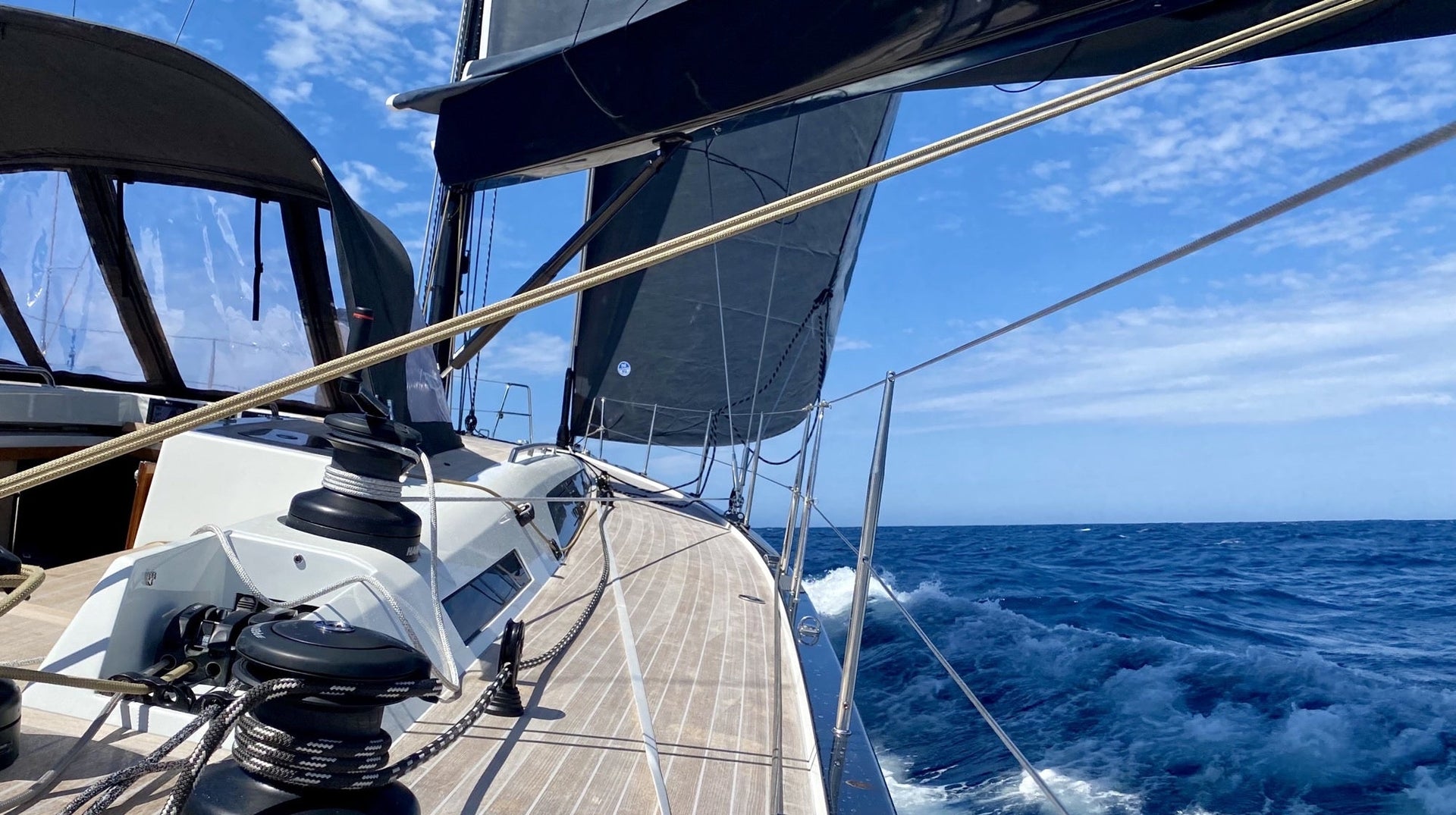
AUSTRALIAN SOLARIS 50 SALT SETS SAIL
North’s Aaron Cole Breaks Down Salt’s Custom Sail Design Package.
READ MORE
READ MORE
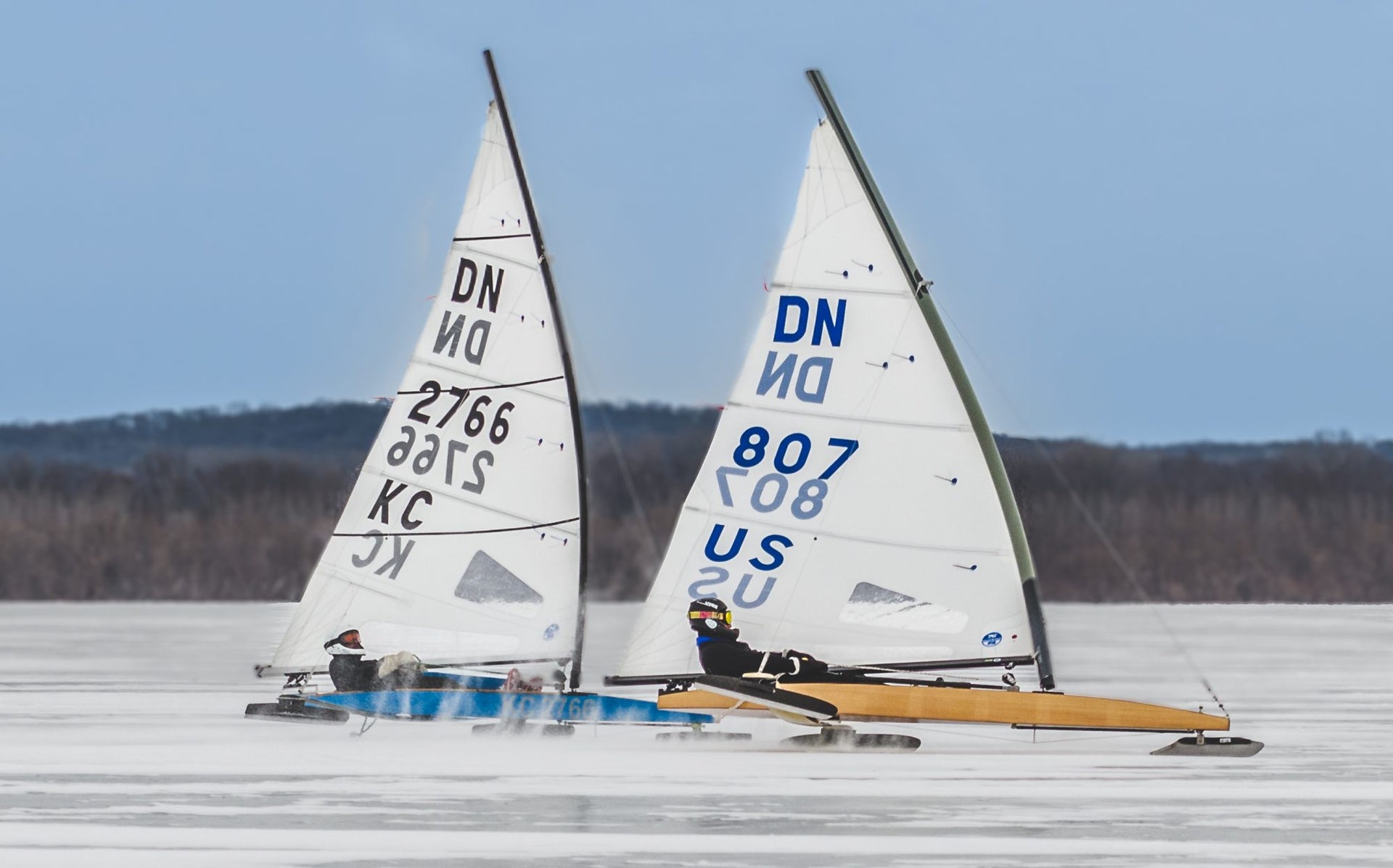
TRAILERS READY, BLADES SHARP
TRAILERS READY, BLADES SHARP
DN Sailing: In Search of Perfection
📸 Gretchen Dorian
Things happen fast in DN Iceboat racing—and we’re not just talking about whiplash turns, skid outs, or cheek-flapping straightaways. We’re talking about locations, too, as in where, when, and how races happen.
For “soft-water” sailors (yes “hard-water” sailing is ice sailing), planning a regatta is easy: pick a venue, nail a date, and pray for wind—but for hard-water racers, finding good ice, and better yet, scoring the rare combination of slick black magic with the right amount wind is up there with blue moons and flying pigs. More often than not, finding the ideal racecourse is a task darn near impossible, but for the nomadic and diehard ice yachters of the International DN class, it’s just another part of the sport. Our case-in-point is the most recent International DN Yacht Racing Association’s National Championship.
This past January, icemen and women gathered in Madison, Wisconsin, at Lake Monoma. The lake had good ice as far as the eye could see, but in the forecast was also an iceboater’s four-letter foe: snow.
“We knew it was coming,” says Deb Whitehorse, longtime DN Class secretary and treasurer who’s superpower is orchestrating a full regatta relocation mission from her kitchen table. “We gambled, hoping would be on the low side, but it ended up being more.”
Whitehorse and fellow DN class officers had two backups: Green Lake, about an hour and a half north of Madison, and Senachwine Lake, two hours south in Putnam County, Illinois. “Scouts” were dispatched to both locations and soon reported back: Green Lake was no good, and Senachwine was good enough. Scouts are higher-ranked DN sailors who know what to look for.
📸 Gretchen Dorian
“The first thing is ice conditions,” Whitehorse says. “There can be a little snow, but not too much. We can’t have too many hazards, heaves or cracks. It has to be a large enough area for a racecourse and have access to landings for people to get their trailers to it.”
Once Whitehorse gave word Senachwine was a go, the DN armada was en route from all points, and among them was DN newcomer Eric Doyle, a North Sails sailmaker of 30 years at the sun-kissed loft in San Diego. Doyle relocated to Minneapolis two years ago and promptly joined the DN scene. He hasn’t collected a garage full of stainless runners, planks, rigs, and sails yet, but it’s only a matter of time.
“It is, as they say, the sport of gypsies,” says Doyle. “They’re ready to go, ready to wait, or ready to change venues and drive six hours . DN sailors will do anything for good ice conditions because, when it’s right, it is by far the most fun sailing I’ve ever done. It’s just so fast, so effortless and so cool to take this little 12-foot boat and fly 25 to 30 miles per hour upwind. Then to go 40 downwind is really incredible.”
Doyle purchased his first two DNs last summer, a “woodie” from the 1960s and a “real race boat” from Rob Evans, his friend and mentor of all things iceboat racing. And like the erratic movements of DN regattas and the winter gypsies themselves, Doyle’s experience has been all things fast and unpredictable.
“I’m still learning how to get around the bottom mark,” says the Star World champion and sail designer with a distinguished career in one-design racing. “At the start, first you have to sprint—and I haven’t done any all-out sprinting since high school—and then you have to figure out how and when to jump into the boat smoothly. There’s a lot of technique involved.
“The bottom mark is really challenging because the boat starts to slide,” Doyle says.
Whitehorse bears witness to his early attempts: “I remember watching him try to figure it out,” she says. “It was very fascinating to watch.”
How so?
Well, there’s an art to going around the leeward mark, she says. “He spun out a few times. You kind of have to let out the sheet when you come around, and once he was told that, he got it immediately.”
“I just have to learn how to control it at the bottom, to have that smooth turn. There’s just this moment in time where, if you judge it wrong and you’re in that power zone… oh, man, it’s all on and you’re just sliding out of control. Plus, everyone who is waiting to start in the next fleet is there to watch you spin out,” says Doyle, who in his first DN National Championship appearance, finished fourth in Silver.
There was a fair bit on when Doyle and 54 other competitors eventually slid their three-bladed flyers onto the snow-streaked Senachwine for the first races of the Nationals in January. As a low-ranked newcomer, Doyle was automatically assigned to the Silver fleet, where he eventually faced the likes of Karen Binder, a petite museum executive director and past college sailor from Bristol, Rhode Island, who was winning every race. Binder, who is also relatively new to the class and a quick learner, is Gold Fleet material but bum luck with conditions in qualifying races relegated her to the Silver Fleet for the Championship.
“She works really hard at the technical parts,” Whitehorse says of Binder, one of several women at the top of the male-dominated class. “She’s only done it for a few years now but she works hard at it.”
Binder’s partner is James Thieler, who introduced iceboating to her in Rhode Island a few years ago. Thieler is the reigning North American champion, so one can only imagine the quality debriefs and knowledge sharing over the many daylong drives in search of good ice.
“Yes, it helps to have the right gear and the good people surrounding you,” Whitehorse says, “but Karen is the nut behind the tiller—she’s really good.”
“Karen and I had some really good battles on the last day,” Doyle says. “It was back and forth. She was too tough to beat and sailed incredibly well. That’s one cool thing about this class: I haven’t raced in big breeze yet, but in medium conditions it’s no problem at all for the women to compete at the same level. It’s about being smart and smooth and having good equipment and taking care of it. She had it down and smoked us.”
On the long drive home to Minneapolis, however, Doyle’s Senachwine experience cemented his new fascination with DN sailing. Yes, it’s unlike anything he’s ever done under sail but it’s the unpredictability of DN sailing that has his full attention. The parallels between sailing the boat and getting to the regattas is obvious to him, expressed in one rambling thought:
“Everything about it is much bigger… It’s the big ninety-degree course changes to keep the boat going. It’s the excitement of stopping, where if you stop, you have to get out and push, and while you’re doing that, there are guys still going 25 miles per hour and you’re thinking ‘oh man, I’m really losing a lot right now. And then there’s the whole thing with the regatta’s location. You’re in one place and then you gotta go somewhere else, but don’t worry, it’s only six hours. Just like the sailing, it all happens so fast. It’s just so cool.”
📸 Gretchen Dorian
READ MORE
READ MORE
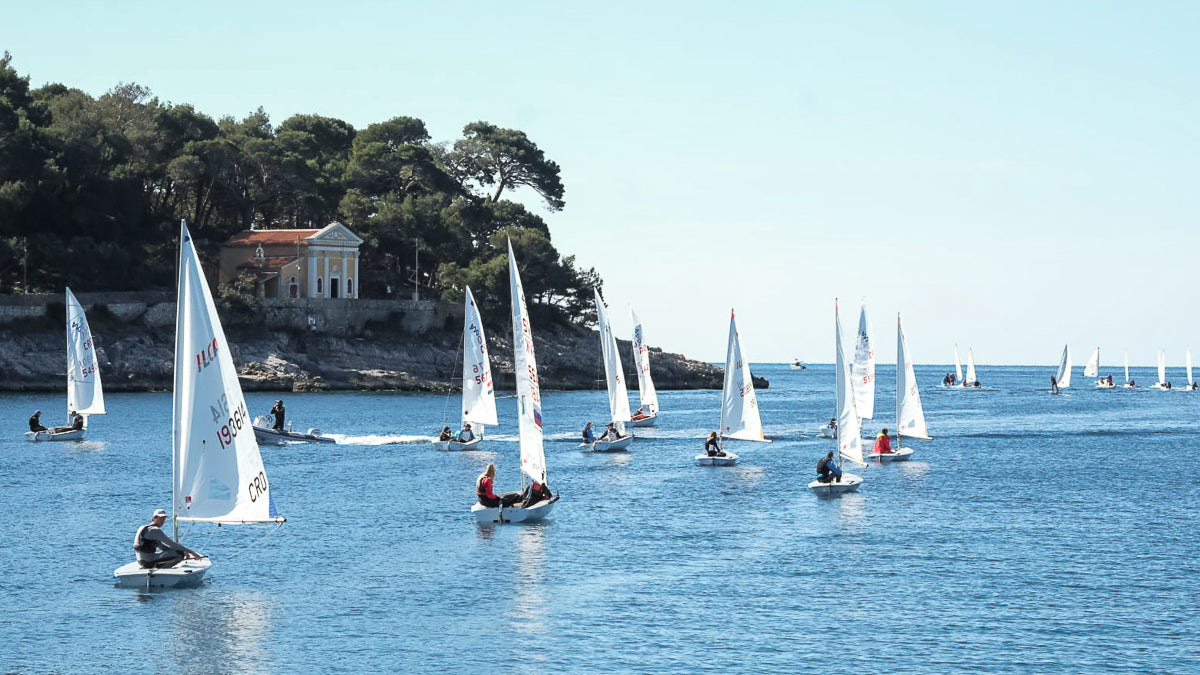
LOŠINJ SPRING CUP 2022 - 420 CRO NATIONALS
Lošinj Spring Cup 2022 - 420 CRO Nationals
📸 Zoran Matusan
Nakon duljeg vremena JK Jugo iz Malog Lošinja bilo je domaćinom nacionalnog prvenstva u klasi 420, a osim dvosjeda na regati su jedrili i kolege u jednosjedima klasa ILCA 6 i ILCA 7. Generalno jedna vrlo lijepa juniorska regata na koju je stiglo i nekoliko Ukrajinskih i Slovačkih posada.
Trajanje natjecateljskog dijela regate bilo je tri dana, od petka 11. pa do nedjelje 13. ožujka. Međutim, zbog vremenskih uvjeta jedrilo se samo u nedjelju kad je odrađen stvarno impresivan program!
Detaljno o događanjima na i oko regate ispričao je član Organizacijskog odbora Vedran Kabalin:
Regatu su obilježili i promjenjivi smjer i promjenjiva jačina vjetra, vrlo teški uvjeti, a u petak je stvarno bilo nemoguće bilo što napraviti. I subota je bila prekrasna kad se pogleda sa strane, ali ni tada nismo uspjeli organizirati niti jedan plov. Vjetar je stalno vrtio... puhalo je sa sjevera, pa je otišlo na zapad, pa na jugozapad... tako da je bilo stvarno nemoguće išta napraviti. Inače kad je svugdje u ostatku Kvarnera bura kod nas bude jedan bezvjetreni jezičac čija posljedica je bila vidljiva i ovog vikenda. Uglavnom, u subotu navečer mi iz Organizacijskog odbora nismo išli na spavanje baš opušteni, jer JK Jugo stvarno dugo vremena nije imalo na svom repertoaru bilo što drugo osim Optimista. Također ovo nam je bio i treći pokušaj organizacije ove regate, jer su nam prethodna dva propala zbog Korone. I stvarno smo htjeli da regata završi onako kako treba, pogotovo jer cijeli posao pada na leđa grupici volontera. Ali u nedjelju navečer više nismo bili napeti :) Tog trećeg jutra rano smo izašli na more, već oko 08:30, a prvi start bio je prije 10. Regate su tad išle jedna za drugom, te su ILCA 6 i 420 odradili po četiri plova, a ILCA 4 tri plova. Stvarno cmo bili vrlo zadovoljni što se toliko posla uspjelo napraviti, pogotovo kod klase 420. Ipak je u pitanju Prvenstvo Hrvatske i drago nam je da su natjecatelji dobili priliku odbaciti najlošiji rezultat. I ILCA 6 je dobila istu mogućnost odbacivanja najlošijeg rezultata, dok kad su ILCA 4 krenuli u četvrtu proceduru vjetar odlazi u desno i pada, pa su oni ostali bez te bonus opcije. Nažalost, zbog potrebe pakiranja i hvatanja trajekata flotu ILCA 4 odmah potom smo poslali na kopno jer su ipak najsporiji i kako nije bilo dosta vjetra njihovo jedrenje bi predugo trajalo.
Vedran Kabalin, JK Jugo
U klasi 420 nastupilo je 12 domaćih i jedna posada iz Slovačke i standardno u svim kombinacijama, čisto ženske, čisto muške i mješovite, bez nekog posebnog naglaska na niti jednu od njih.
Raspored snaga na kraju bio je sličan onome iz Zadra dva tjedna ranije na prethodnoj kriterijskoj regati. Iako nisu bile dominantne u svim jedrenjima, najbrže su bile članice Uskoka Noela Petešić i Petra Gambiraža. Najlošiji (odbačeni) rezultat bilo im je treće mjesto, dok je u skoru ostala pobjeda iz prvog plova i dva druga mjesta.
Iduća dva mjesta otišla su posadama iz JK Sveti Nikola iz Zagreba. Srebro su osvojili Ema Samaržija i Leon Scheidl, dok su se broncom okitile druga sestra Samaržija, Mara i njena flokistica Marta Mavar koje su i pobijedile u posljednjem plovu.
Najbolja čisto muška posada bila je iz Riječkog Galeba u sastavu Mark Maglica i Luka Kamber koja je bila najbolja u drugom plovu, dok je preostala pobjeda bila najbolji rezultat četveroplasiranih Mie Močinić i Mare Uroda Plevko iz Uskoka.
Analizom rezultata vidi se da su uglavnom pokazana dosta ujednačena jedrenja uz povremene bljeskove i "anti bljeskove", ali prosjek je na kraju i ovog puta pokazao pravo stanje one flote.
Druga najbrojnija klasa na regati bila je ILCA 6. Od njih 20 čak 12 je bilo dečkiju, ali svejedno zlato odnosi jedna od djevojaka. Najbrža je bila Ursula Balas (JD Val). U prvom plovu je prerano startala i zaradila je UFD, te je vrlo vjerojatno bila jedna od najzadovoljnijih što su se uspjela održati četiri jedrenja, pa se ovaj kiks mogao odbaciti. U iduća dva plova pobjeđuje, a u posljednjem ulazi kao treća iza Maxa Gjidere i domaće jedriličarke Dorotee Spišić.
Pobjedu u prvom plovu odnio je spomenuti svježi Labudaš Max Gjidera koji je ovu zimu u izvrsnoj formi. Najlošiji rezultat bilo mu je 8. mjesto, a suma ostalih rezultata osigurala mu je osam bodova što mu je bilo dovoljno za drugo mjesto u generalnom plasmanu!
Pet bodova iza Maxa završava mu klupski kolega Antun Tomašević koji broncu osvaja s jednim trećim i dva peta mjesta.
Treće mjesto u muškoj konkurenciji osvaja Ukrajinac Semen Khashchyna, nakon kojeg završavaju preostale dvije djevojke sa ženskog postolja... Dorotea Spišić (JK Jugo) i Petra Marendić (JK Mornar).
UFD kojeg je Ursula "osvojila" u prvom plovu nije bio jedini, a sličnom natjecateljskom žaru podlegli su još neki u tom i u idućem plovu. O kome je točno riječ možete vidjeti na ovom linku.
A najbrojnija klasa bila je ILCA s najmanjim jedrom - ILCA 4. U njoj je zajedno jedrilo 28 momaka i djevojaka, a situacija u vrhu bila je suprotna od one kod starijih kolega i kolegica. Generalnu pobjedu osigurao je član JK Vega, Tedi Leonardelli s najboljim rezultatom na cijeloj regati, koji pobjeđuje u sva tri plova!
U generalnom plasmanu članovi Vege uzimaju i preostale dvije medalje. Katja Rabak i Lea Rakovac su srebrena i brončana i predvode skupinu od pet djevojaka. Tek na 7. i 8. mjestu završavaju iduća dva najbolja jedriličara, Karlo Ugrin (JK Galeb) i Jan Komadina (JK Vega).
Na startu je i ova flota pokazivala znakove nervoze, ali sa značajno manjim brojem UFD-ova nego društvo iz flote ILCA 6.
Što se tiče kompletnih rezultata, njih možete pronaći na ovom linku, a vijesti iz Lošinja, obećaju iz JK Jugo, nastavit će redovito pristizati tijekom cijele godine. Po riječima Vedrana Kabalina imaju u planu još nekoliko regata što krstaša, što malih klasa u kojima ove sezone imaju raspoložene mlade snage - osim Dorotee Spišić koja je bljesnula u posljednjem plovu ILCA 6 flote, jednak rezultat ostvarila je i Barbora Čulmanova u posljednjem plovu flote ILCA 4 i time nadoknađuju izostanak Grigora Pettenera s regatnog polja koji je zbog zdravstvenih razloga morao od subote ostati doma.
READ MORE
READ MORE
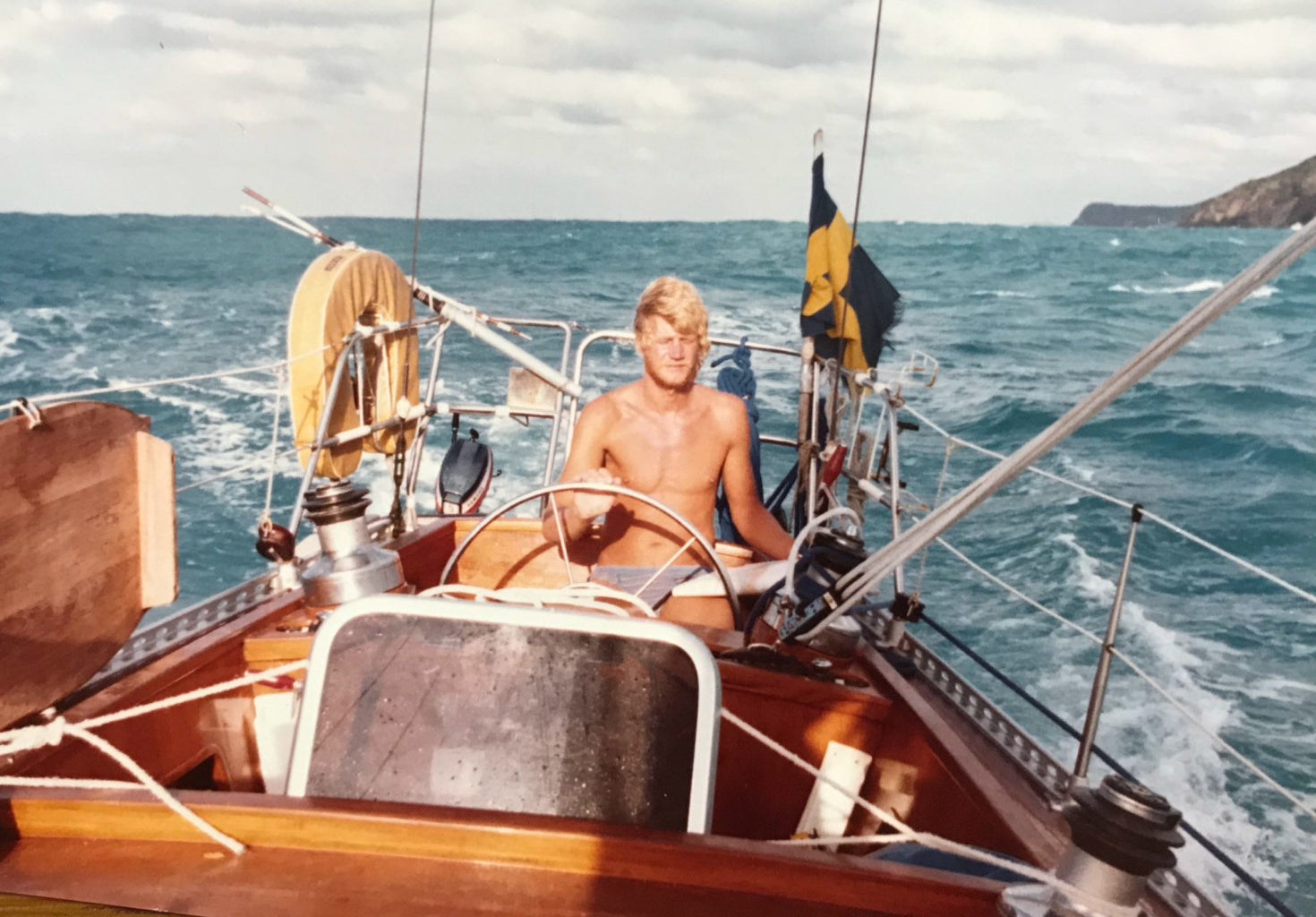
BERÄTTELSEN OM ARGO: DEL 1
BERÄTTELSEN OM ARGO: DEL 1
En Opal 46 som delats av tre generationer i familjen Ravelius
Efter många års segling med sin pappa på den älskade skonaren Argo har John Ingvar Ravelius blivit delägare i båten och äger den nu tillsammans med sin bror och sin pappa. Han har uppdaterat och utrustat henne med drömmen om att skapa nya minnen med sin unga dotter och föra familjetraditionen vidare. I den här första delen berättar Ravelius om hur en segelbåt, och det arbete som följer med den, kan knyta samman tre generationer.
1974 var min pappa, Ingvar Ravelius, en 24-årig ung man som gick runt på båtmässan i Stockholm tillsammans med sin pappa och drömde om att segla jorden runt i en egen båt.
Ingvar hade stor erfarenhet av mindre segelbåtar, men tankarna på en jorden runt-segling gjorde att han ville ha en större och säkrare båt. När far och son gick runt på mässan stötte de på en vän som kände till en välrenommerad båtbyggare som höll på att bygga en båt som hette Opal 46. Det var det första av de blott sex skrov som skulle komma att byggas.
Ett par veckor senare kontaktade Ingvar konstruktören av Opal 46 och besökte tillsammans med sin pappa varvet där båten byggdes.
Efter att ha sett hur arbetet fortskred tog det inte lång tid innan min pappa bestämde sig för att det här var båten han ville segla runt jorden med, öppnade plånboken och betalade handpenning för hyra av formen. Detta trots protester från hans pappa, som inte trodde att den 24-årige Ingvar, som saknade erfarenhet av båtbyggeri, skulle klara av att bygga en sådan båt.
Min pappa svarade: ”Det här är båten jag vill ha, jag vet ännu inte hur jag ska bygga den men det ska jag ta reda på.”
Så påbörjades bygget av Argo. Ingvar gav sig på det slabbiga och tidsödande arbetet med att plasta skrovet. Han la på lager efter lager med tanken att han skulle ut på oceanerna och att skrovet måste kunna klara hårda slag och smällar utan att skadas. Tolv centimeter plast blev det på det tjockaste stället.
När skrovet härdat fortsatte han arbeta med båten utanför sitt hus i Sollentuna. Pappas grannar kunde inte veta att de skulle komma att bo bredvid ett båtbygge i sex år.
Ingvar besökte ofta varvet där den första Opal 46:an byggdes för att ställa frågor och ta mått. Han gjorde noteringar i ett anteckningsblock och åkte hem för att bygga sin båt på samma sätt som de professionella båtbyggarna.
Ett par år in på pappas bygge var det dags för sjösättning och dop av den första Opal 46:an. Pappa blev god vän med ägaren, och blev inbjuden att vara med på en Atlantsegling till Karibien.
1980 tog Ingvar en paus från byggandet av Argo för att korsa Atlanten med systerbåten. Under den här färden lärde han sig hur Opal 46 hanterar sjön men upptäckte också att det fanns sådant som han ville göra annorlunda på sin egen båt.
En av de saker som han gjorde annorlunda än i original var matbordet i salongen. Det var svårt att använda det under segling, så till Argo byggde han ett balanserat bord som håller sig horisontalt även när båten kränger.
Efter ett och ett halvt år återvände Ingvar från sitt seglingsäventyr och 1982 sjösattes Argo för allra första gången.
Sju långa år efter att han kläckte idén på båtmässan hade Ingvars dröm gått i uppfyllelse. Familj och vänner var med på den första provturen och alla firade. På Argos första resa höll de på att krocka på grund av en felkoppling i det hydraliska styrsystemet, men de märkte att hon var en sund och robust båt redo för nya äventyr.
Senare samma år deltog Argo och hennes besättning i Gotland Runt och en svensk båttidning publicerade en bild av Argo tagen under racet. Min pappa var väldigt stolt över att de använt en bild av hans bygge samma år som båten blev färdig.
Ingvar är en speciell person, och nu när Argo är mitt projekt också vill jag att alla detaljer ska bli perfekta. För några år sedan började pappa och jag bygga om och konvertera Argo till slup. Vi gav henne nya North-segel och nytt liv. När jag var liten brukade han visa mig en special metallfil och säga: ”Jag byggde Argo med den här filen”. Jag trodde honom inte, men nu när jag har arbetat mycket tillsammans med honom förstår jag att han verkligen gjorde det. Han byggde Argo med sina händer och sin metallfil. Han drog i varje skruv med skruvmejsel, och Argo har tusentals skruvar. All teak på Argo, på däck såväl som i inredningen, är gjort av råsågade teakplankor som han sågade till utanför sitt hus i en Stockholmsförort.
Håll utkik efter nästa del i historien om Argo, där Ravelius berättar om hur han som ettåring seglade runt i Medelhavet med sina föräldrar.
READ MORE
READ MORE
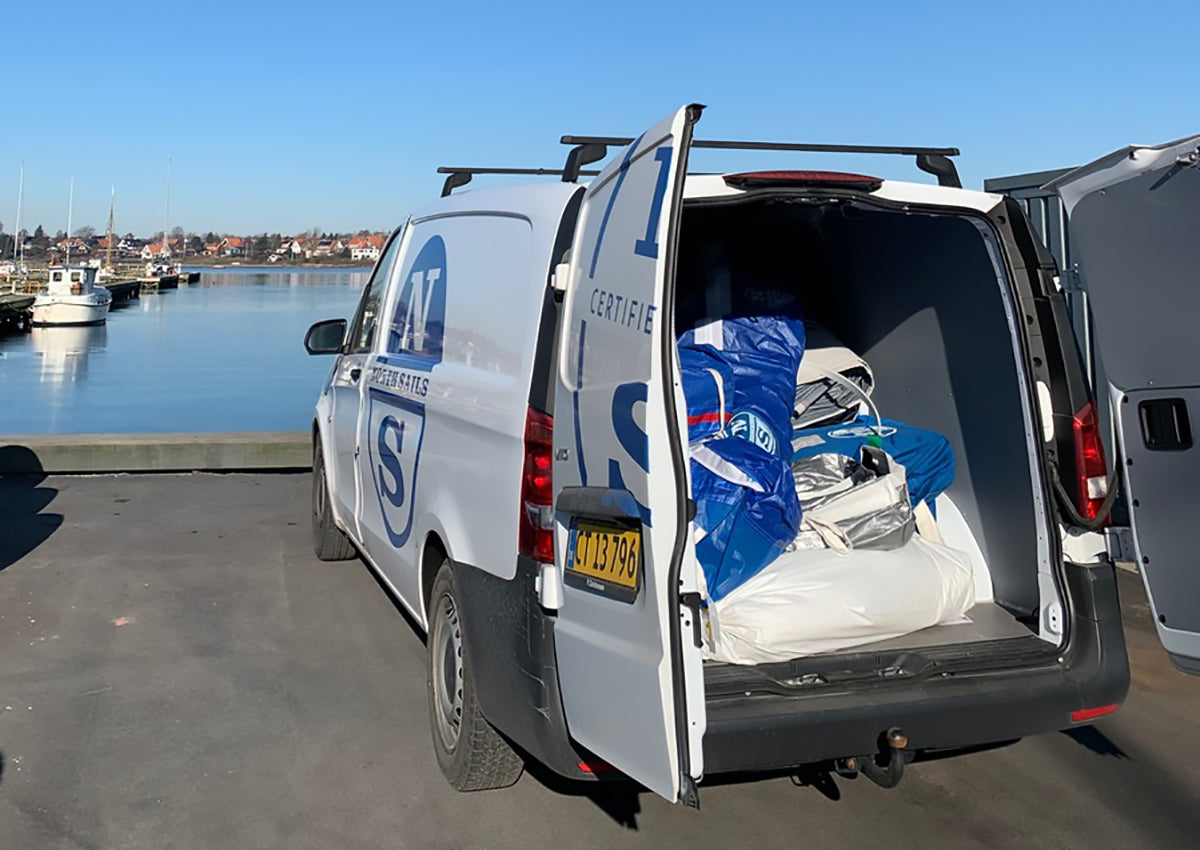
TRAVLE DAGE PÅ SEJLLOFTET I KØBENHAVN
TRAVLE DAGE PÅ SEJLLOFTET I KØBENHAVN
Masser af nye sejl bliver leveret til vores glade kunder og der er ligeledes en stor mængde service sejl, der bliver færdiggjort inden den nye sejlsæson starter.
Vi har som sædvanligt modtaget rigtig mange sejl fra lokale kunder i Københavnsområdet, og vores afhentningssteder rundt omkring i Danmark er blevet brugt flittigt af masser af kunder til at aflevere sejl til service.
Vi kommer i år til at servicere omkring 500 sejl, nogle med små og og nogle med store reparationer, og det er altid en fornøjelse at levere "friske" sejl til vores kunder. Generelt tager vores kunder sig godt af deres sejl, men vi vil gerne minde alle om at følge disse 9 gode råd, som vil forlænge levetiden på sejlene:
1. Undgå at sejlene blafrer langvarigt, da det kan nedsætte sejlenes levetid betragteligt. Undgå at sejle for motor i modvind med blafrende sejl.
2. Brug dine sejl i deres designede vindområder. Hvis du ikke kender de anbefalede vindområder for dine sejl, skal du kontakte os her hos North Sails.
3. Når du forlader båden, skal du lette faldspændingen og udhal for at forhindre at sejlet bliver overstrækket.
4. Undgå foldning af sejl på samme foldelinjer, hvilket forhindrer at små folder ikke bliver permanente.
5. Beskyt dine sejl mod sollys med en presenning og lad dem blive i posen så længe som muligt.
6. Skyl dine sejl med ferskvand og tør dem grundigt inden opbevaring, for at undgå mug. Dette kan også gøres løbende gennem sæsonen.
7. Skyl fittings på sejlene i ferskvand for at forhindre korrosion. Opbevar tørre sejl på et godt ventileret sted.
8. Gå jævnligt sejlet efter for slidtage.
9. Send dit sejl til eftersyn og service hos North Sails efter hver sæson.
Håber I alle får en dejlig sejlsæson på vandet, og hvis I har spørgsmål til sejl, trim etc., så er I altid velkomne til at ringe her til loftet.
God vind!
READ MORE
READ MORE
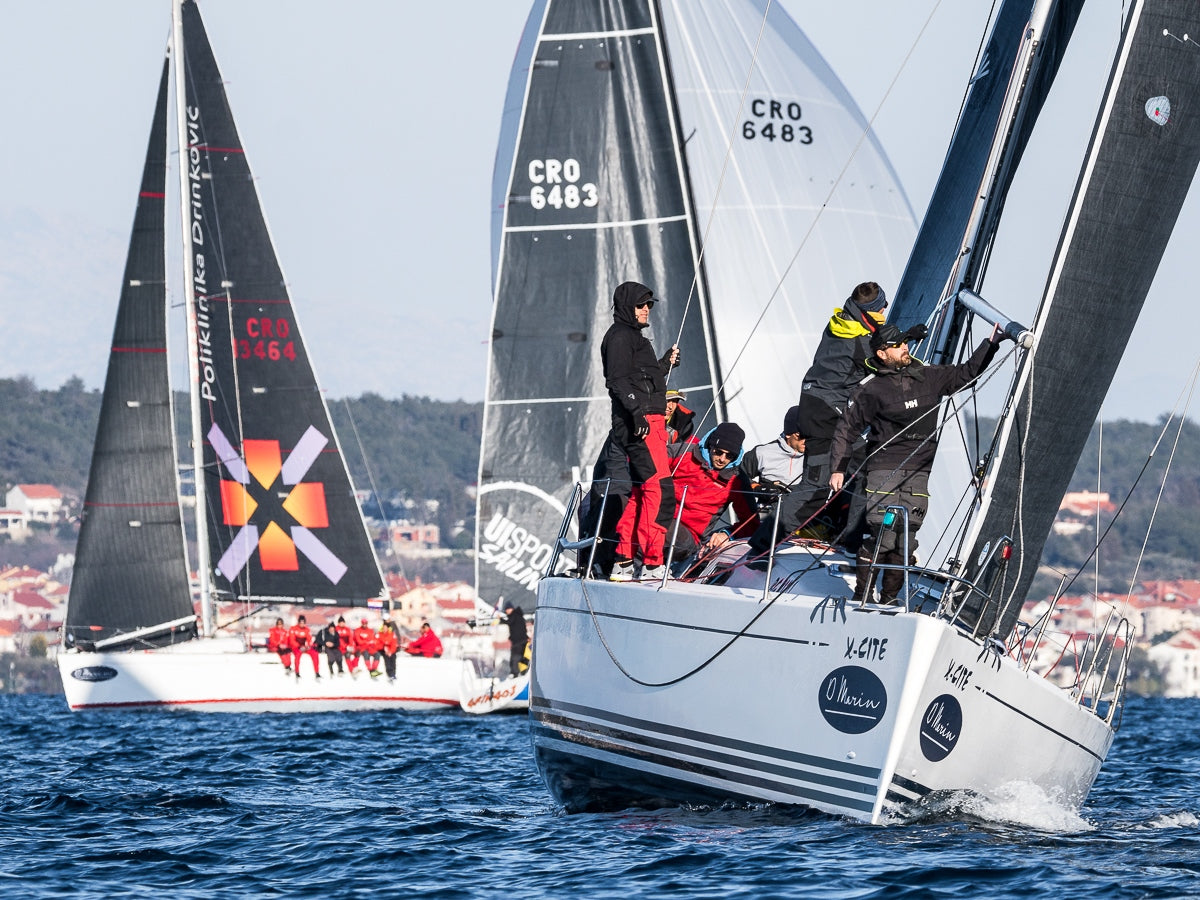
ZADAR ORC CUP 2022.
Zadar ORC Cup 2022.
Otvaranje ORC sezone u Zadru ponovno su zajedničkim snagama organizirali JK Uskok i generalni sponzor CRO ORC Cupa, tvrtka D-Marin, odnosno njihova marina Borik. Za razliku od lani na regati nije sudjelovalo deset jedrilica, već sedam, a i nije bilo jakog vjetra poput juga koje je puhalo prvog dana regate 2021., već je sve prošlo u znaku laganih povjetaraca.
Sudionici su bili uglavnom standardni koje viđamo na ovom tipu regata, a izostale su samo posade na manjim jedrilicama sa Splitskog područja i Mr.J kojem nije na vrijeme završio sezonski remont, te Damaco koji je planira sezonu otvoriti s idućom regatom koja je po rasporedu u Šibeniku.
Vremenski uvjeti u Zadarskom kanalu bili su idilični za promatrače s kopna, ali za boravak na moru trebalo se opremiti dodatnim toplim slojem odjeće. Zubato sunce sjalo je i u subotu i u nedjelju i stvaralo je iluziju topline koja bi bila rasplinuta prvim refulom koji je donosio hladnoću.
Prvi plov u subotu trebao se jedriti po burici koja je puhala s rubnom snagom od 6-7 čvorova. Regatno polje postavljeno je ispred Puntamike s bovom od orce skoro ispred lanterne na istoimenoj lokaciji.
Predstartna procedura odrađena je u mirno i ugodno, ali kako se flota udaljavala od startne linije tako je vjetar postupno gubio na snazi, da bi na oko pola distance do privjetrinske oznake RO morao označiti prekid jedrenja.
Kako se već značajno približavalo podne RO je htio odmah reagirati i s obzirom na trenutnu neizglednost za poboljšanje situacije po pitanju osiguravanja regularnih uvjeta za jedrenje u štap polju odlučeno je da se pribjegne rezervnoj varijanti a to je jedrenje navigacijskog plova.
Ponovno se pokrenula startna procedura nakon koje se trebalo zajedriti prema Ošjaku i Mišjaku, otočićima uz obalu Ugljana, ali dvije minute prije njenog isteka RO prekida odbrojavanje. Razlog je bilo ubrzano približavanje značajnog "raza" sa zapada.
Tamna crta svježeg vjetra obećavala je da će se ipak formirati uvjeti za ono po čemu je ORC specifičan, a to je tehničko jedrenje u štap polju. Vrlo brzo su kurs seterice Anđi i Rita postavile polje, te se po 7-8 čvorova zajedrilo u kursu 320°.
Ovaj start bio je dosta dinamičniji od onog s početka dana. U posljednjih minut - dva čak tri jedrilice priuštile su publici na leutu RO-a glasnu predstavu nakon koje nije nitko podigao protest. Posljedica je bila da su dvije jedrilice prestupile i da su se morale vratiti i ponovo startati, te su se tim potezom sebi značajno smanjile šanse za dobar rezultat s obzirom da je u ovom tipu regate doslovno važna svaka sekunda.
Za razliku od njih ekipa s Gringa 3 odjedrila je svoju regatu sezone. Oni su od početka bili u svakom pravom dricu i maksimalno su iskoristili svaki reful, te u cilj ulaze s impresivnom prednošću od 5 minuta u odnosu na drugoplasiranog Filipa. Međutim, nakon ubacivanja brojeva u ORC kalkulator Uskokova posada doživljava hladan tuš. Matematika je pokazala da su kasnili čak 4 korigirane minute iza X-Citea!
Razlog ovako, slobodno se može reći, šokantnom rezultatu je J0 koji je ostao prijavljen u popisu jedara, a čija upotreba je bila moguća po polarnim dijagramima i ovogodišnjoj verziji ORC formule. Zanimljivo je da je potpuno jednak "sail inventory" bio i u prošlogodišnjoj verziji Gringove svjedodžbe, ali tad ova situacija nije bila moguća.
Slučaj je prijavljen glavnom ORC službeniku u Hrvatskoj, pa sad treba vidjeti da li će dodatna analiza ovog slučaja natjerati "centralu" na neke poteze. U svakom slučaju, Gringo je penaliziran s ovim jedrom baš u dijelu polara koji se odnose na vjetrove koji su puhali za vrijeme prvog plova, dok ga se više ne uzima u obzir kod vjetrova jačih od 8 čvorova. Vjerojatno bi od velike koristi bio u slučaju da je vjetar na regatnom polju tijekom jedrenja otišao u jednu stranu i da ga je posada mogla na vrijeme otvoriti ili da se jedrila navigacija s jednom od etapa u kursu neke laške orce... međutim, zajednički zaključak svih nazočnih na regati bio je da se u ovom slučaju kao zaključak nameće da je možda u pitanju pogreška ekipe iz ORC-a zadužene za redovne godišnje nadogradnje "formule".
Idući plov startao je nakon pauze od desetak minute nakon ulaska posljednje jedrilice u cilj. Ovog puta orca je skraćena par kabela. Razlog je još slabiji vjetar i očekivanje da bi ubrzo mogao skroz oslabiti.
Na samoj startnoj liniji nije bilo gužve kao za vrijeme prethodne procedure i dosta čisto se krenulo prema sjeverozapadu. U rasporedu sličnom onom iz prethodnog plova flota obilazi privjetrinsku oznaku i offset, a za vrijeme jedrenja etape niz vjetar ovaj odlazi desetak stupnjeva u lijevo te se mora reagirati s Charlijem. Osim postavljanja novog kursa druga orca je i dodatno skraćena.
Borba za čelo flote ovog puta malo je zanimljivija, jer su se Gringo 3 i Filip dosta nalazili jedan uz drugog, a ovaj dvoboj traje do samog kraja i finiša u kojem je Gringo 3 za tri realne sekunde brži od Filipa, dok nakon korekcije ta razlika ide u Filipovu korist i raste za dodatne tri minute.
Između ove dvije posade ponovno završavaju X-Cite i Mareus II, a Erco D', Sky i Elaya ponovno među sobom dijele peto, šesto i sedmo mjesto.
Nedjeljno jutro bilo je dosta hladnije nego subotnje, a prognoza je najavljivala lagano jugo koje je trebalo puhati cijeli dan. Od izlaska na more i kratkog čekanja ispred Puntamike vidjelo se da su prognostičari ovog puta precizni i da se ne može očekivati ništa jači vjetar nego što trenutno puše. Sreća u tome bila je da je bio skoro pa točno iz smjera Ošjaka, pa nije bilo potrebe da se nakon starta postavlja i dodatna privjetrinska oznaka.
Točno u 11:05 flota kreće s navigacijskim plovom i kao vrlo važan dio regate postaje izbor jedrenja bliže kopnu ili sredini kanala.
Većina sporijih jedrilica bira sredinu kanala i to se ovog puta pokazuje boljim izborom i flota do Ošjaka i Preka stiže u malom razmaku. Kao druga skupina, Gringo, Filip i X-Cite ipak stižu prvi do ove točke obaveznog obilaska, ali razlika nije bila tolika kolika bi bila da su se nakon starta svi odmah prebacili na lijeve uzde i zajedrili prema Ugljanu. U svakom slučaju na čelo ponovno izbijaju Gringo i Filip koji potom par milja jedre čisti match race.
Jedrenje bliže Ugljanu donijelo je Gringu svježiji vjetar te on prvi okreće Mišjak i ostvarenu prednost ne ispušta do cilja.
Ostale jedrilice u ravnomjernim razmacima slijede za njima i nakon okreta Mišjaka sa spinakerima i genakerima po najjačim refulima tog Zadarskog vikenda jedre prema cilju koji je posatvljen ispred Uskokova mula.
📸 regate.com.hr
Rezultati - ORC A & B
1. plov
2. plov
3. plov - navigacija
konačno
Statistika
STAT - 1. PLOV
STAT - 2. PLOV
Playbackovi
P L A Y B A C K - 1. PLOV
P L A Y B A C K - 2. PLOV
P L A Y B A C K - 3. PLOV - NAVIGACIJA
READ MORE
READ MORE
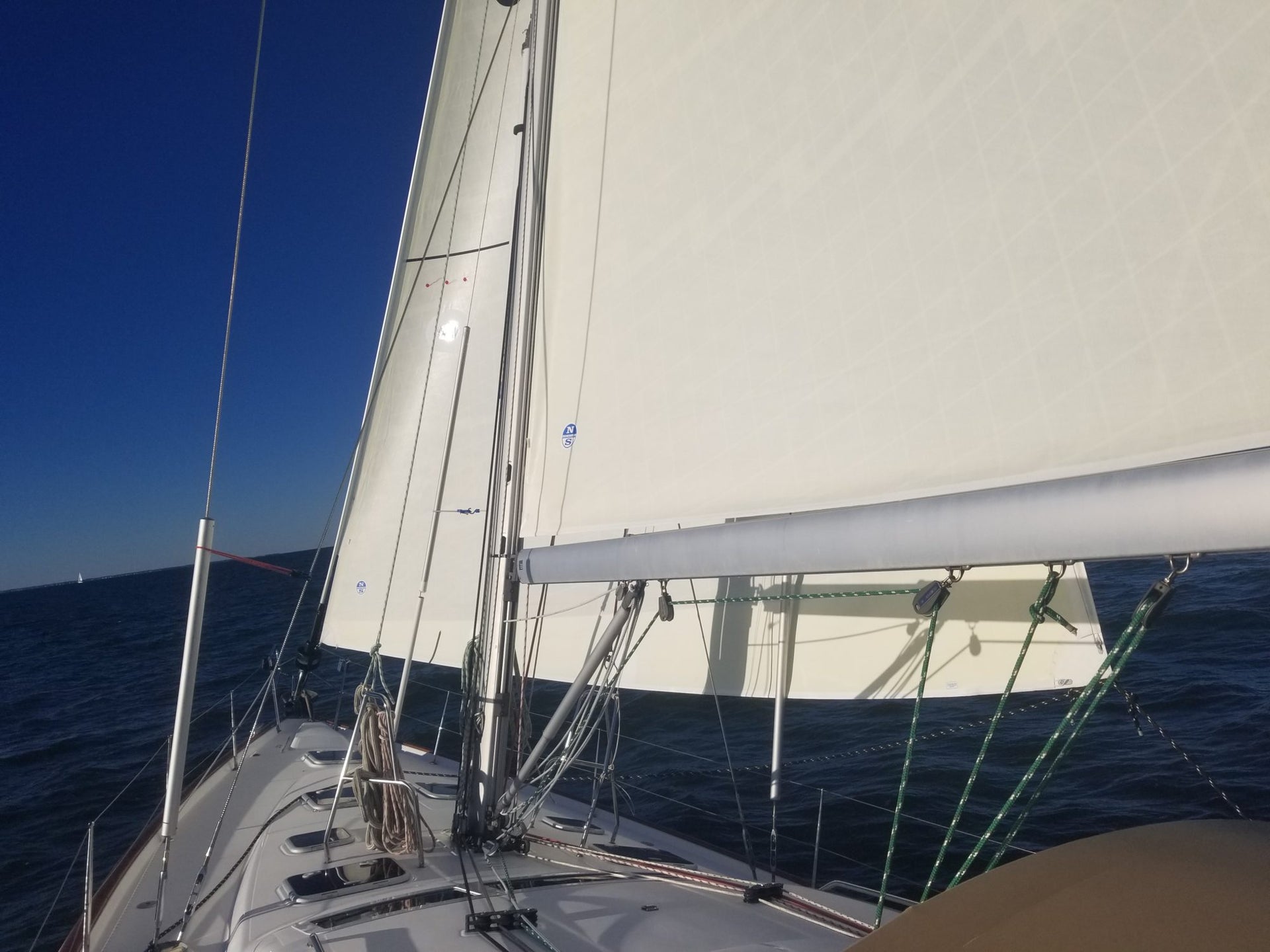
SÅ NEMT TRIMMES STORSEJLET
SÅ NEMT TRIMMES STORSEJLET
Det er især trimning af storsejlet, der gør båden velafbalanceret at styre, og behagelig at sejle, under næsten alle vejrforhold
Et veltrimmet storsejl i god form giver altid den mest behagelige sejlads, hvor båden ikke krænger unødvendigt og går godt gennem søerne. Det er en af de mest effektive måder at skabe sejlglæde og komfortabel sejlads for hele familien på kurser fra bidevind til halvvind.
Der er også mindre slid på sejl og rig, når storsejlet er veltrimmet, og det er godt for tegnebogen. Desuden mindsker det risikoen for havarier, der ellers kan stoppe ferieturen brat.
Det er en meget almindelig fejl, at for-liget ikke bliver strakt nok med faldet. Så bliver sejlet for hult, især fra midten og opefter, og det bliver sværere at styre båden og skøde sejlet ordentligt.
Det bliver også sværere at styre lidselinen, der skal forhindre at sejlet blafrer i agterliget mellem sejlpindene.
Når sejlet står og blafrer i agterliget, går sejlets syninger meget hurtigere i stykker og i værste fald kan man risikere at sejlet revner. Især med ældre sejl, der har fået meget sollys gennem mange år.
Manglende eller for bløde sejlpinde i storsejlet slider også på sejlet, ligesom båden ikke vil kunne gå så højt til vinden. Desuden kan det i nogle tilfælde medvirke til at riggen står og ryster.
Så snart skødes slækkes til dybere kurser end bidevind, ”skødes” storsejlet til det rigtige twist med bådens kickingstrap. Selv på læns bør sejlet ikke twiste nævneværdigt mere end på kryds. Her ses hvordan sejlet bliver fladere, og lukker mere i toppen, når man haler i storskødet. Sejlet bliver fladere, især forneden, når man haler i bomudhalet.
Storsejlets 7 vigtigste trimfunktioner anvendes således:
Storfaldet
Faldet skal som udgangspunkt altid hales, så forliget ikke rynker, og der-udover trimmer man dybde og facon med faldet. Når faldet tottes bliver sejlet fladere og sejlets største dybde flyttes fremad i sejlet.
Faldet skal derfor tottes, når vinden frisker fordi sejlet skal gøres fladere, og ved at hale faconen frem modvirker man at sejlets facon skrider for meget agterover, når sejldugen giver sig i den friske vind.
Hvis man sætter faldet for løst, bliver sejlet meget åbent i toppen, og når man så skøder hjem for at få toppen med, bliver sejlet dybt i bunden, og båden bliver hård på roret.
Storskødet
Skødet bruges især til at trimme sejlets twist og dybde på bidevind. Når man haler i storskødet bliver sejlet fladere og faconen rykker en anelse agterover. Sejlet ”lukker” også mere, dvs. at det twister mindre i toppen.
Mange vil opleve at de ikke kan trimme sejlet fladt nok uden at lukke sejlet for meget, så øverste sejlpind peger ind mod bomnokken. I dette tilfælde skal man få trimmet twistet korrekt med skødet og desuden flade sejlet yderligere med fald, bomudhal, cunningham og hækstag. På dybere kurser end bidevind overtager kicking-strap’en trimningen af sejlets twist.
Bomudhalet
Udhalet på bommen er et effektivt og nemt trimhal, som tursejlere burde anvende mere. Ved at hale bomudhalet bliver sejlet fladere – især i den nederste del af sejlet. Bomudhalet skal tottes i opfriskende vind, og slækkes i let og mellemluft med tung krapsø, hvor man behøver mere ”sejtræk” eller ”bundmoment” til at trække igennem.
Løjgangen
Løjgangen bruges til at trimme stor-sejlets vinkel i forhold til vinden og forsejlet og til at fintrimme rorbalancen, så båden nemt kan sejle ligeud og man kan styre båden med et minimum af kræfter.
En velafbalanceret båd skal kunne styres med en let hånd på rorpinden eller rattet.
Bådens grundlæggende balance på roret trimmes med riggen, men fin-justeringen af rorbalancen sker med løjgangen.
Her er det enkle princip, at man skal køre løjgangsvognen mod læ, hvis man føler båden er lidt for luvgirig, dvs. at der er lidt for meget pres på roret. Tilsvarende skal løjgangsvognen køres mod luv, hvis båden føles lægirig, eller det bare er svært at holde båden oppe på højden. Har båden ikke løjgang, kan man bruge kickingstrap’en.
Løjgangsvognen trimmes ofte med fordel lidt til luv i mellemluft og lettere vindstyrker, for at give mere højde og eventuelt lidt ekstra rorpres til at føle båden med. I opfriskende vind skødes løjgangen mod læ.
Kickingstrap
Bådens kickingstrap er beregnet til at holde bommen nede og sejlets profil in-takt, når kursen er dybere end bidevind.
Det er vigtigt for en behagelig sejlads og balancen på roret, at sejlets facon og twist bibeholdes ned forbi halvvind.
Når bommen holdes nede med kicking-strap’en, kan man mindske eller øge rorpresset, balancen på roret, ved at slække eller hale storskødet.
Hvis båden ikke har løjgang, kan kickingstrap’en overtage skødets twistregulerende funktion på bidevind, mens man lader skødet overtage løjgangens funktion.
På kurser mellem agten for tværs og læns er det også vigtigt at hale kickingstrap’en så hårdt, at sejlet ikke twister ret meget mere end på kryds. Det giver roligere sejlads og lettere styring i frisk vind.
Hækstaget
På brøkdelsriggede både anvendes hækstaget ikke kun til at totte forstaget med, men også til at hjælpe til med at åbne, twiste, toppen af storsejlet. Ved at hale hækstaget i frisk eller opfriskende vind, bliver toppen mere åben. Derved kan man flade storsejlet yderligere, ved at hale i storskødet, indtil toppen igen har det rette twist.
Cunningham
Sejlets facon bliver lidt fladere og en anelse mere åben i toppen, når man haler i cunningham. Samtidig trækkes sejlets facon frem og lidt nedad i sejlet.
Cunningham bruges til at "stramme op", når sejldugen strækker sig i frisk vind og til at hale faconen frem på sejl i strækstabil sejldug, når man bukker masten ved at hale hækstaget hårdt.
Når man trimmer storsejlet, kan man åbne toppen af sejlet lidt med hækstaget.
Reb i tide
Tursejlere skal altid huske at rebe i tide, og der skal rebes, så sejlføringen passer til pustene. Storsejlet skal altid rebes først. Det giver den mest behagelige sejlads. De fleste nyere cruisingbåde sejler mindst lige så hurtigt med rebet storsejl i frisk vind.
Husk også at holde rebegrejet i orden, så det er let at betjene. Hver bådejer bør prøve sig frem til, hvornår og hvor meget båden skal rebes, for at sejle godt og behageligt. Reb hellere for meget end for lidt. Her er sejlet også for hult, fordi faldet er for løst. Forstaget falder også ud, fordi riggen står for løst.
Trim af rullestorsejl
Der er en del forskel på trimmulig-hederne med et rullestorsejl efter om det er et sejl i en blød polyesterdug (Dacron) med negativ kappe, eller et moderne rullesejl i strækstabil dug med lodrette sejlpinde. De sidste er mere effektive end de gammelkendte rullestorsejl og giver mere sejlglæde.
Alle rullestorsejl flades til vindstyrke og sø med udhalet, og sejlets twist kan til en vis grad trimmes med skøde eller kickingstrap som beskrevet. Det kan dog være umuligt at twiste toppen på sejl i blød sejldug uden sejlet bare står og blafrer. Når sejlet er halet helt ud af masten, kan faldet bruges til at trimme sejlets dybde.
Pinden parallelt med bommen
Twistet i storsejlet er vigtigt for både komfort, fart og højde, men mange sejlere har vanskeligt ved at bedømme, hvornår sejlet twister rigtigt.
Her er det en nyttig håndregel for tursejlere, at den øverste sejlpind skal stå parallelt med bommen, når man kigger op i sejlet.
Tips
Det er en god og sjov måde at tjekke sit eget sejltrim ved at tage billeder lige op langs sejlet, og så kigge nærmere på trimmet i fred og ro hjemme ved computeren. Det bliver endnu nemmere at se trimmet, hvis man taper vandrette trimstreger på sejlet.
Læs også:
Nye sejl giver ekstra sejlglæde
Sådan sættes masten rigtigt
Så nemt trimmes genua og fok
Så nemt trimmes spiler og gennaker
Trim-tjekliste
Download hele vores trimguide til cruising her!
Få et tilbud på nye North sejl
READ MORE
READ MORE
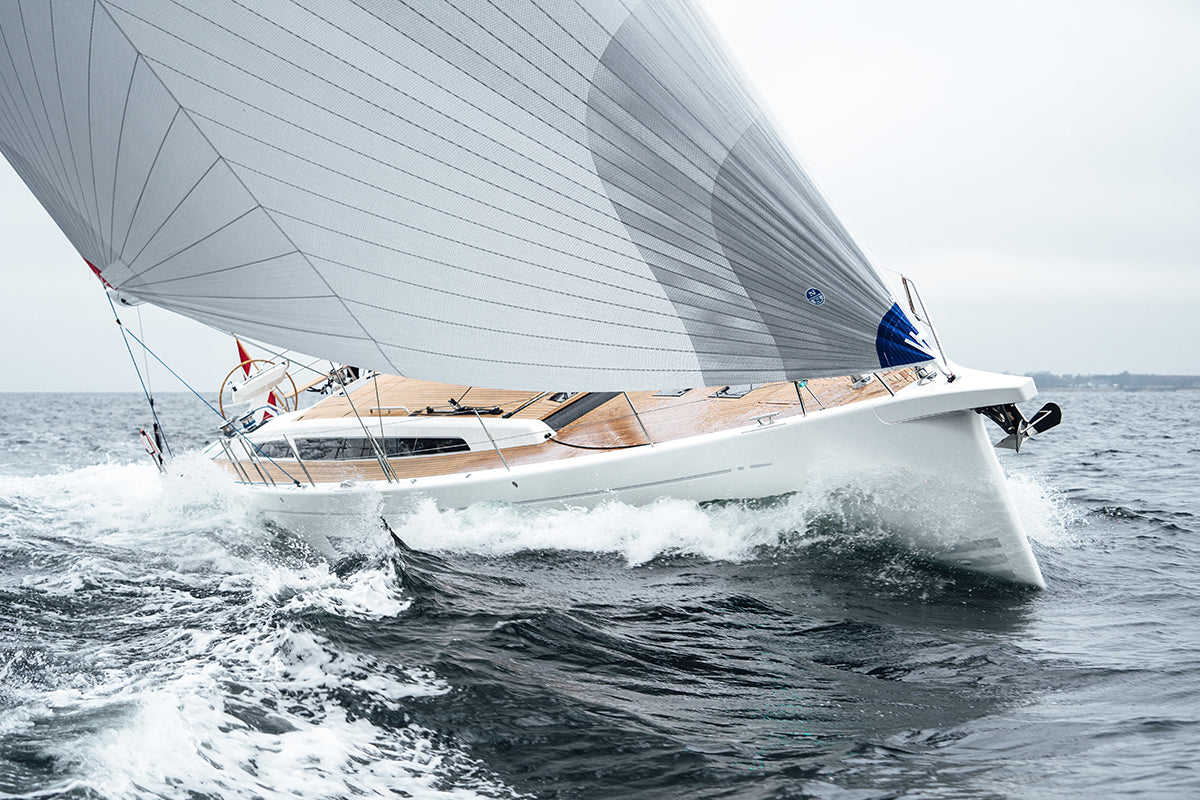
TRIM-TJEKLISTE
TRIM-TJEKLISTE
Denne liste er et trimtjek og en hurtig guide til at kontrollere riggen og trimme sejlene
📸 X-Yachts
Bådens trim
Riggens grundtrim
Har vantskruerne fået fedt eller olie, så de ikke brænder sammen, når de spændes hårdt og efterspændes?
Står masten helt lige sideværts?
Har masten den rigtige hældning, så båden balancerer på roret (sejl først med båden)?
Forkrummer masten en halv til en hel profilbredde?
Står overvantene meget hårdt?
(de må ikke stå slække i læ under sejlads).
Står mellemvantene korrekt?
Er kickingstrap’en i orden og velfungerende?
Sejlenes grundtrim
Er genuaen eller fokkens skødevisere sat til at twiste (åbne) forsejlet korrekt under de mest almindelige vindforhold?
Er der sat mærker på genua- eller fokkeskødeskinner til placering af skødevognene til forskellige vindstyrker?
Er der sat mærker på storskødet og evt. hal til løjgangen til hurtigt at trimme båden korrekt til de mest almindelige vindforhold?
Er der sat mærker på bådens fald, hækstag og evt. bagstag til det mest almindelige vind- og vejrforhold?
Båden rigges af
Dette afrigningstjek er vigtigt, fordi eventuelle skader kan blive udbedret i løbet af vinteren, så de er klar, når båden skal rigges til igen. Gå alle syningerne i sejlene efter og tjek om de er i orden. Især i agterliget.
Er lommelukningen til sejlpindene i orden?
Virker lukninger med velcro stadig som de skal?
Er alle fald, skøder og trimliner i orden med intakt strømpe? Vask dem evt. i vaskemaskinen i en lukket stofpose.
Er alle vant, stag og andre wirer i orden og fri for lus?
Hvad kan jeg gøre?
Når båden krænger for meget på kryds og halvvind?
Åbn kappen i toppen af storsejlet med hækstag og storskøde, og åbn genuaen ved at flytte skødeviseren bagud.
Flad sejlene yderligere med faldet, bomudhalet og cunningham.
Reb altid storsejlet først, hvis båden stadig krænger for meget.
Rul ind på genuaen, hvis båden stadig krænger før meget, når 2. reb er taget.
Hvis båden krænger for meget og storsejlet ikke kan flades tilstrækkeligt med trimhalene, så overvej at udskifte det.
Når båden er hård på roret med gennaker eller spiler?
Slæk så meget på skødet at båden bliver helt eller næsten neutral på roret.
Når båden ruller for meget på rumskødssejlads?
Tjek om kickingstrap’en er sat tilstrækkeligt, for ellers bliver sejlet for åbent. Ellers hal lidt ind på storskødet. I nogle kombinationer af vind og sø er det dog uundgåeligt at båden vil rulle.
Ved spilersejlads kan båden også rulle, hvis stagen står for højt og/eller skøde og gaj er sat for løst.
Når båden er lægirig?
Lægirighed er, når båden hele tiden selv vil falde af og skal styres op mod vinden.
Tjek om storsejlet er skødet for løst, eller løjgangen er skødet for langt mod læ.
Husk at øverste sejlpind skal stå parallelt med bommen.
Hvis det ikke hjælper at trimme storsejlet, så flyt om muligt mastefoden lidt tilbag i båden. Ellers læg masten lidt ned.
Når båden er luvgirig?
Luvgirighed mærkes på at man skal bruge kræfter på forhindre båden i at skære op.
Tjek om storsejlet er skødet for hårdt, eller løjgangen er halet for langt mod luv.
Husk at øverste sejlpind skal stå parallelt med bommen.
Tjek om genuaen er halet tilstrækkeligt hjem, og at den ikke åbner for meget.
Hvis det ikke hjælper at trimme sejlene, så flyt om muligt mastefoden lidt frem i båden. Ellers rejs masten lidt op, dog aldrig længere end til lodret.
Hvis båden er luvgirig og storsejlet hult på grund af alder eller blød sejldug, så overvej at udskifte sejlet.
Læs også:
Nye sejl giver ekstra sejlglæde
Sådan sættes masten rigtigt
Så nemt trimmes storsejlet
Så nemt trimmes genua og fok
Så nemt trimmes spiler og gennaker
Download hele vores trimguide til cruising her!
Få et tilbud på nye North sejl
READ MORE
READ MORE
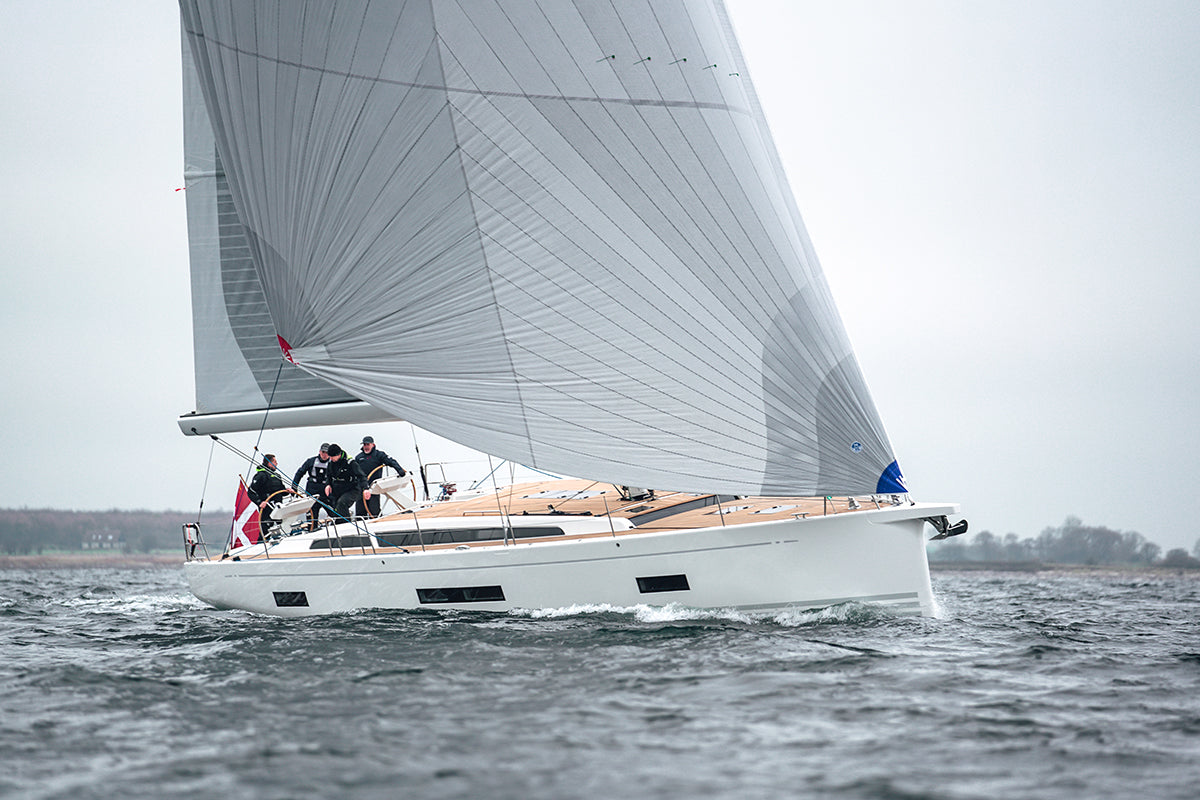
SÅ NEMT TRIMMES SPILER OG GENNAKER
SÅ NEMT TRIMMES SPILER OG GENNAKER
Spiler og gennaker er en spændende udfordring til sjovere og hurtigere cruisingsejlads
📸 X-Yachts
Alle cruisingsejlere kan have stor fornøjelse af at sejle med spiler eller gennaker, og det behøver hverken være besværligt eller skræmmende. Man skal bare ikke sætte disse sejl i for meget vind, og huske at bjærge dem i tide.
Vindstyrke afhænger af besætningens erfaring, men de fleste bør ikke sejle med spiler i over 7-8 m/sek.
Sejlere uden erfaring med flyvende forsejl, bør først øve sig i let vind.
Code 1 ideel til cruising
"De fleste cruisingsejlere vil have større glæde af en gennaker eller Code 1, end en spiler, fordi disse sejl er meget lettere at håndtere," fortæller Theis Palm fra North Sails Danmark.
"Personligt vil jeg anbefale en Code 1, der dækker hele halvvindsområdet. Det er et utroligt godt sejl, især i let luft, hvor man ellers ville starte motoren. Med Code 1 kan man ofte sejle lige så hurtigt for sejl som for motor. Bare uden støj. En Code 1 er ideel til moderne både med selvslående fok eller 105 % genua.
Code 1 er monteret på en rulle, så den kan rulles som en rullegenua. Man kan sagtens sejle agten for tværs med Code 1, men her er den ikke så effektivt som en gennaker. Man kan også sejle læns med en Code 1, ved at spile den til luv med spilerstagen."
En gennaker er enklere at trimme end en spiler, fordi der ikke er nogen spilerstage at holde styr på, medmindre man spiler den til luv på læns.
De flyvende forsejls 9 vigtigste trimfunktioner:
Gennakeren
Halsbarmen
Halsbarmen på de fleste gennakere til cruising sættes blot med en kort fast strop til fx bådens ankerrulle eller et lille bovspryd.
Man kan dog få mere udbytte af gennakeren med en trimline, tack-line, i halsbarmen, der skal gå gennem en blok i stævnen eller bovsprydet, og føres tilbage til cockpittet.
Halsbarmen trimmes så i forhold til, hvor meget man skærer.
På hård skæring sættes trimlinen hårdt. Det totter forliget, faconen flytter mere mod luv og det åbner agterliget. Med vinden mere agtenfra, slække man trimlinen, så sejlet får en mere jævn facon og mindre åbent agterlig.
Gennakerskødet
Gennakeren trimmes til vindretning og kurs med skødet. I praksis skøder man gennakeren på næsten samme måde som en spiler. Man trimmer skødet så gennakeren er lige ved at klappe i forliget ca. 2/3 oppe i sejlet.
North Sails’ gennaker er designet til at være meget overbærende med et stort vindue til at styre på, så man kan sætte skødet fast i læ.
I frisk vind skal man helst slække 5-10 cm på skødet, på forkanten af pustene, så båden ikke skærer op.
Barberhalet
Med barberhalet trimmer man gennakerens skødepunkt, som man trimmer genuaen med skødevognen.
Agterliget lukkes ved at hale barber-halet, og det gør man, hvis toppen af gennakeren har tendens til at blafre. Man skal dog passe på ikke at lukke agterliget, så båden krænger for meget.
Spileren
Spilerstagen
Stagen skal stå vandret, så man ud-nytter stagens længde maksimalt, og den skal stå vinkelret på vinden. Luv og læ skødebarm skal så vidt muligt stå lige højt. Stagens højde trimmer spilerens facon i toppen.
Op- og nedhalet
Ved at hæve eller sænke stagen, regulerer man dybden i midten af spileren og hvor meget sideligene åbner. Stagen holdes vandret og i ro med nedhalerlinen, aldrig med barberhalet.
Nedhalerlinen bør være fæstnet til stagen med en hanefod. Ophalet bruges til at hæve stagen inden spileren sættes og til at holde den oppe i let vind.
Gaj’en
Det luv spilerskøde, kaldet gaj’en, trimmer stagens vinkel til vinden, og styrer spilerens nedre facon. Hvis skødet skal hales hårdt, for at undgå spileren klapper, så skal stagen skødes længere frem med gaj’en.
Spilerfaldet
I let vind og på meget rumme kurser sættes faldet, så toppen flyver mellem 20 og 40 cm foran masten. I over 4-5 m/sek. og på skærende kurs, skal spileren hales tættere til masten, så den står roligere.
Spilerskødet
Spileren skødes så luv side hele tiden er ved at klappe ca. 2/3 oppe i sejlet.
Barberhalet
Med barberhalet trimmer man spiler-ens skødepunkt, som man trimmer genuaen med skødevognen. Man lukker spilerens læ sidelig og gør den lidt dybere i faconen ved at hale barberhalet.
Det er vigtigt, at halet ikke sættes for hårdt på skæring, hvor læ sidelig gerne må åbne lidt.
Tips
En gennaker eller Code 1 skal altid sættes og bjærges i læ af storsejlet på en kurs mellem agten for tværs og plat læns. Så ruller Code 1 lettere, og gennakeren er næsten håndtam, med eller uden snuffer. Man skåner også sejlet.
Sæt gennakeren med Snuffer
Det er meget nemt at sætte gennakeren med en "snuffer", hvor gennakeren ligger pakket i sin fulde længde.
Man sætter gennakeren ved at først at hale snufferen til tops i spilerfaldet i læ af storsejlet. Derefter hales tragten til tops, så gennakeren kan folde sig ud.
Man bjærger ved at hale tragten ned over gennakeren, også i læ af storsejlet, og sænke snufferen i faldet. Husk altid at følge vejledningen, der følger med snufferen.
Stagen skal stå vandret
Cruisingsejlere bør sejle med vandret stage. Hvis man hæver stagen, bliver spileren fladere og mere åben i siderne og man gør spileren dybere og mere lukket i siderne, ved at sænke stagen.
Stagehøjden trimmes med stagens fæste på masten og stagenedhalet.
Trim storsejlet 15-20 grader til stagen
Stagen skal stå vinkelret på vinden . Spileren bliver for flad i toppen, med stagen for langt mod luv (blå) og for dyb i toppen og urolig, med stagen for langt mod læ. Storsejlet trimmes, så der er en vinkel på 15-20 grader mellem stagen og bommen.
Måleskema til bådens rig
Når riggen er trimmet korrekt ind til bådens balance på roret, er det en god idé at måle trimmet op, så det er hurtigt og nemt at genskabe mastetrimmet næste sæson.
Målene tages fra overkanten af vantets terminal og ned til den nederste pindbolt i vantskruen. Til næste år spænder man bare riggen op igen efter disse mål.
Læs også:
Nye sejl giver ekstra sejlglæde
Sådan sættes masten rigtigt
Så nemt trimmes storsejlet
Så nemt trimmes genua og fok
Trim-tjekliste
Download hele vores trimguide til cruising her!
Få et tilbud på nye North sejl
READ MORE
READ MORE
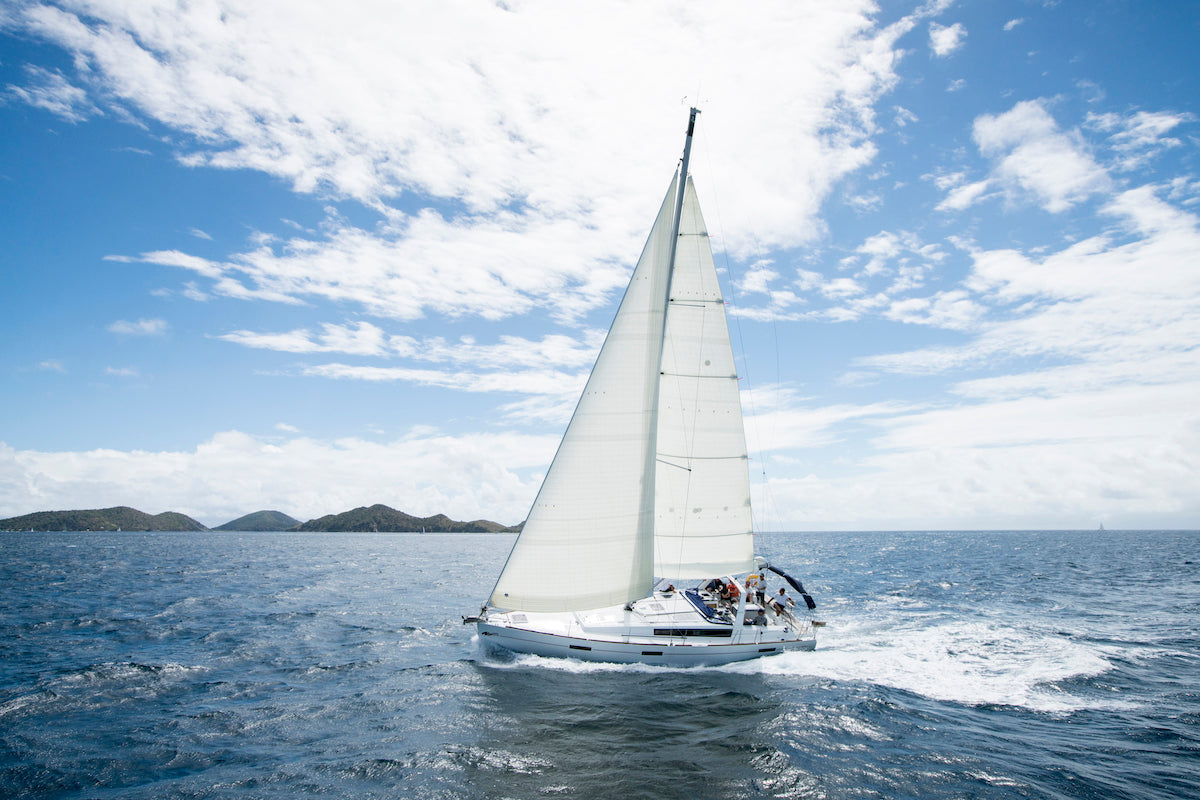
SÅDAN SÆTTES MASTEN RIGTIGT
SÅDAN SÆTTES MASTEN RIGTIGT
Al trimning starter med riggen, fordi mast og rig skal være sat rigtigt, før man kan trimme sejlene korrekt
Heldigvis er det hverken indviklet eller tidskrævende at rigge rigtigt.
Riggen på en moderne turbåd skal altid stå meget tot, og meget mere tot end de fleste bådejere forestiller sig. Desuden skal masten sættes helt lige og lodret tværskibs, mens den bør være forkrummet i langskibs retning.
Moderne cruisingbåde har en rig med bagudvendte salinger, og det er specielt vigtigt, at sætte den rigtype hårdt, fordi det ellers ikke er muligt at holde forstaget tot. Moderne både er netop bygget til at sætte riggen hårdt.
Myten om at man kan stramme forstaget med hækstaget er til dels rigtig, men hvis over- og undervant er for løse, så komprimerer man i stedet masten med hækstaget. Det giver den modsatte effekt - nemlig at forstaget og riggen bliver for løs. Når forstaget ikke er helt tot, bliver genuaen for dyb i faconen og det vil få båden til at krænge mere end nødvendigt. Man kan ikke bare klare det ved at hale hårdere i skødet og åbne toppen af forsejlet med skødevognen, fordi derved mister båden noget af fremdriften og det vil også medvirke til at båden krænger mere.
Bådens balance på roret grundtrimmes bedst med mastens hældning og placering ved mastefoden.
De følgende fire trin til at sætte masten, giver et godt udgangspunkt for, at kunne trimme sejlene optimalt til balance og større sejlglæde.
Tilrigningens 4 nemme trin til en tot rig:
Sættes lodret
Først sættes masten helt lodret i båden med forstag og overvant, og det kan tjekkes ved at hænge lidt vægt i storfaldet og lade det hænge ned bag masten. Båden skal være i sin naturlige balance og man skal enten gå i land eller stå midt i cockpittet, når man bedømmer det.
Det er god idé at måle længden på vantene inden masten sættes på båden. Så kan man nemlig se om de er lige lange i begge sider, og fx sætte mærker på vantskruerne eller terminalerne Derved får man identiske punkter på vantene, som man kan måle fra og ned til dækket. På den måde er det lettere at sætte masten helt lodret.
Sættes helt lige
Når masten står helt lodret, sættes undervant og mellemvant i forhold til topvantet, således at masteprofi let er helt lige hele vejen op. Dette kan tjekkes ved at flugte op langs hulkehlen eller med et fald i stille vejr.
Overvant
Dernæst sættes overvantene meget hårdt. Husk at de skal spændes lige hårdt og skiftevis i begge sider. Det er en god håndregel, at de skal spændes, indtil man selv synes de er spændt for hårdt. Man kan også måle spændingen på de enkelte vant med en rigspændingsmåler.
Undervant
Derefter spændes undervantene lige knapt så hårdt, således at masteprofilet står med en let forkrumning på en halv til hel profilbredde. Bådens rigtype og især storsejlets mastekurve afgør, hvor meget den præcist skal krumme. Mastheadriggede master skal bare have en let krumning, moderne master med bagudrettede salinger skal have en krumning på godt en profilbredde, mens rullemaster skal stå næsten uden krumning. Mellemvant skal sikre at masten står helt lige under sejlads.
Sejl med båden og efterspænd
Riggens wirer strækker sig lidt, når de kommer under belastning i starten af sæsonen, så derfor skal man huske at efterspænde riggen, efter årets første sejlture i lidt frisk vind. Under sejladsen skal man holde et vågent øje med vantene i læ. De må ikke være det mindste slappe på bidevind. Hvis vantene er lidt slappe i læ, er det nemt at totte dem under sejladsen, og derefter totte vantene i den modsatte side efter en vending. Bare husk at vantene skal tottes præcist lige meget i begge sider, når masten én gang er sat lige.
Masten skal forkrummes
Kun på rullemaster skal masten stå ret i langskibs retning. Alle andre master skal forkrummes med en halv til en hel profil-bredde.
Hækstaget skal kun krumme mastetoppen
De fleste moderne cruisingbåde har en form for brøkdelsrig, og her skal masten sættes så hårdt i over- og undervant, at masten primært bukker i toppen, når man haler i hækstaget. Ellers kan man ikke totte forstaget med hækstaget.
Masten skal stå snorlige
Alle master skal trimmes til at stå snorlige sideværts, som den viste mast. Man kan kontrollere at masten er lige, ved at kigge op langs hulkehlen eller ved at hænge et lod i storfaldet og lade det hænge lige bag masten. Masten skal samtidig stå så hårdt, at den stadig står helt lige, når der er belastning på riggen under sejlads.
Trim rortrykket med masten
Mastens hældning trimmes enkelt med forstagets længde, og fodens placering i mastesporet. Det er især bådens balance på roret, man grundtrimmer med mastens placering og hældning. Princippet er enkelt. Hvis båden er luvgirig og føles hård på roret, så skal masten stå mere lodret, eller flyttes frem i mastesporet. Jo mere luvgirig båden er, jo mere skal masten fl yttes frem. Den må aldrig rejses mere end til lodret. Hvis båden er bare let lægirig, så skal masten lægges ned.
En cruisingbåd bør altid være en anelse luvgirrig. Så er den let at styre på foran-for tværs og bidevind, med et let tryk på roret. Roret bør ikke vinkle mere end 2-3 grader.
Det er en håndregel for mastehældning, at masten skal hælde 1 grad på mastheadrigge, 2 grader på 9/10s rigge og 3 grader på 7/10s rigge.
Læs også:
Nye sejl giver ekstra sejlglæde
Så nemt trimmes storsejlet
Så nemt trimmes genua og fok
Så nemt trimmes spiler og gennaker
Trim-tjekliste
Download hele vores trimguide til cruising her!
Få et tilbud på nye North sejl
READ MORE
READ MORE
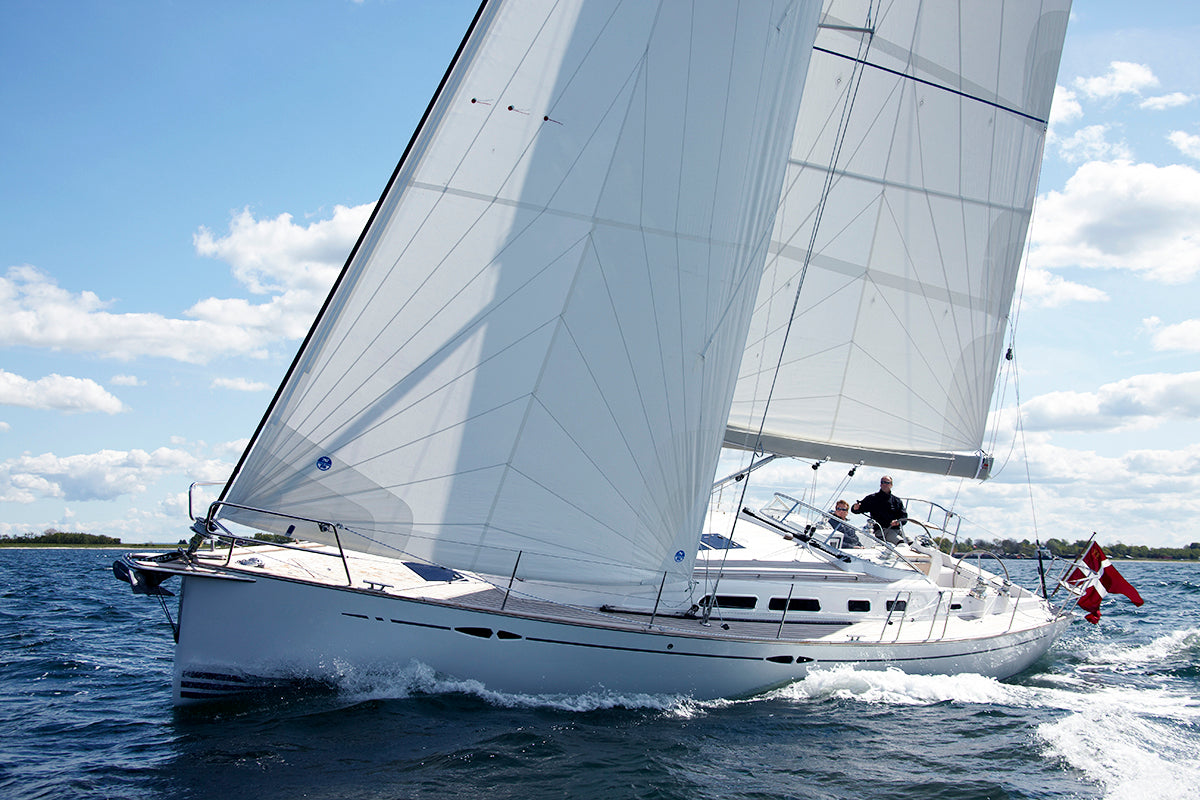
NYE SEJL GIVER EKSTRA SEJLGLÆDE
NYE SEJL GIVER EKSTRA SEJLGLÆDE
Det er dejligt at få nye, flotte og velfungerende sejl, der er lette at trimme
Og trimningen er vigtig for cruising-sejlere, for det handler om at sejle en komfortabel og glad båd i god balance.
Nye sejl giver cruisingbåden en klart bedre og mere komfortabel sejlads, med mindre krængning, bedre balance på roret, bemærkelsesværdig bedre højde og ekstra tiendedele på loggen.
Så klar var konklusionen, da vi testede et ældre mod et nyt stel sejl på en Granada 31. Først målte vi fart, højde og krængning med de ældre sejl og der-efter skiftede vi til et nyt stel North Sails.
Begge storsejl var syet med horisontale baner, også kaldet "C-cut" eller "cross cut", i en vævet polyester sejldug, bedst kendt som Dacron.
Tætvævet sejldug
De nye sejl var fremstillet i en sejldug fra Norths Sails egen dug-fabrik i USA. Det er en effektiv sejldug, der bliver vævet meget tæt med de mest stabile "high tenacity" polyestertråde der findes. "High tenacity" sejldug anvendes til kapsejladssejl og tursejl, hvor stabiliteten er vigtig.
Den aktuelle sejldug til det nye storsejl er specielt konstrueret til at klare de belastninger sejlet udsættes for langs agterliget. Det gør sejlet bedre i stand til at holde faconen i kappen. Det nye storsejl var desuden bygget med fire gennemgående sejlpinde, der sikrer sejlets optimale facon længere levetid.
Et roligt sejl
De gennemgående sejlpinde får også storsejlet til at stå roligt ved sætning, bjærgning og rebning, og sikrer at sejlet glider let og pænt foldet ned i bompresenningen. Bådens gamle rullegenua var traditionelt syet i "C-cut" med horisontale baner, mens den nye North rullegenua var konstrueret i et avanceret tri-radialt D-cut design, hvor paneler af sejldug stråler ud fra top, hals og skøde efter sejlets belastninger.
Bedre balance
Resultatet af sammenligningen var, at båden krængede langt mindre med de nye sejl. Desuden fik vi en klart bedre balance på roret, med mindre rortryk og dermed en lettere, roligere sejlads, fordi båden ikke blev så hård på roret i pustene. Alt i alt blev det en sjovere og mere komfortabel sejlads.
Højde og fart
Med de nye North sejl gik båden klart tættere til vinden og 0,3 knob hurtigere på kryds. Det giver ikke kun hurtigere, men også sjovere sejlads og gør det nemmere for cruisingsejlere at krydse, fordi den bedre balance på roret, også gør det lettere at styre båden i pustene.
Strækstabilitet
Der er især forskellen i sejldug, der giver dramatiske forskelle på nye og ældre sejl. I ældre sejl strækker sejldugen sig mere i pust og frisk vind, fordi sejldugen mister meget af sin strækstabilitet. Derfor glider faconen også mere agterover, og fordi det samtidig bliver for dybt, kan det i værste fald få båden til at skære ukontrolleret op i friske pust.
Det er derfor vigtigt, at få syet sine nye sejl i en god strækstabil dug. Så sejler de markant mere komfortabelt og holder meget længere. Med en billig, ikke stræk-stabil sejldug, mister sejlene deres facon langt hurtigere, og kan efter få sæsoner ikke trimmes fornuftigt.
Trim de nye sejl
Nye sejl i god facon og strækstabil sejldug er dog ikke alene nok. Sejlene skal også trimmes, og det bør alle cruising-sejlere tage alvorligt.
For cruisingsejlere handler trimning mere om at få en komfortabel sejlads med en glad båd i god balance. "Når jeg er af sted med familien på sommertur, ser jeg desværre for mange både, hvor sejlene ikke fungerer ordentligt, fordi de er trimmet forkert, eller riggen ikke er sat rigtigt," fortæller Theis Palm fra North Sails Danmark.
"Det er synd, for det kræver kun en beskeden indsats, at trimme rig og sejl ordentligt, så familien får en behagelig sejlads, hvor de bedre kan slappe af. De får samtidig den ekstra gevinst, at båden også vil sejle hurtigere."
Beskyt sejlene
Der var anvendt en sejldug med indbygget UV-filter, der beskytter sejl-dugen mod solens nedbrydende UV-stråler, og det forøger markant sejlets levetid. Den ekstra UV-beskyttende dækdug på agter-og underlig beskytter ogsågenuaen mod solen, når den er rullet op.
Storsejlet er ikke beskyttet mod sollyset, selvom det ligger pænt pakket sammen på bommen i havn, og derfor er det vigtigt at hele sejlet bliver dækket af en bompresenning, der også holder sejlet rent og pænt.
Sejlene skal også beskyttes mod mekanisk slid fra især riggen. Alle kanter og skarpe spidser på salingerne og vantskruerne skal tapes til, eller på anden måde beskyttes, så sejldugen og syningerne ikke kan blive revet i stykker.
Det er også vigtigt at storsejlet bliver lagt, eller rullet, pænt sammen efter brug. Hvis man lader riggen stå på båden vinteren over, bør sejlene altid afmonteres og tages med hjem.
Læs også:
Sådan sættes masten rigtigt
Så nemt trimmes storsejlet
Så nemt trimmes genua og fok
Så nemt trimmes spiler og gennaker
Trim-tjekliste
Download hele vores trimguide til cruising her!
Få et tilbud på nye North sejl
READ MORE
READ MORE
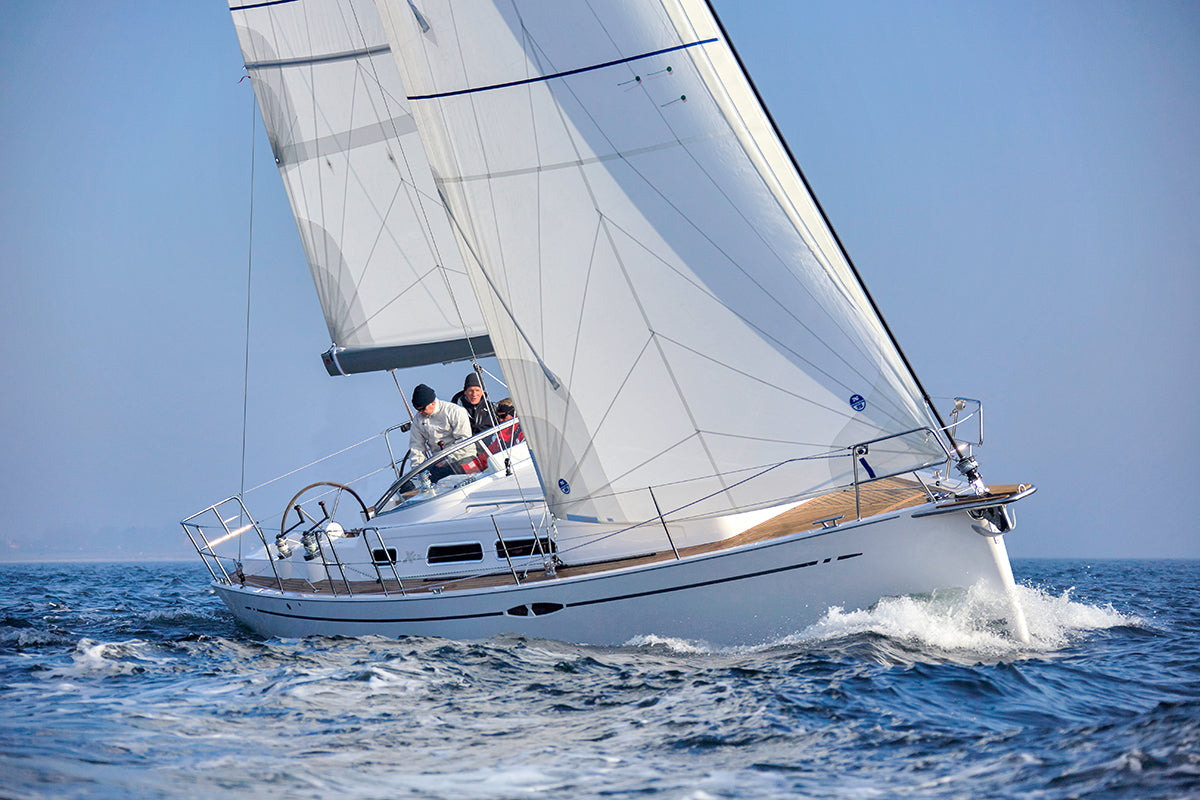
SÅ NEMT TRIMMES GENUA OG FOK
SÅ NEMT TRIMMES GENUA OG FOK
Genuaen er cruisingbådens vigtigste trækkraft
Vi anbefaler at også cruisingsejlere anvender strækstabile fald til at holde den gode facon i sejlene. Hvis faldene kan strække sig under sejladsen, må faldene tottes løbende, da sejlene ellers bliver dybere og mere lukkede.
Det er forsejlets trimning, der skaber den fartgivende vindstrøm hen over sejlplanet og gør sejladsen komfortabel under alle vindforhold.
Den gode trimning af bådens forsejl er vigtig, fordi forsejlet former vind-strømme hen over sejlplanet, og i korthed handler trimning af forsejlet om at forme vindstrømmen således, at vinden trækker båden bedst muligt fremad og skaber mindst mulig krængning. Det er hverken indviklet eller besværligt at trimme sin genua optimalt, blot man følger nogle få og helt enkle principper, der er de samme for nye som for gamle sejl.
"På mine sommerture med familien ser jeg desværre alt for mange både, hvor sejlene ikke fungerer ordentligt, simpelthen fordi de er trimmet forkert", fortæller Theis Palm, North Sails Danmark. "Jeg har set mange både, hvor de fx ikke har halet ordentlig hjem i genuaskødet eller sejlet twister så meget, at det meste af sejlet bare står og blafrer. Det er synd, fordi det nedsætter sejlets levetid og fordi disse familier kan få meget mere glæde af deres båd med en blot en beskeden indsats. Ved at bruge bare et par minutter på at grundtrimme, kan de få sejlene til at fungere ordentligt, og få en sjovere og mere komfortabel sejlads.
Båden vil også sejle hurtigere, men det er ikke det vigtigste her. Store overlappende 135-150 % genuaer er bådens motor, og man kører vel ikke rundt på tre cylindere i bilen uden at gøre noget ved det. Mange nyere både har mindre og familiemæssigt mere håndterlige ca. 105 % fokke eller selvslående fokke. De er også en del af bådens motorkraft og er med til at forme vindstrømmen over storsejlet, der er hovedmotoren i disse både.
Endelig er forsejlenes trimning medvirkende til at give en mere stabil sejlads med mindre krængning, blødere krængning i pustene og ikke mindst til at give en god rorbalance. Desuden har jeg gang på gang konstateret at faldet, på alt for mange turbåde, ikke bliver rørt efter sejlet er halet på rulleforstaget først på sæsonen."
Den følgende trimvejledning sigter på at trimme rulleforsejlene, så båden sejler velafbalanceret og behageligt under næsten alle vejrforhold.
Det hele handler faktisk kun om at justere på tre ting: Faldet, skødet og skødevognen. På moderne selvslående fokke svarer placeringen af skødet i skødbarmen til at trimme skødevognen. Vi forudsætter at bådens rig er sat rigtigt og hårdt, så forstaget reelt kan tottes med hækstaget i opfriskende vind.
En helt ny genua, der er trimmet korrekt på en hårdt sat rig, hvor forstaget kun falder minimalt ud i læen. Bemærk flyvingefaconen med den største dybde fremme i sejlet og den næsten rette afgang for vindstrømmen i agterliget.
Forsejlets 3 vigtigste funktioner anvendes således
Faldet
Faldet trimmer dybde og facon i sejlet og princippet er enkelt. Når faldet tot-tes, bliver sejlet ikke overraskende fla-dere og faconen flytter lidt frem i sejlet.
Tilsvarende får man et dybere sejl, med faconen liggende længere tilbage i sejlet, når faldet slækkes lidt. Her taler vi om justeringer på op til ca. fem cm på faldet på en mellemstor familiebåd.
Princippet for trimningen er enkelt Faldet tottes med opfriskende vind, så sejlet bliver fladere og båden krænger mindre.
Modsat kan det være en fordel at slække lidt på faldet i lettere vind. I samspil med lidt løsere skødning vil det give en dybere facon, der giver mere kraft til at holde fart i båden.
I krap eller tung sø i mellemluft har man også brug for dette "sejtræk" som et lidt slækt fald giver. Pas blot på ikke at slække for meget. Sejlet må kun lige akkurat trække små vandrette rynker fra forliget.
Skødet
Skødet bruges til at trimme sejlet til vindretningen og på bidevindkurser til at trimme balance og fart i båden.
På rumme kurser kan man bruge sejlets ticklers til at trimme til vindretningen, for også på rumskøds sejlads bør begge ticklers, på hver side af sejlet, flyve vandret og parallelt.
På foran-for-tværs hales genua- eller fokkeskødet efter de aktuelle forhold med vind og sø.
Når man vil gå højt i mellemluft, eller vinden er frisk til hård, så skal forsejles skødes hårdt. Det flader sejlet og trækker faconen lidt frem i sejlet.
I mellemluft kræver det også at man styrer mere præcist, for at opretholde farten.
Modsat giver det en lidt dybere og rundere facon, hvis man lige slækker et par cm på genuaskødet, og det giver mere råstyrke i sø og gør båden lidt mere tilgivende overfor styringen.
Det kan lidt sammenlignes med bilens gear, hvor de lavere gear bruges til at accelerere eller sejtrække, mens man kører hurtigst i de høje gear.
Et knap så hårdt sat skøde svarer til de lave gear, mens man går op i et højere gear, ved at skøde hårdere.
For at blive i sammenligningen, så kan man ikke accelerere så hurtigt, hvis man sætter bilen i for højt gear for tidligt, og tilsvarende skal man ikke hale for hårdt i skødet efter fx en vending, men hale hjem efterhånden som båden accelererer. Mange tursejlere skøder genua og fok alt for løst, men som tursejler skal man heller ikke skøde for hårdt, hvis man vil sejle afslappet med lidt ”tilgivelse” for rorsmandens håndtering af rorpind eller rat.
Husk at det kun handler om at slække mellem 2-5 cm i forhold til at hale hårdt hjem.
Det er også vigtigt at sejle med yder-ligere lidt slæk på skødet, hvis søen er grov i forhold til vindstyrken. Ellers ligger man bare og hugger i bølgerne.
Skødevognen
Bådens skødevogn til fok eller genua bliver desværre alt for sjældent brugt på mange turbåde, og det er netop med skødevognen tursejleren kan trimme god balance i båden. Skødevognen trimmer skødepunktet, der afgør sejlets vigtige twist op gennem sejlet.
Når sejlet twister for meget er det for "åbent", og så blafrer toppen af sejlet unødigt, ubehageligt og det er dyrt for sejlets levetid. I de lettere vindstyrker betyder det, at sejlet ikke trækker effek-tivt og at rorpresset bliver forøget. I frisk og hård vind betyder for meget twist at sejlet blafrer larmende i toppen, og især at denne "flageffekt" kun får sejlet til at holde kortere tid, i stedet for at sejlets top giver stabiliserende fremdrift.
Hvis sejlet twister for meget, skal skødevognen flyttes fremad. I princippet skal skødevognen stå for enden af en linje trukket fra midten af forstaget ned gennem øjet i sejlets skødbarm, men sejlets facon og alder kan betyde afvigelser fra dette.
Når sejlet twister for lidt, er det for "lukket". Så trækker hele den øverste del af sejlet ikke ordentligt og båden vil krænge unødigt meget, når det blæser en frisk mellemluft.
Båden kan blive hård og ubehagelig at styre, fordi den krænger mere brat og huggende i pustene. Endelig kan nogle både blive let lægirige af en stor overlappende genua, der lukker for meget i toppen.
Når sejlet twister for lidt, skal skøde-vognen flyttes agterover. Stort set alle cruisingbåde sejler i dag med rullegenua eller -fok, og reber sejl ved at rulle sejlet nogle omgange om forstaget. Når forsejlet rulles ind skal skødevognen flyttes fremad. Ellers vil toppen af sejlet blive for åben og blafrende.
Rul vognen frem med sejlet
Skødevognen skal køres lidt fremad, når man ruller genuaen lidt ind for at mindske sejl i opfriskende vind. Hvis man ikke kører skødevognen frem, når genuaen rulles lidt ind, så vil sejlet blive for åbent i toppen. Det vil blafre i toppen og og ødelægge sejlet.
Skødet trimmer dybde og form
Her ses hvad der sker med dybden i sejlet, når man trimmer genuaskødet. Vi forudsætter at skødevognen er placeret rigtigt. Når man haler fokke-eller genuaskødet hårdere, bliver sejlet fladere og sejlets dybeste punkt trækkes lidt fremad, som på den grønne faconkurve. Når man slækker fokke-eller genuaskødet bliver sejlets facon dybere og sejlets dybeste punkt flytter lidt agterover.
Sjæklen i skødebarmen
På moderne selvslående fokke, hvor skødevognen kører på en fast skinne, trimmes skødepunktet ved at flytte skødets sjækkel til et andet hul på skødbarmen. Man twister sejlet mere ved at fl ytte skødet til et lavere hul eller frem på skødepladen, og man lukker sejlet med mindre twist ved at flytte skødet opad i skødbarmen eller tilbage på skødepladen. Princippet er det samme, som at flytte skødevognen tilbage eller frem i båden.
Stil skødevognen efter sejlets ticklers
Øverst er sejlet trimmet optimalt (A) og de tre sæt ticklers i sejlet blafrer alle fint og parallelt. I midten (B) lukker sejlet for meget, der er for lidt twist i sejlet, og derfor slår den øverste læ tickler opad, mens den læ tickler i midten også er urolig. Nederst twister sejlet for meget (C), det er meget åbent, og derfor løfter den luv uldtråd sig i toppen. Ved (B) skal skødevognen flyttes agter-over til sejlet ser ud som i (A), og i (C) skal skødevognen flyttes fremad. I (B) sejler man for lavt med den øverste del af sejlet, mens man i (C) sejler for højt med toppen af sejlet. På tegningerne er de læ ticklers røde, mens de luv ticklers er grønne.
Tips
Skødevognene er med faste stop på hovedparten af alle cruisingbåde, men det er lidt bagvendt at man skal på dækket og flytte skødevognen i fx opfriskende vind og sø, når nu alt andet normalt kan trimmes fra cockpittet. Det kan derfor være en god ide at skifte til en såkaldt "flydende" skødevogn, der kan trimmes kontinuerligt fra cockpittet med et enkelt hal.
Det forlænger sejlets levetid, hvis man slækker 5-10 cm på faldet lige inden man ruller genuaen ind og går i havn, hvis båden ikke skal ud at sejle de næste dage. Det belaster sejlet unødigt, altid at stå med tot genuafald.
Læs også:
Nye sejl giver ekstra sejlglæde
Sådan sættes masten rigtigt
Så nemt trimmes storsejlet
Så nemt trimmes spiler og gennaker
Trim-tjekliste
Download hele vores trimguide til cruising her!
Få et tilbud på nye North sejl
READ MORE
READ MORE
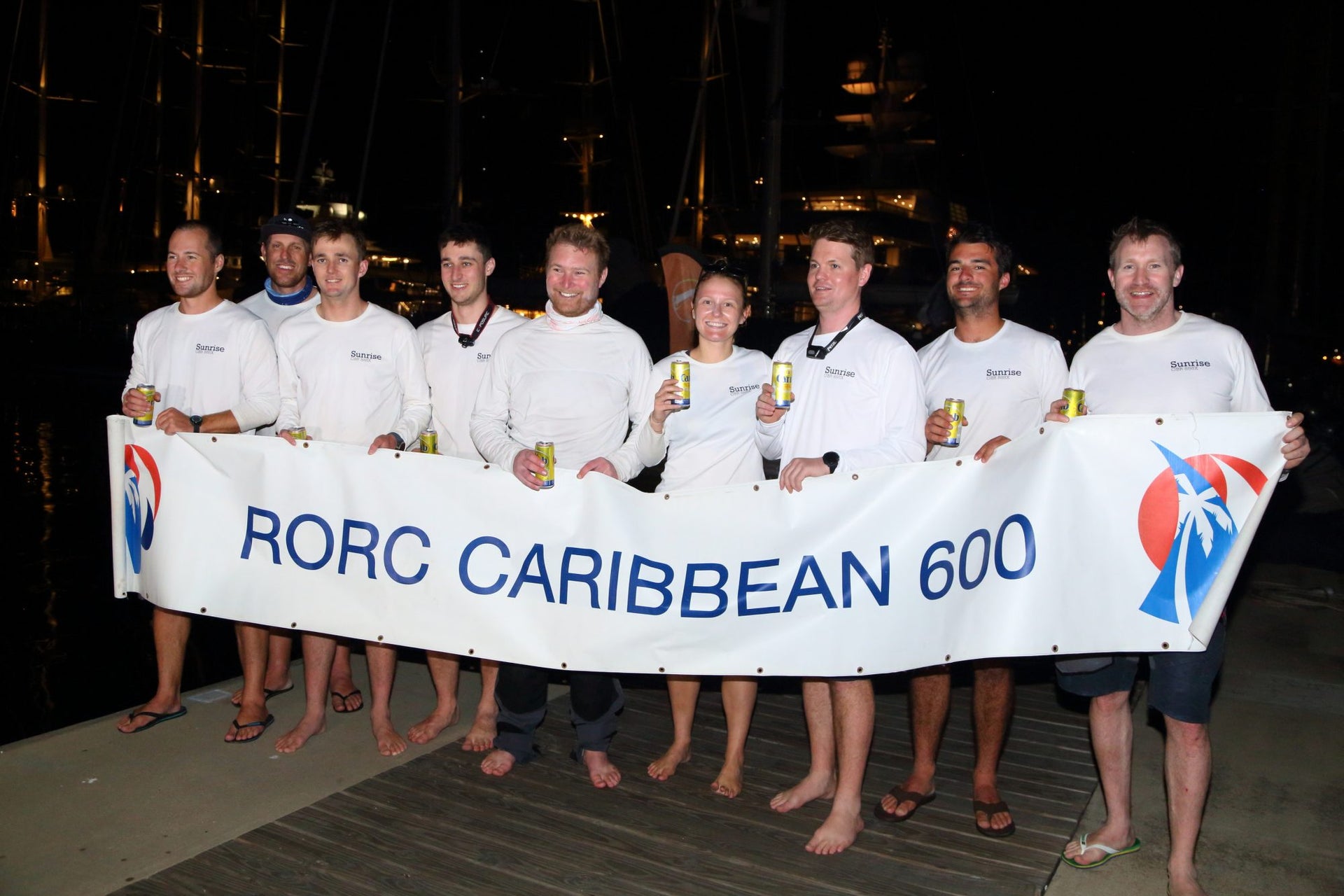
#NSVICTORYLIST: RORC CARIBBEAN 600 2022
#NSVICTORYLIST: RORC CARIBBEAN 600
A Strong Showing For North-Powered Teams. Here’s Our Race Recap
The RORC Caribbean 600 is a much-anticipated event on the winter sailing schedule. With pro teams and amateurs alike gunning for victory, the combination of North Sails products, on-island support, and expertise is proven to deliver results.
For the 13th edition of the race, North Sails was on board for a new multihull race record, multi and monohull line honors, and held a commanding presence amongst the fleet claiming 70% of the possible podium positions. And to top it off, Warrior Won’s 3Di sails carried owner Chris Sheehan and crew to the top of the overall leaderboard.
A navigational channel in, out, and around eleven islands in almost perfect condition, the race is as much a showcase for sailing as it is for the Caribbean’s beautiful islands.
“There is a reasonable amount of reaching in the 600-mile course, and it becomes a real test of a sail’s range,” explains Andrew Dove, manager of North Sails Antigua. “Our Helix Structured Luff Code Sails can make a huge difference here. Many of the legs are challenging, with conditions varying amount different islands; a hallmark of the race and a true test of a sails range. This is where 3Di and Helix sails excel.”
We’re incredibly proud of the North-powered results; they’re overwhelming in the best way and inspire us to keep coming back for more.
📸 RORC / Tim Wright / Arthur Daniel
READ MORE
READ MORE

SMALL BOAT, BIG RACES
SMALL BOAT, BIG RACES
Richard Palmer’s JPK 1010 Jangada Takes On The Doublehanded Offshore Scene
📸 Rick Tomlinson
Highlight Results
Twostar Transatlantic Race 2012 – 2nd IRC
Round Britain & Ireland 2-handed 2014 – 1st IRC
RORC 2018 – 2nd IRC overall
AZAB 2019 – 3rd IRC (1st family)
RORC Transat 2019 – 1st IRC overall
RORC 2020 C600 – 1st IRC 2-handed
RORC 2020 Summer series – 1st IRC 2-handed
RORC 2021 Morgan Cup – 1st IRC 2-handed
RORC 2021 De Guingand Bowl – 1st IRC 2-handed
UKDHOS 2021 – 1st Corinthian/Masters
RORC 2021 Series – 3rd IRC 2-handed
RMSR 2021 – 1st IRC 2-handed
RORC Transat 2022 – 1st IRC 2-handed / 3rd IRC1
RORC 2022 C600 – 1st IRC 2-handed / 3rd IRC2
Richard Palmer’s JPK 1010 Jangada has been turning heads as the doublehanded team on board continues to win multiple international offshore doublehanded trophies whilst also claiming some of the top spots against fully crewed teams. In 2020, they won RORC Yacht of the Year following their overall win in the RORC Transatlantic Race and RORC Caribbean 600 doublehanded win, they also took the Corinthian Trophy in the UK Double Handed Offshore Series.
📸 Arthur Daniel
Aiming for the coveted RORC Jazz Trophy for IRC overall and having just finished the RORC Transatlantic Race, bettering their 2019 record by just under 2 hours, we caught up with Richard to hear how a physicist turned finance professional who grew up dinghy sailing in Salcombe on family holidays is now winning international yacht races doublehanded.
Richard started sailing through a local club at 11 and caught the bug’ when his parents signed him up to an RYA course on the Thames. During family holidays in Salcombe, he was inspired to take up windsurfing as well and was later recruited for the Oxford University Windsurfing Team. Whilst working at the National Physical Laboratory he continued windsurfing competitively but also took up yachting after seeing an advert for the Civil Service Offshore Racing Club. This led to years of club racing, Junior Offshore Group (JOG) racing, and introduced Richard to Offshore racing. He was then thrown in at the deep end as a navigator on the club’s Sigma 33. His first two Rolex Fastnet Races were with the BT Offshore Racing Club in 1991 and 1993.
Following a busy few years starting a young family and focusing on his career, Richard joined the Yacht Owners Club in 2006 buying a J/109, Jangada Too. The decision to buy the J/109 was made over a glass of wine in Cowes with his friend Jeremy Waitt. After doing the first few seasons crewed, Richard and Jeremy decided to give doublehanded offshore racing a try in 2009 and haven’t looked back! Richard had several successes in the J/109, most notably winning the 2014 Royal Western Round Britain and Ireland Race with co-skipper Trevor Drew after being ‘pipped’ to the overall win by Pip Hare in the previous edition. Jangada Too sparked Richard’s relationship with North Sails.
📸 Rick Tomlinson
📸 Rick Tomlinson
“It became clear to me that most of the winning boats in the fleet at the time all had North Sails, that’s when we first got in touch with North and we have been with them ever since.” remarks Richard.
The reputable JPK1010 Jangada hit the scene in 2016. After a long stint in the J/109 getting fed up with being beaten by some of the French boats, Richard admitted “it was a case of, if you can’t beat ‘em join ‘em. When the 1010 was delivered it had a full suite of French sails, but the first thing we did was get North Sails down to do an audit of the wardrobe to work out which were fit for purpose and which needed replacing.” Over the course of the next two years, Richard replaced the full suite of sails with North Sails.
“The scale of the North operation is the main attraction, they have a great design team and the appeal is that they are always developing the materials, the shape, the cut. They’re always leading in the field. Our latest batch of sails in particular are great and very reliable. We saw that in the RORC Transatlantic Race this year. We had very little chafe or damage.”
As doublehanded sailors, Richard and his co-skipper’s often have slightly different priorities to fully crewed teams. Their priorities, amongst safety and energy/sleep management, include making maneuvers as easy as possible and minimizing sail changes, in particular headsail changes. Both their heavier jibs are reefable which means they can reduce the sail area without totally changing sail. This was added by North for the benefit of the team and tailored to their specific requirements.
Jangada’s newest addition to the sail wardrobe was the new Helix Structured Luff Code Zero. Richard and Jeremy tried it for the first time on the RORC Transatlantic Race and are very impressed. “We can carry it in higher wind strengths and to higher angles. We’re still pushing the boundaries with it, but it’s a very versatile sail.” Jangada finished the 2022 Transatlantic Race in an elapsed time of 16 days 11 hrs 59 mins 46 secs, winning IRC Two-Handed and placing third in IRC One. On top of this, Jangada’s IRC corrected time set a new race record for Two-Handed teams, bettering their 2019 triumph, and establishing the IRCRecords™ corrected time for the course of 16 days 13 hrs 58 mins 34 secs.
The team has recently completed the RORC Caribbean 600 having finished the race twice before. In 2018 they, unfortunately, had to retire due to injury but returned in 2020 and 2022 with back-to-back wins in the IRC Two-Handed class.
With the RORC Caribbean 600 over, Jangada is now on a mission to be back in the UK in time for the next RORC race of the season.
Richard is also planning on taking on the Round Britain and Ireland Race again this year with Rupert Holmes, his co-skipper from the first Transat Race. Keep an eye out for “Team Jangada” – big personalities, with big results on a relatively little boat!
📸 Rick Tomlinson
READ MORE
READ MORE
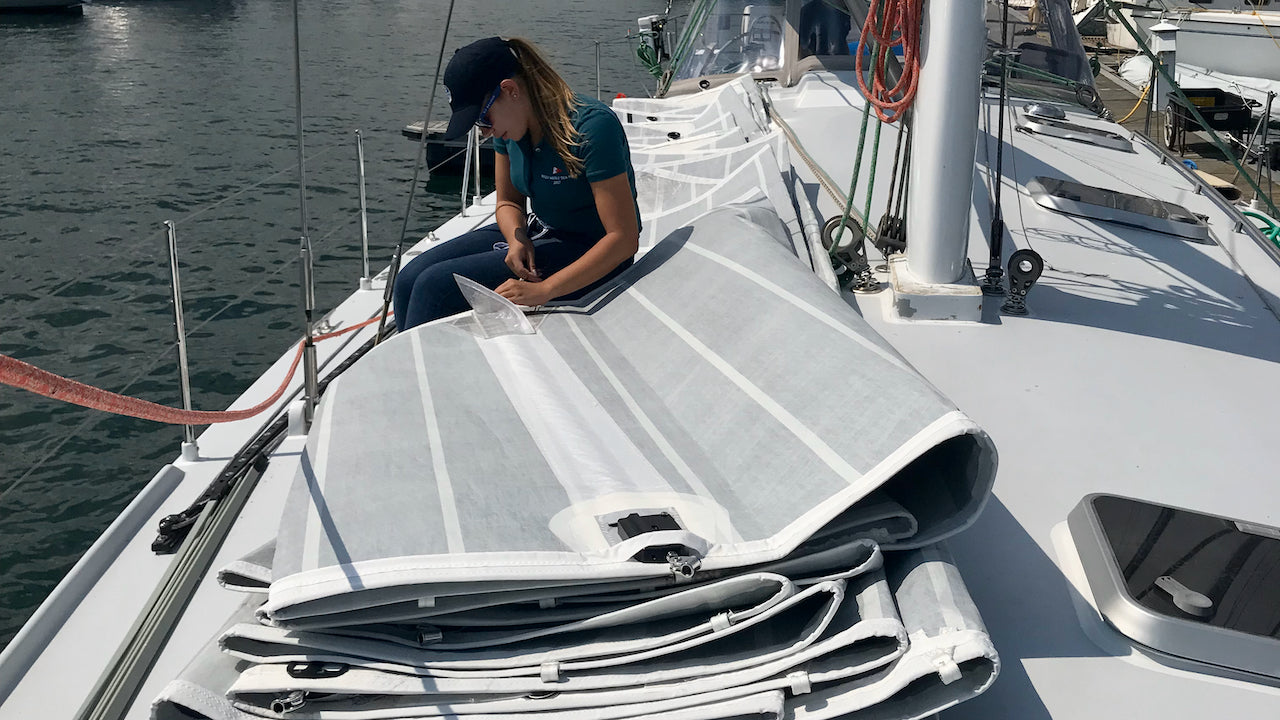
VAD DU BEHÖVER VETA OM LATTOR
VAD DU BEHÖVER VETA OM LATTOR
Instruktioner för montering och spänning av lattor
Seglingssäsongen närmar sig och vi vet att det är många som har funderingar kring sina lattor. Med all rätt. Oavsett om du planerar en långsegling eller ser fram emot vårens klubbkappseglingar är det viktigt att dina lattor monteras korrekt och att de har den rätta spänningen. Det innebär att seglet får en bättre form med högre prestanda – och säkrar upp att du inte tappar dem i ett slag eller en gipp.
Rätt montering ger den rätta segelformen
Se till att lattan sticks in i lattfickan med den mjuka (tunna) ändan mot förliket och den hårda (tjocka) mot akterliket. Vi ser ibland lattor som monterats på motsatt håll, och resultatet blir att seglet vare sig får rätt djup eller rätt kurvatur. Så det är värt att dubbelkolla att lattorna sitter åt rätt håll.
Se till att dina lattor är säkrade
En del lattor monteras framifrån och andra bakifrån, och beslagen ser lite olika ut, så det är viktigt att du säkrar lattorna på rätt sätt. I North Sails kardborre-lås finns det en särskild ficka för själva lattan och en annan ficka som låser kardborrebanden mot varandra. Andra lattsystem fungerar på andra sätt. Oavsett vilket system du har så kommer korrekt montering se till att dina lattor sitter på plats under hela säsongen.
Rätt lattspänning ger dig ett slätt segel
Det är också viktigt att du spänner dina lattor med omsorg och noggrannhet. Om spänningen är för låg kommer det uppstå vertikala rynkor längs lattfickan. Med för hög spänning blir resultatet synliga, horisontella kraftrynkor ovanför och under lattfickan, och duken ser överbelastad ut. Med korrekt spänning är lattfickan slät och lattan harmonierar perfekt med den inbyggda, designade formen.
📸Mike Egan
Har du frågor kring lattor? Eller behöver du hjälp att få dem korrekt monterade?
Kontakta oss på North Sails i Stockholm eller Göteborg, så hjälper vi dig med instruktioner och råd om hur du installerar dina lattor på bästa sätt.
READ MORE
READ MORE
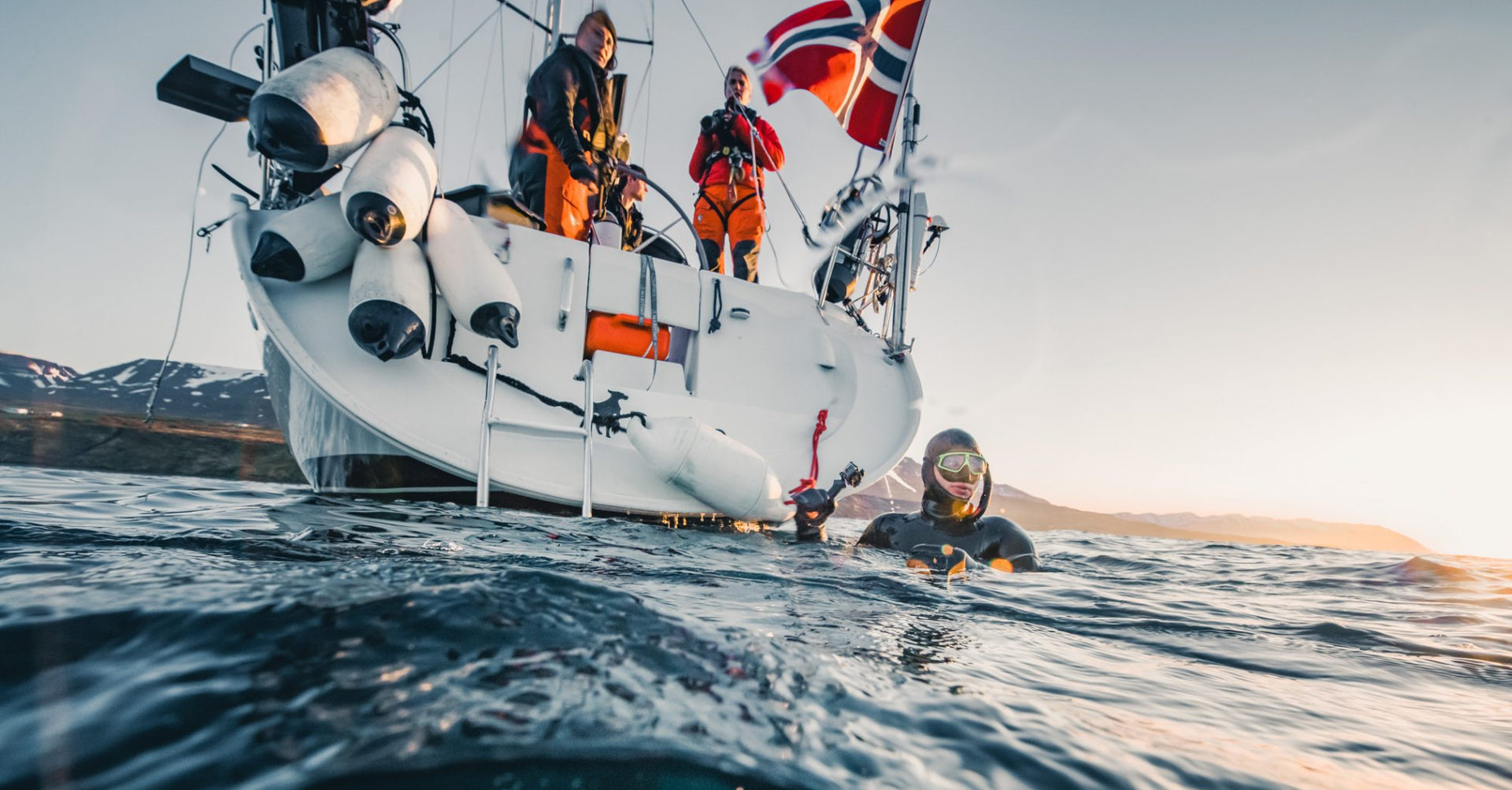
LETTER TO MY YOUNGER SELF: ANDREAS HEIDE
LETTER TO MY YOUNGER SELF
Andreas Heide Helmsman, Marine Biologist and Ex-Navy Diver, Takes on the Polar Atlantic Ecosystem
📸 Matthew Ferraro
The sailors and designers in the world of North Sails are some of the most inspiring people on the water, and we’re hoping to share more of their story with you. “Letter to my younger self” is a series told from our North Sails ambassadors. In each article, we bring to life their advice and personal journeys centered around the question: if your “now self” could give your “younger self” advice, what would it be?
Dear 12-year-old Andreas,
As you read this, I reckon you have just returned from a trip in your little boat or from freediving somewhere. Your parents might have been upset with you for coming home late, but shrug them off because this is the path you should stay on.
Stay true to your own journey, not the one expected by your parents or your surroundings. Let curiosity continue to drive you. Follow your instincts my boy and go for it. Know that everything you do now from climbing trees, skiing in the mountains, and rowing out to fish will help you better understand the great outdoors that you already love.
When you look at the horizon, wondering about the world that lies beyond the outer jetties, realize that one day you will adventure beyond the comforts of your home. When you look at the ocean wondering about what magnificent creatures live in the big blue ocean, know that you one day will get to meet many of these animals that fill your childhood dreams.
📸 Peter Svanberg
You will swim with whales of all sorts as well as the world’s second-largest fish, the basking shark (yes the kind you just read about in your favorite book), and have close encounters with polar bears, perhaps even a bit too close! And one day, you will sail as far north as you can, to the pack ice around the North Pole.
Getting there is not going to be easy though, sacrifices will have to be made. You will have to work hard and train harder. Join the Navy, learn to use a parachute, dive out of submarines and go on endless winter marches in the barren land of Northern Norway. But every day and every step is just a little closer towards your dream.
It’s not only about the physical side of what you do, having the smarts is just as important. Your teachers and parents will do a poor job of explaining why you have to go to school, but you have to suck it up. Trust me. If you realize that everything you learn will become useful later in life you will have fewer problems sitting still while doing your Algebra. (By the way, Algebra will become particularly helpful as you travel by boat in the high North) So listen to your parents and please be a good student. You will find marine biology studies a bit boring, but go with it because one day it will come to great use.
And whilst you should follow your instincts, make sure you surround yourself with good people and friends. Be humble and ask for advice when you need it. Nonetheless, self-confidence is really important as well. You will need that confidence at times, as it’s a lonely path you have chosen and few will understand what drives you. But you know: it’s the wonder of what lies beyond the horizon and beneath the surface; it’s the thrill of exploring; the excitement of pushing the limits that drives you through the challenges. If you stay true to your path then one day you will find many people like yourself. People with the same drive and same curiosity. These people will become your community to go out into nature and to sea, for the passion and for the love.
View this post on Instagram
A post shared by Andreas B. Heide (@andreas.b.heide)
It’s only when you grow up that you will discover sailing. Sailing is a wonderful platform that lets you sail beyond the horizon, from where you will see the white cliffs of Dover, the icebergs of Greenland, and the solid ice of the North. It will allow you to dive into remote caves of the Arctic and, ultimately, sailing will help you share your love for the ocean with the world.
But it’s not always going to be smooth sailing (pun intended). At times you will be cold, scared, and wishing you had chosen an easier path. There will be highs and lows, excitement and struggle. It will be a challenge. But this will also be what you will come to love, the challenge of going out there and working hard to reach your goals.
At times you will fail. But failing is fine, as long as you have done your best. Just make sure you push on, get back at it, and do better. Never give up, my boy, stay true to your path. It might be that you never achieve all your goals, but rest assured, that you will have an exciting journey regardless!
And one last thing, as you get older, keep reminding yourself never to lose your curiosity. As you stare out at the horizon and wonder, fret not, you will soon see so much. Trust me there is so much to explore!
Andreas
📸 Conor McDonnell
READ MORE
READ MORE
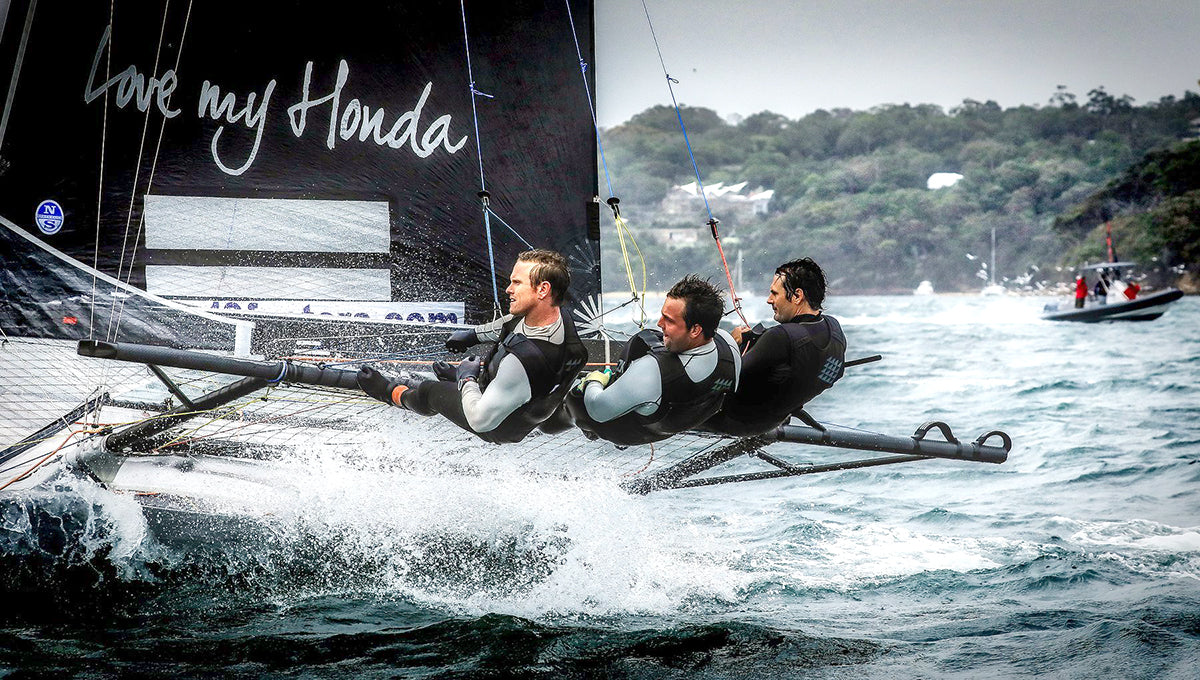
18FT SKIFF SPEED READING
18FT SKIFF SPEED READING
3x World Champion Matt Steven Provides Insights To Racing 18 Footers
© 18 Footers Australian League / Frank Quealey
David McDiarmid, North Sails Expert Matt Steven, and Bradley Collins (NZL) have claimed the most desired prize in the 18-footer class, the JJ Giltinan Trophy in 2018, 2019 and 2020, making them three-peat Champions in the competitive class. The 2018 win was the first time in 45 years that New Zealanders won this event, which is considered the world championship of 18-foot skiff racing. As a result of their big win in 2018, David, Matt, and Bradley were awarded Orbit World Travel Sailors of the Year at the Volvo Yachting Excellence Awards, along with Dongfeng’s 2017-18 Volvo Ocean Race winning sailors Daryl Wislang and Stu Bannatyne.
We checked in with middle crew Matt Steven about sailing 18-footers. Learn about what he has to say about choosing rigs, techniques, and how to sail an 18 to its full potential.
Crew work on an 18-footer can be challenging, especially in breeze. “We have pretty defined roles on the boat to keep consistency with boat handling,” says Matt. “It’s all about having as few crossovers as possible and not letting the boat slow down.” Crew weight also affects the technique. “I am the heaviest onboard, so it often pays to keep me out on the wire. Sometimes Brad , our bowman, gets loaded up with a few more jobs during the maneuvers. Luckily he is very fit and strong and lighter than me!”
One of the toughest things about 18’s, Matt explains, is rig choice. “You have two rigs for two wind ranges (0 -13 and 12-30 knots). However, within these ranges, there are a lot of different modes, so compromises have to be made, either at the top end or bottom end of each rig. It’s hard to have the ideal setup to cover an entire day’s worth of racing.” Though his team preferred their #2 rig, figuring out the right mode for each helped them adapt to changing wind ranges throughout each race day.
They weren’t the only ones wrestling with rig choice each morning. “There is often a standoff on the ramp,” Matt explained, as teams wait for others to make their choice. “Normally we are happy to be on the same rig as the majority of the fleet, but sometimes you just need to back yourself on the weather forecast.”
Rig tuning isn’t like other boats in the 18ft skiff. Matt explained that “the tuning tricks we have figured out ourselves over time, through practicing and spending time in the boat.” The 18ft skiff is fairly complicated, since almost every mast is custom built depending on crew weight and style, so there is not one specific guide for sailors.” Michael Coxon at North Sails in Sydney has a formula that most teams use. We have control over the rig with heel, and two sets of lower caps and primaries which we adjust accordingly as needed.”
©18 Footers Australian League /Frank Quealey
Starting line technique is pretty similar to other fleets concerning positioning and acceleration however, the 18-footer can accelerate a lot faster. “One of the hardest parts,” Matt says, “is staying stationary and holding your position. Once you lose flow over the foils, it can be very challenging to stay in control.”
Upwind and downwind techniques Matt said have similar concepts. “Body weight fore and aft, as well as knowing when to press hard are the keys to speed. Regarding tactics, staying in pressure is key… two knots of wind could make a 2-3 knot boat speed difference and a 10-degree angle change.”
Matt’s team typically replaces two or three sails a year, depending on the number of events they compete in. “We have a good relationship with our design team,” Matt says, “so we understand our gear and how to use it efficiently.” He says it’s helpful to understand shape changes, even though only minor tweaks were made for the 2018 season.
Matt’s team is sponsored by Honda, which enabled a wardrobe upgrade to 3Di for the 2019 season. This is a nice addition not only because of performance factors, but it meant they won’t need to replace sails as often. “The best thing about North Sails 3Di is that you know the shape is going to be the same each time you go sailing, and there is never a worry about structural failure. We have much confidence in the product. The added stiffness will allow us to have another dimension of rig tuning that was not available to us before. The sail controls will be more ‘tweaky,’ in a significant way.”
3Di + 18 FOOTERS
The Orbit World Travel Award came as a surprise to Matt, who was just happy to win the JJG Worlds, as it has been his primary goal since he started sailing 18-footers.
“We were very honored to be recognized alongside some amazing sailors for the Orbit World Travel Award. We are just normal guys who work day jobs that try and fit in as much training and sailing into our normal life. We have a desire to keep the trophy in New Zealand and make our fellow skiff sailors proud. We are happy to win for them, as well as ourselves and the New Zealand sailing community.”
CONTACT MATT ORDER SAILS NOW
© 18 Footers Australian League / Frank Quealey
READ MORE
READ MORE
